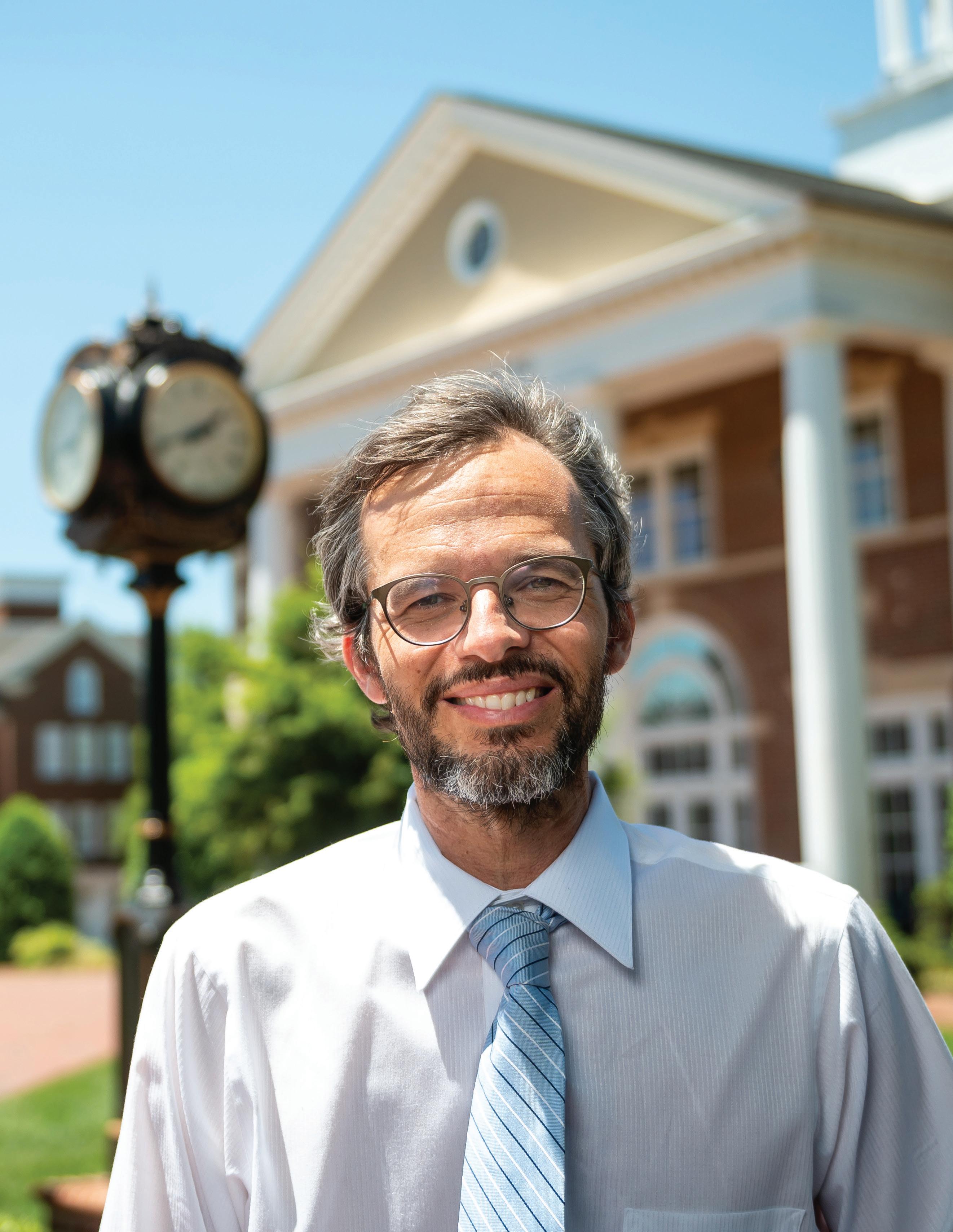
2023
The
2022 RUTH RIDENHOUR SCHOLARLY AND PROFESSIONAL ACHIEVEMENT AWARD RECIPIENT
Dr. Samuel Whitt
EDITORIAL TEAM:
Dr. Virginia Leclercq, Chief Editor, School of Humanities and Behavioral Sciences
Dr. Claire Lambert, Stout School of Education; Dr. Aurijit Sarkar, Fred S. Wilson School of Pharmacy; Dr. Cynthia Hanson, Phillips School of Business; Dr. Pamela Lundin, Wanek School of Natural Sciences; Dr. Lance Mabry, Congdon School of Health Sciences; Dr. Brandon Lenoir, Nido R. Qubein School of Communication; Dr. John Turpin, David Hayworth School of Arts and Design; Dr. Eve Klopf, Webb School of Engineering
HIGH POINT UNIVERSITY CHIEF ACADEMIC OFFICERS:
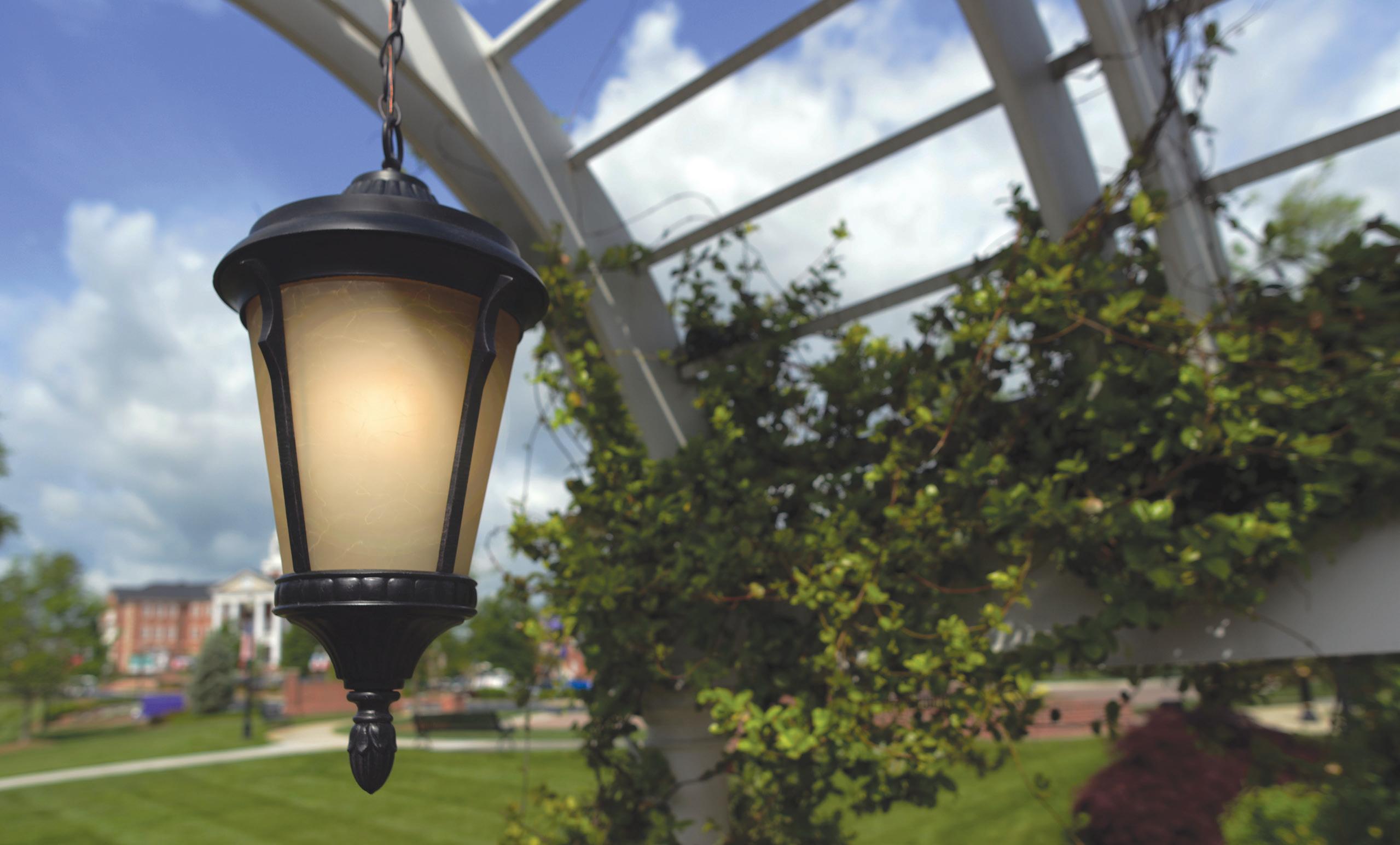
Dr. Nido R. Qubein, President
Dr. Daniel Erb, Provost and Senior Vice President of Academic Affairs
Dr. Angela Bauer, Vice President of Academic Affairs
Deans: Dr. Brian Augustine (Interim), Wanek School of Natural Sciences; Mr. Ken Elston, School of Humanities and Behavioral Sciences; Dr. Kevin Ford, Congdon School of Health Sciences; Dr. Daniel Hall (Interim), Phillips School of Business; Dr. Amy Holcombe, Stout School of Education; Dr. Mary Jayne Kennedy (Interim), Fred S. Wilson School of Pharmacy; Dr. Ginny McDermott, Nido R. Qubein School of Communication; Dr. Michael Oudshoorn, Webb School of Engineering; Dr. Scott De Rossi, Workman School of Dental Medicine; Dr. John Turpin, David Hayworth School of Arts and Design
2 The Lighted Lamp | 2023
The mission of High Point University is to deliver educational experiences that enlighten, challenge, and prepare students to lead lives of significance in complex global communities.
The

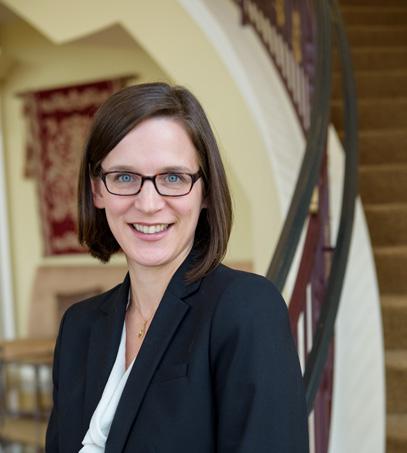
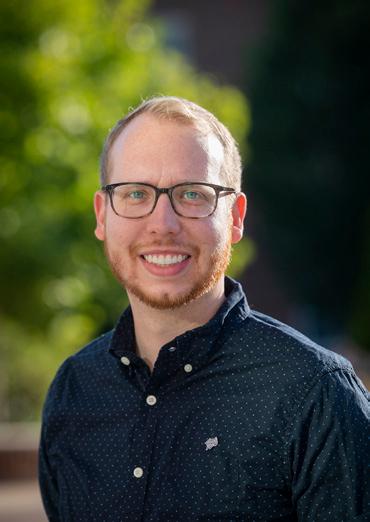
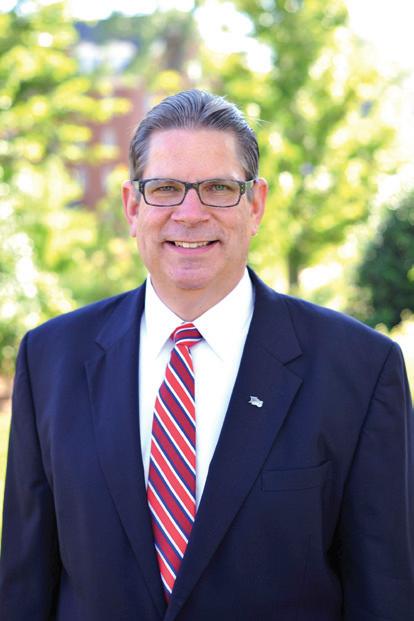
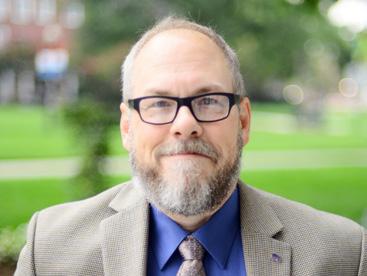
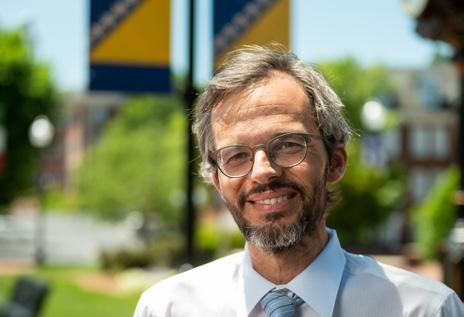
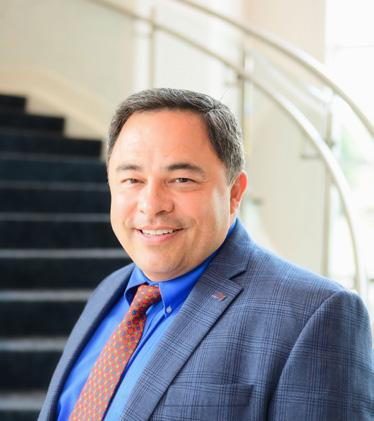
3 www.highpoint.edu A Selection of Faculty Scholarly Works 38 This Research Is Brought to You by Letters: C, O, O, N, E, and Y 26 The Eye Lens as a Model 32 The Dean’s Corner 5 6 Nurturing and Navigating Research 14 Kurinuki as Creative Meditation 22 TABLE OF CONTENTS
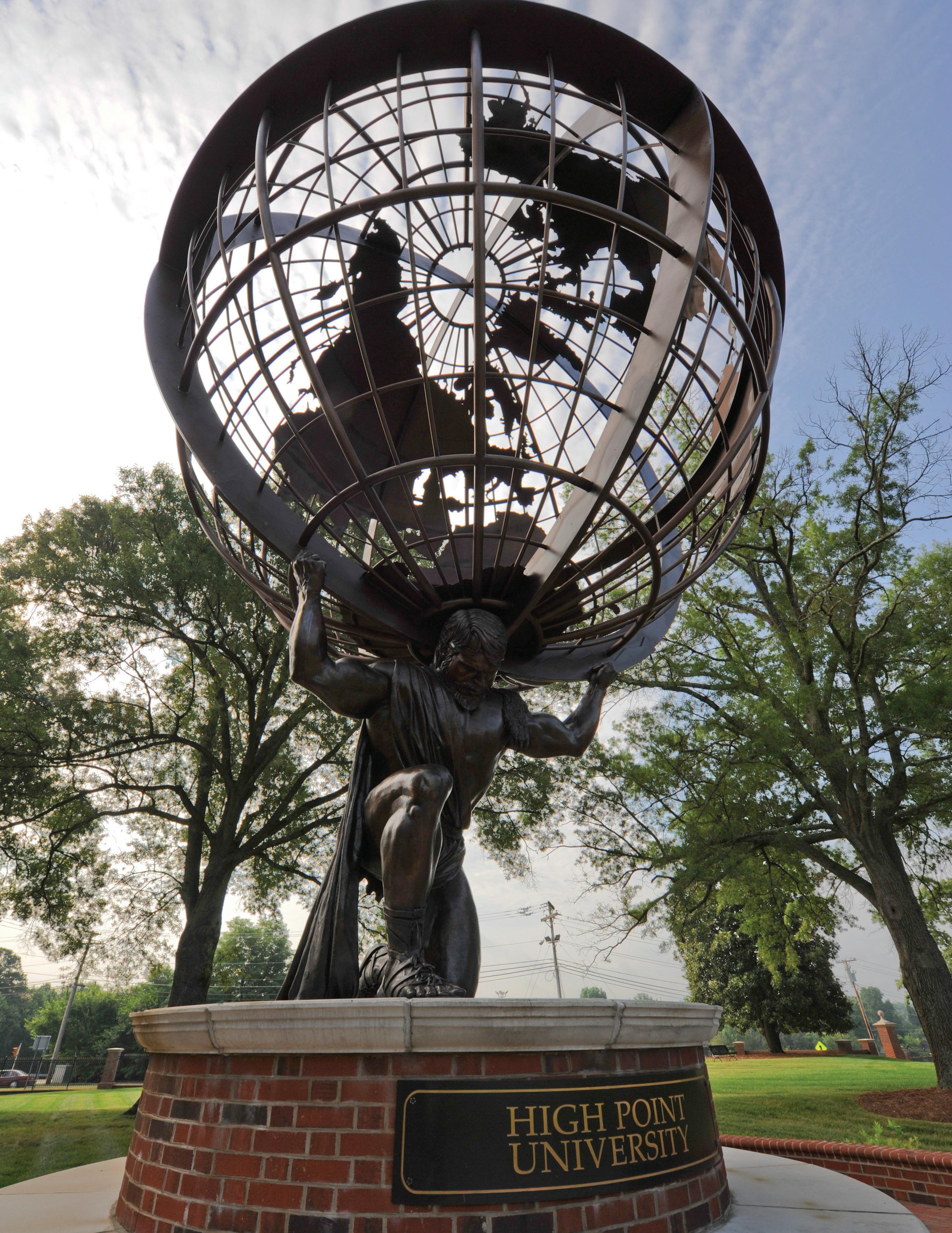
FROM THE PROVOST A MESSAGE
Dear Colleagues and Friends of High Point University,
I am pleased to share with you the ninth edition of the Lighted Lamp. At High Point University, inquiry, exploration, innovation, advancing science, and establishing creative works for the greater good of society is part of who we are. Our nationally and internationally recognized faculty are master educators, accomplished artisans and researchers, and expert clinicians. Through their expertise, commitment to excellence, and awareness of the needs of tomorrow, they impact society in meaningful and significant ways. Through their student-centered holistic approach to education, our faculty lead by example and our students have successful role models to emulate.
As an engaged university in which innovation thrives, we embrace the challenges and opportunities to creatively solve complex problems and express creativity in unique and meaningful ways. Our faculty not only create inspirational works, relevant scientific breakthroughs, and advance scholarship in the humanities but also create an esprit de corps with students who are our future artisans and scientists who will lead us to improve the communities in which we reside. Faculty and students collaborate and contribute in important ways to the growing body of knowledge in a variety of disciplines and creative works in the arts and humanities.
The accomplishments in this issue of The Lighted Lamp highlight the scholarship of our faculty as teacher-scholars. As you read the articles regarding research and creative works in this issue, please know that what you are reading about is only a small sampling of the work that our faculty contributes to scientific, humanities, and creative arts disciplines. I invite you to contact our faculty directly should what you read pique your interest. Who knows where your inquiry may lead?
Sincerely,
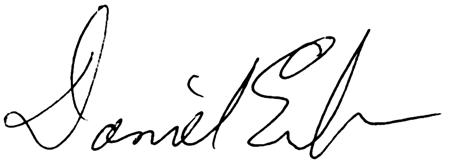 Daniel Erb, PT, Ph.D. Provost
Daniel Erb, PT, Ph.D. Provost
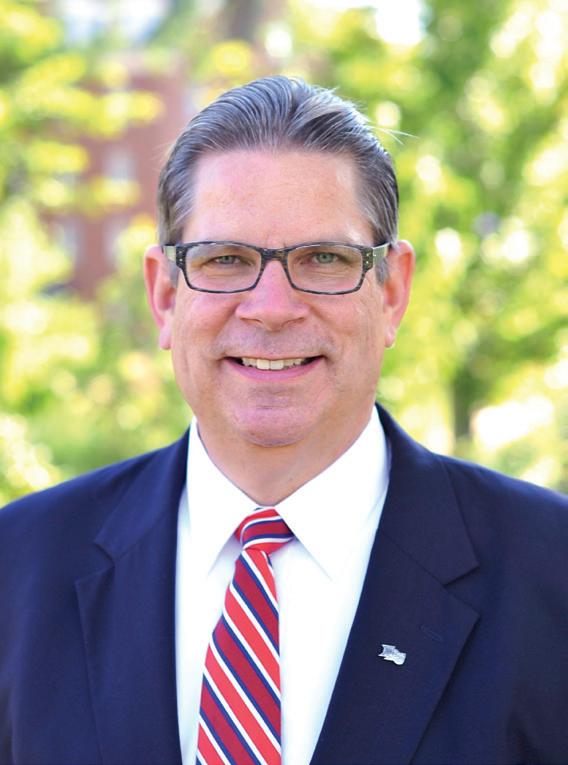
5 www.highpoint.edu
THE DEAN’S CORNER
Mr. Ken Elston Dean of the School of Humanities and Behavioral Sciences
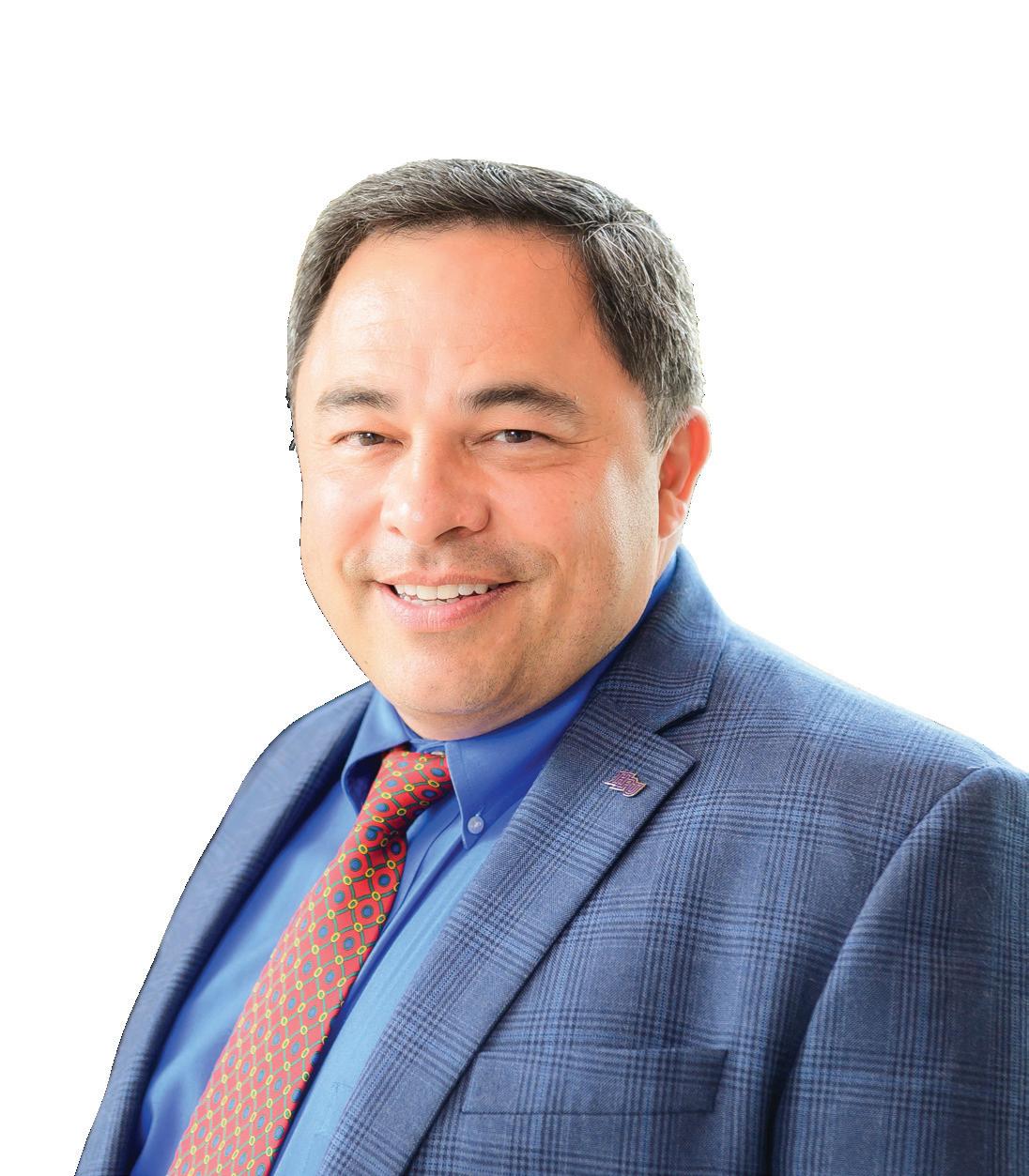
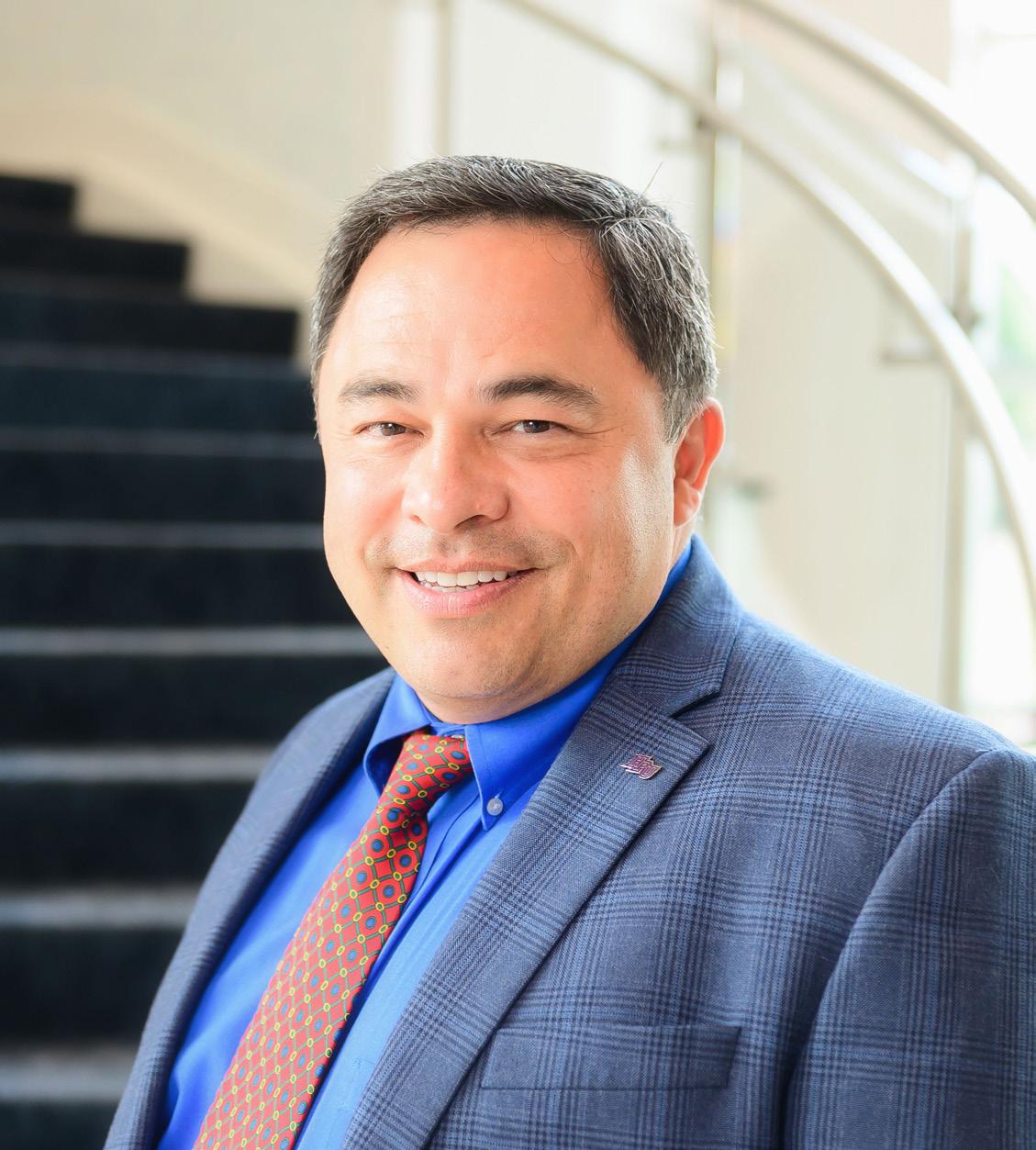
A RENAISSANCE DEGREE PREPARES STUDENTS
For 100 years, High Point University has honored its founding commitment to empowering individuals with extensive knowledge and transferable skills, while cultivating social responsibility in the context of articulated and applied ethics and values. As the University’s home for essential disciplines of human knowledge, the School of Humanities and Behavioral Sciences embodies the liberal arts philosophy of education and the complementary values of reason, tradition, experience, and service.
A well-rounded education provides a foundation for personal growth and lifelong learning. Pursuing knowledge in the humanities and social sciences positively influences society and enhances
our individual lives. It helps us unravel the unpredictable, dynamic, contradictory, and paradoxical complexities of being human. As the liberal arts heart of the University, the School of Humanities and Behavioral Sciences offers unlimited opportunities for exploring the human condition. It lies at the core of the student curricular journey, quite literally, and embodies High Point University’s dedication to God, Family, Country. The School of Humanities and Behavioral Sciences promotes critical reflection, ethical deliberation, and aesthetic appreciation, which are the specific qualities most referenced by those seeking to understand the divine. Our students apply themselves in various disciplines, honing skills in research, creativity, critical thinking, leadership, collaboration, writing, and
6 The Lighted Lamp | 2023
THE LIBERAL ARTS WAY OF LIFE: A PEEK INTO THE SCHOOL OF HUMANITIES AND BEHAVIORAL SCIENCES AND FOR THE NEXT CENTURY
HOW
communication, including language learning and persuasive speech, and become part of a family of learners. Not only do these skills help students excel in their chosen careers, but they also create informed and critical citizens, who are vital to a flourishing democracy.
Windows Into Our World: General Knowledge
Undergraduate students, regardless of major, have the exciting opportunity to explore a breadth of experiences in a variety of disciplines. The School of Humanities and Behavioral Sciences delivers about 63% of the university’s general education core. Through our majors and minors in humanities and social sciences, as well as in pre-professional programs in law and ministry, students delve to great depths of knowledge and applied meaning along their journeys from a fixed to a growth mindset. This approach to learning prepares students for reflective action in an interdependent and diverse world. We understand and respect the unique talents and perspectives of all individuals and embrace and utilize their contributions. Our scale of inclusiveness creates a path by which all individuals can achieve their highest potential in an increasingly multifaceted and pluralistic society. The School of Humanities
and Behavioral Sciences endorses dynamic curricula and research agendas that include a multiplicity of views and perspectives. Our University’s continued success rests in our collective ability to embrace a multitude of opinions, ideas, and beliefs so that we can effectively educate the next generation of culturally responsive, knowledgeable, and globally engaged leaders. These are the very concepts upon which our nation was built, and our commitment to diversity, equality, and inclusion cultivates students’ desire for citizenship in intricate global communities.

The notion of a university is an old one. In the middle ages, stadium generalia referred to both the places of general learning and the act itself. A university has always been a place open to learners from far and wide, specifically a place at which a consideration of the value of studying included an assumption of both a broad range of material and a great faculty to teach it — the masters of learning who could guide students along their intellectual journeys. University teaching stands as one of the oldest learned professions, and the faculty of High Point University’s School of Humanities and Behavioral Sciences carries on that noble tradition brilliantly. While 22% of High Point University’s student population majors in the School of Humanities and Behavioral Sciences, 100% of the student body have the opportunity to develop fundamental knowledge and expertise with our faculty.
Our faculty help students learn to read, analyze, and interpret complex texts and ideas. This develops useful life skills like critical thinking, problem-solving, and decisionmaking. Students learn to critique opinions and arguments, while carefully presenting their own, making “outside-the-box” thinking (another valued life skill) possible. Whether it’s understanding what goes into making creative work, the evolution of humankind, or the development of different languages, the humanities and social sciences help us understand the world and connect with other people effectively.
7 www.highpoint.edu
Foundational Preparation: An Investment in the Future
A better understanding of the world is a good outcome, and the increased employability of someone able to interact well with others is a statistical reality. Degrees in Humanities and Behavioral Sciences equip students with highly transferrable and desirable skills that can be useful for a variety of industries. Employers report a desperate need for employees who can organize their thoughts and synthesize scattered information into a coherent story, as well as communicate fluently, intelligently, and persuasively. If standardized testing for graduate school admissions is any measure, the disciplines in the Humanities and Behavioral Sciences, which excel at helping students become better writers and verbal reasoners, equip students to achieve their goals. Better student GRE scores represent some proof of the power of our majors; another point of pride is represented in measures of Return on Investment [ROI]. A Georgetown University study found that the median return on investment in a liberal arts education 40 years after enrollment is close to $1 million, which is 25% higher than the median gain for other schools. This study underscores the importance of an excellent faculty, specifically, the tremendous work being done with our students in undergraduate research and creative works, as the only schools beating the liberal arts for ROI are graduate research programs. Of course, there is further value: exceptional discernment and knowledge that are built through research-based scholarship; the contextual exploration of global cultures and cultural history forming the foundations of freedom of thought; and the wisdom inherent in intellectual autonomy and individual independence. Studies in the liberal arts inspire travel and a passion for continued learning. The study of humanities and social sciences helps to promote empathy and understanding of different cultures, perspectives, and experiences. This is particularly important
in a diverse and interconnected world where it is essential to be able to relate to and communicate effectively with people from different backgrounds. This worldview building is part and parcel of understanding and appreciating different aspects of human experience. Our students can appreciate and respect alternative perspectives, even with sincere disagreement, as they gain empathy, which benefits our students while creating a more compassionate and harmonious society overall. By their very nature, these disciplines mitigate hate and a sense of otherness; thus, they protect against ignorance, fear, and misunderstanding. For example, by studying philosophy, politics, and the past, we learn about what worked well and, just as often, what did not work to improve human interaction. Learning from our mistakes across the course of history helps us discover new ways of improving the world.
Mentoring Students to Think, Feel, and Act: Creating Experiences That Matter
Our faculty guide students through highimpact practices that challenge them to consider not only how to solve problems but also how to identify which problems need to be solved and why. Our faculty are subject matter experts, who explain in the context of experiential learning, what academic mastery does. They translate a belief in the academy’s traditions of debate, inclusion, and seeking the truth, representing a remarkable tradition of hope in a world divided by political unrest, religious conflict, and economic injustice. Because of the excellence in the School of Humanities and Behavioral Sciences, we do not have to imagine a university community that challenges us to express enthusiastic, hopeful engagement and inspire action, empowering the members of our community, students and faculty alike, to explore questions of vocational discernment, social justice, and personal growth, even in the face of cultural division and despair. This vibrant intellectual community is critical for marrying new and creative ideas to a long
8 The Lighted Lamp | 2023
and honorable tradition of educating the next generation of visionary community leaders. This commitment is reflected in our School’s mission statement:
Together, Humanities and Behavioral Sciences faculty and students work to bring practicality, imagination, and depth to how we think, feel, and act. The faculty of Humanities and Behavioral Sciences unites diverse disciplines that generate new research, scholarship, and creative expression concerned with how and why shared human experiences matter. That work forms the basis of our innovative teaching and mentorship and of our commitment to discovering durable, practical ways to create and share knowledge about ourselves and others. Our methods instill curiosity, awareness, and resilience as core habits. These habits are foundational to the creative problem-solving, logical reasoning, and clear communication necessary for finding significance and success within a strong ethical framework, now and in a dynamic future.
Achieving great depth in thinking, feeling, and acting supports an extremely practical approach to living in this world. Classes in the School of Humanities and Behavioral Sciences develop the whole person and the kinds of skills and habits of mind that will not only prepare students for their first jobs but will also prime them for a lifetime
of career success. Our students create the foundation for a well-lived life by welcoming an intellectual curiosity predicated on the belief that the undergraduate college experience is best when it becomes a story of transformation and the realization of potential. While developing superior skills to masterfully couple self-reflection with looking outward, our students build facility with an internal/external dialectic inherent to such transformation. We know that our students are inspired to achieve greatness, imbued with thoughtfulness, resourcefulness, and social responsibility, and are ready to pursue the common good, as skilled communicators, collaborators, creative thinkers, and lifelong learners.
We treasure our mentoring relationships with our students, fostering deep engagement with faculty who are focused on student growth and success and who accentuate the connections among academic disciplines. Our classes and programs prepare students for the future by teaching skills that will be relevant in 100 years, not just those needed next year. Rather than prepare for jobs that will be obsolete in ten years, we are looking to the next century in building career readiness. Because we examine the innovative ways in which we teach, we can aver, with confidence, that “our methods instill curiosity, awareness, and resilience as core habits.” We also demonstrate that our students’ imaginations are inspired. One example of this is our literary
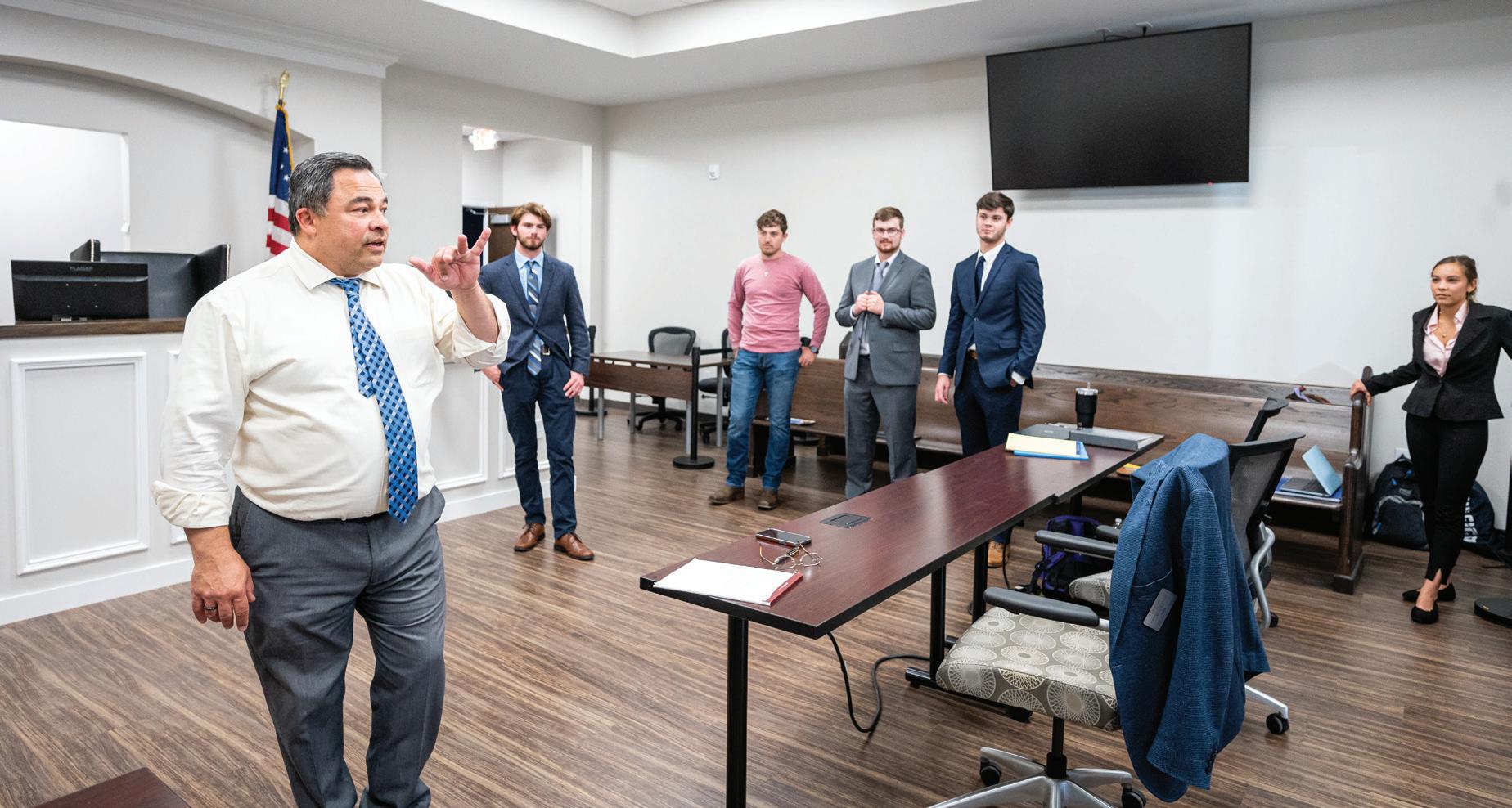
9 www.highpoint.edu
journal, Apogee Apogee curates poems, stories, creative nonfiction, and artwork by High Point University students and faculty members. There are many ways in which the English Department encourages students to harness the power of language to promote personal and societal change through an array of courses and extracurricular experiences in creative and professional writing, rhetorical and literary criticism, publishing, and, as a practical resource for all students, in the Writing Center. English students and faculty are inspiring High Point Public School students to greater heights through the Community Writing Center, furthering the durable and practical impacts of sharing expertise. This program has expanded to support academic achievement from elementary to high schools, while also lessening food insecurity in our city.
Experiential Learning and Extraordinary Study Spaces
The School of Humanities and Behavioral Sciences is highly interdisciplinary and multifaceted, woven into the fabric of the University’s academic mission, and there are many initiatives and high-impact practices in play every day. For example, in our largest major, psychology, students focusing on brain-behavior relationships are conducting research side-by-side with faculty. Our criminal justice students benefit from the crown jewel of that department — our 9,000-square-foot “Learning Lab” — an experiential learning facility containing four separate mock crime scene rooms, an “Evidence Processing Area” for instruction in the analysis of evidence collected from crime scenes, a tactical “Law Enforcement Learning Area,” in which students learn procedural imperatives, and a courtroom where students learn by participating in all the stages of mock trials. Many students in our challenging political science and international relations curriculums examine “Power and Politics in DC” behind closed doors in the nation’s capital. The active polling institute for social research, our Survey Research Center, provides students with
experiential learning, as it generates data that feeds further research and scholarship while producing valuable media coverage for the University. The interdisciplinary legal studies minor, housed in political science, prepares students for many aspects of careers in the legal system through field study, guest speakers, and targeted career planning. The sociology and anthropology combined major, emphasizing both theoretical and applied traditions, also houses interdisciplinary, pre-professional minors, like forensic studies, and brings students to field studies in Guatemala, Peru, and elsewhere. Understanding the world, understanding ourselves, and discerning how to live lives of consequence are consistently applied goals in our school.
All of our majors have excellent student outcomes. It is gratifying to note that of the 41% of our 2020 and 2021 religion and philosophy graduates are now in graduate school or have already completed a master’s degree, and that 42% of those were awarded full scholarships for their graduate programs. These include seminarians who won scholarships to Duke, Vanderbilt, and Wake Forest University Divinity Schools, as well as Princeton Theological Seminary. Besides rigorous and holistic investigation of humanity’s biggest questions about God and faith, about truth, beauty, and goodness, the Department of Religion and Philosophy weaves vibrant and life-changing conversations into classes, corridors, and in chapel. The interdisciplinary Jewish studies minor engages the texts and practices that provide the contexts through which Jewish identity has developed, and the ways in which Jewish tradition is interpreted and applied. And the social innovation minor engages those who understand complex social challenges and work to know how to make change happen.
Of course, both faculty and students in history have a similar passion for scrutinizing the past and present and projecting the
10 The Lighted Lamp | 2023
future. History faculty regularly interact with students in class and through student-led social organizations such as the History Club and the Historical Gaming Society. The department also hosts internationally and nationally renowned scholars each year in our American Discoveries Series and the Gunther Rothenberg Seminar in Military History, and, like many of our programs, the History Club is open to all HPU students, in this case, those who have an interest in learning about the past. Faculty-directed cultural clubs, which include students studying French, Italian, and Spanish, as well as Chinese and East Asian Studies, have vibrant language tables and film and cultural activities that allow students to build community and apply their language skills in relaxed settings. These opportunities within the Department of World Languages, Literatures, and Cultures are also open to all students who wish to cultivate proficiency and skills in world languages for a competitive and rapidly changing world.
There are many ways in which our students can gain an edge in today’s competitive job market. Many of our students seize the opportunity to study abroad, offer community service, and take advantage of scholarships, fellowships, and global internships. We strongly encourage language students to
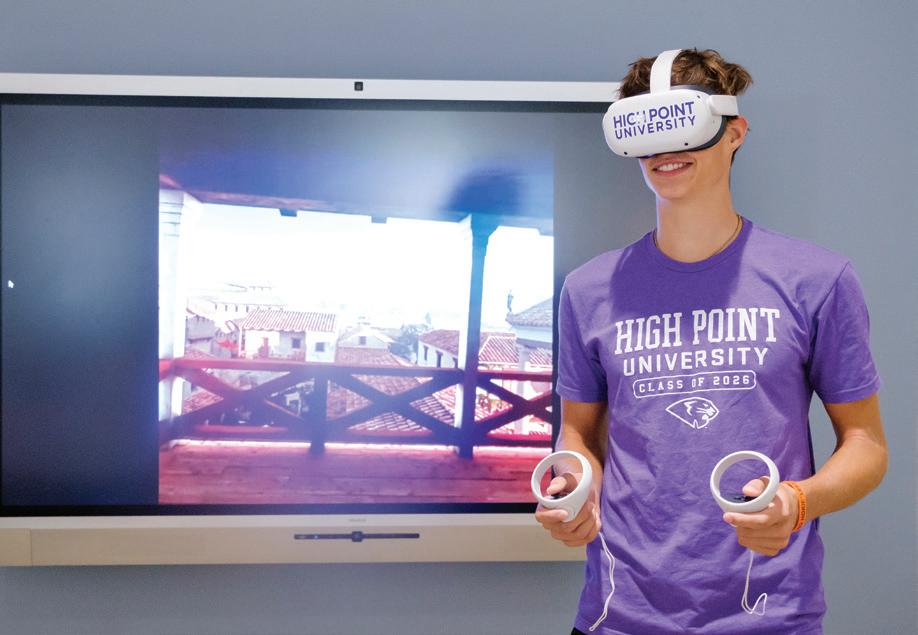
continue their studies abroad for a semester or a year, where they can participate in homestays and engage in intensive language study in countries in Latin America, Europe, and Asia. Our students are also studying history, politics, literature, languages, and culture abroad. Some of our graduates have furthered those experiences with overseas employment. For instance, several students have participated in the prestigious Teaching Assistant Program in France (TAPIF) program, teaching English to French students of all ages and utilizing their learned language and cultural proficiency to great effect. And, in each subject area, honor societies connect majors with peers and growth opportunities, including making presentations at national and international conferences. Our participation in Service Learning and community engagement is exemplified by the active Community Writing Center that tutors (and provides meals for) public school students in High Point. In fact, Service Learning opportunities within our School provide our students with experiences across our community. Our students are working closely
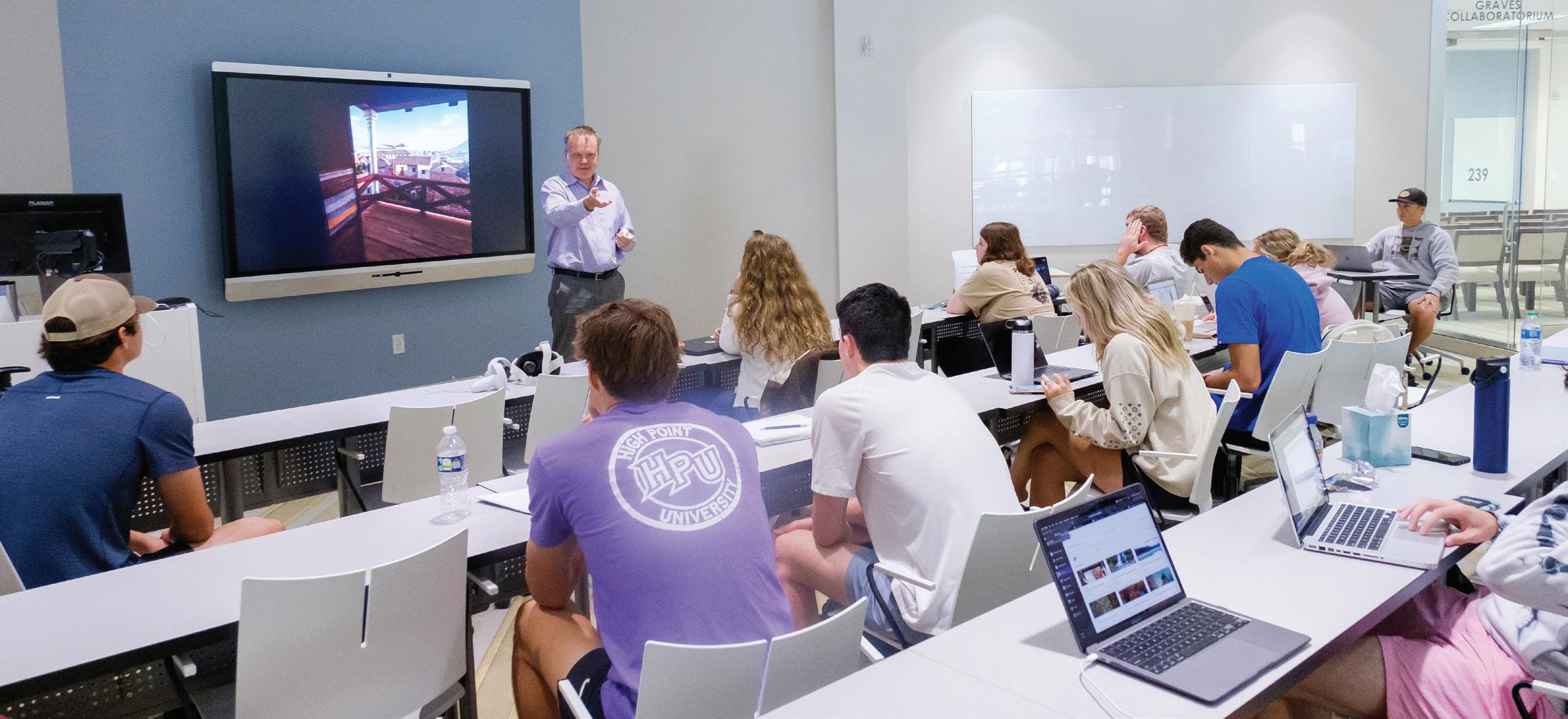
11 www.highpoint.edu
with school children attending the Nido and Mariana Qubein Children’s Museum, as well as in our community gardens, after-school and Title 1 school programs, the Family Justice Center, the Piedmont Environmental Center, Ward Street Mission, and with initiatives focused on immigrant, refugee, and at-risk populations. Our medical Spanish curriculum trains graduate students in the health sciences to communicate more effectively with their patients, and to apply those lessons in HPU’s Community Clinic, in service to our High Point neighbors in need. Studying and working with different people and cultures is a vital step to creating social justice and equality. Is it any wonder that our departments have extraordinary success in placing our students in graduate schools and professional or business careers where they apply the research, analysis, writing, and communication skills acquired from their studies?
The School of Humanities and Behavioral Sciences is known for its unparalleled level of undergraduate research and creative work. Our students publish, present at conferences and symposiums, and contribute to their fields of study in other ways. Even by just scratching the surface of the ways in which our students examine the world and their own capacity
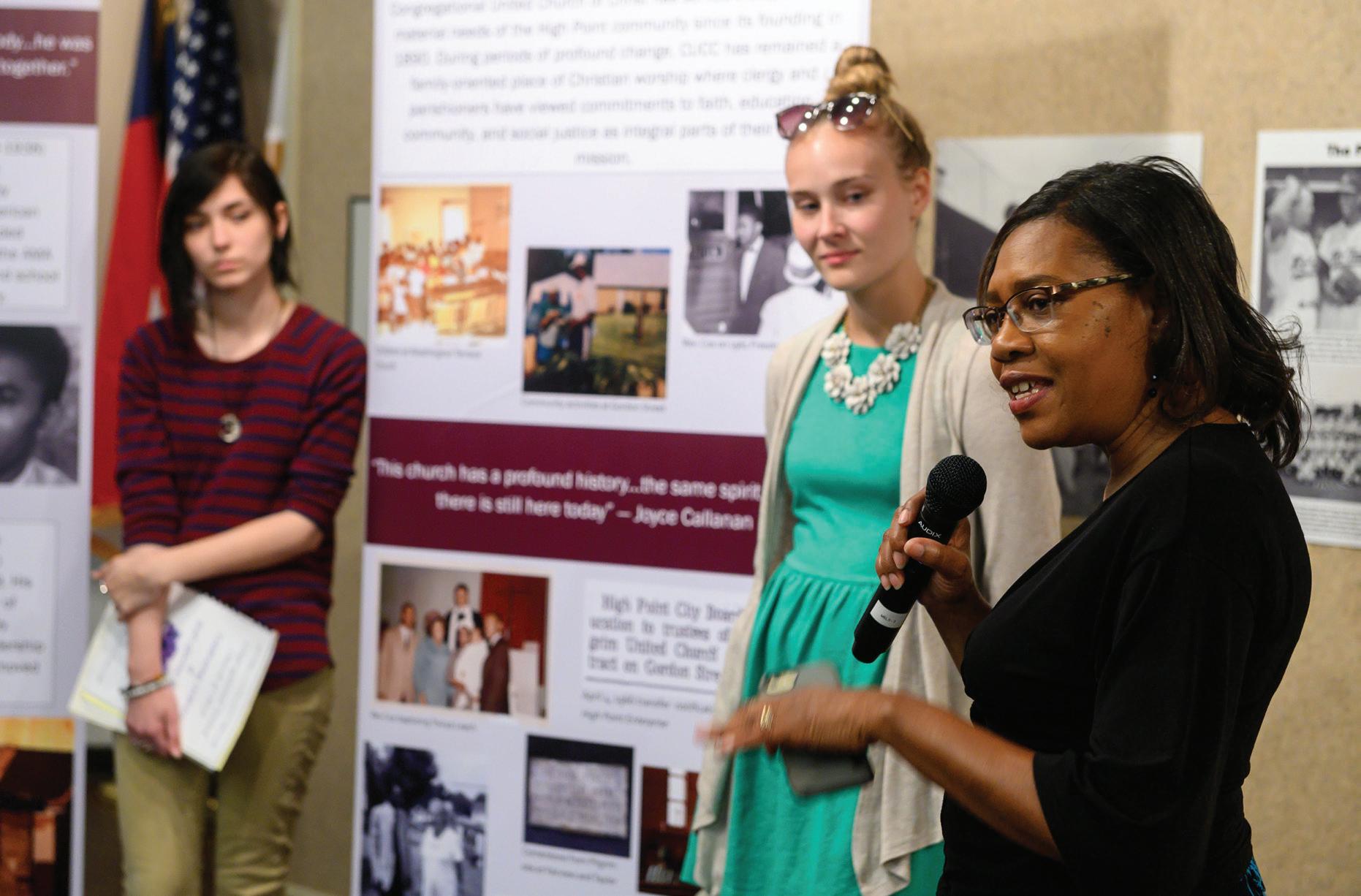
and uniqueness, one can see how they are equipped with the skills and knowledge to tackle complex personal, social, cultural, and political issues locally, nationally, and globally, and to succeed in graduate programs in a variety of fields and make significant impacts in their chosen professions.
Of course, fun and academic rigor mix constantly in the School of Humanities and Behavioral Sciences. We explore arts and literature, play historical games, compete in mock trials and ethics bowl championships, and gather for dinner clubs and guest lectures. Our faculty are creating cultural events, including film screenings, to engage the student community and build cultural and linguistic fluency. Well-being, in all its dimensions, provides the contextual language for adjustments toward a more student-centered and character-focused understanding of the transcendent work of preparing the next generation to live lives of virtue and passion, as well as to succeed academically. We trust that all of these experiences sharpen life skills of responsibility, accountability, adaptability, reasoning, analysis, and, of course, critical thinking.
12 The Lighted Lamp | 2023
The View From Here: Creating Bountiful Futures
As students explore various subjects in the humanities and social sciences, they are invited to appreciate the differences between various points of view on, as well as the framing of, life. These repeated opportunities to wander and wonder help students understand the potential applications of their own affinities in answering the big questions of identity and desire. For those embracing their experiences across the general education core, the deep impact of personal and individual agency, intentionally made possible during those early college years, leads to inevitable, transformational maturation. We want our students to reflect upon the great privilege of gaining a college education, as well as the responsibility that education invites. A college education is a vital foundation for individual flourishing, and there is no doubt that the well-being of our society demands thoughtful leaders.
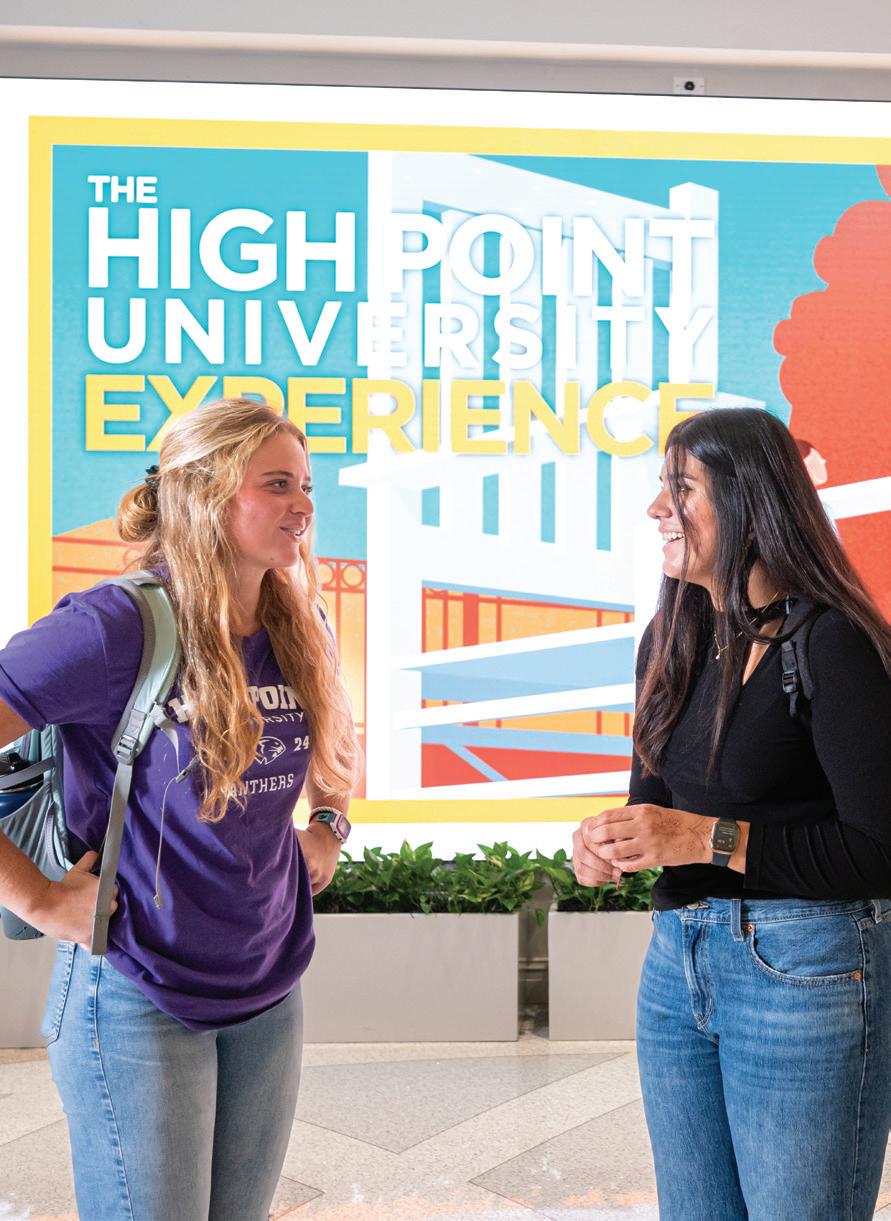
Our students become leaders and decisionmakers who can employ a broader, more diverse range of ideas and knowledge. They are better able to run businesses and government agencies and react to difficult
situations as they develop. Studying a field within the humanities and behavioral sciences involves moving beyond the search for the immediate and pragmatic; it opens our students to the examination of the entirety of the human condition and encourages them to go beyond problem-solving and fully appreciate, experience, and know themselves.
Our faculty serve as active and engaged student advisors, collaborators, and guides so that our graduates emerge from their liberal arts education transformed: inward and reflective, ready to pursue the common good, and inspired to consider and develop their own concept of a well-lived life. Encouraging students to speak up and to improve listening, reading, and research skills, our faculty instill a zeal for learning and passion for subjects, they facilitate conversations around feelings, helping students understand how changes reflect the times and what is happening in the world around them, so they understand the importance and necessity of appropriate actions to manifest a better future. Our students can identify their own growing confidence, allowing them to understand themselves as agents of change in the world and positively embrace that personal growth. As influential leaders within their own diverse fields, our faculty members enrich the cultural and intellectual life of the university with their own widely acclaimed research, scholarship, and creative work. Dr. Sam Whitt, Associate Professor of Political Science and recipient of the Ruth Ridenhour Scholarly and Professional Achievement Award, has contributed to this edition of The Lighted Lamp. His prolific research feeds into his teaching, and students consistently embrace the rewards of the academic rigor of his classes. All of our teacher-scholars partner with students in the learning process, and that makes all the difference in carrying out our promise to provide an extraordinary education, in an inspiring environment, with caring people. ❚
www.highpoint.edu
13
NAVIGATING RESEARCH
NURTURING AND IN AN EVOLVING ACADEMIC LANDSCAPE
Dr. Samuel Whitt Associate Professor of Political Science, School of Humanities and Behavioral Sciences

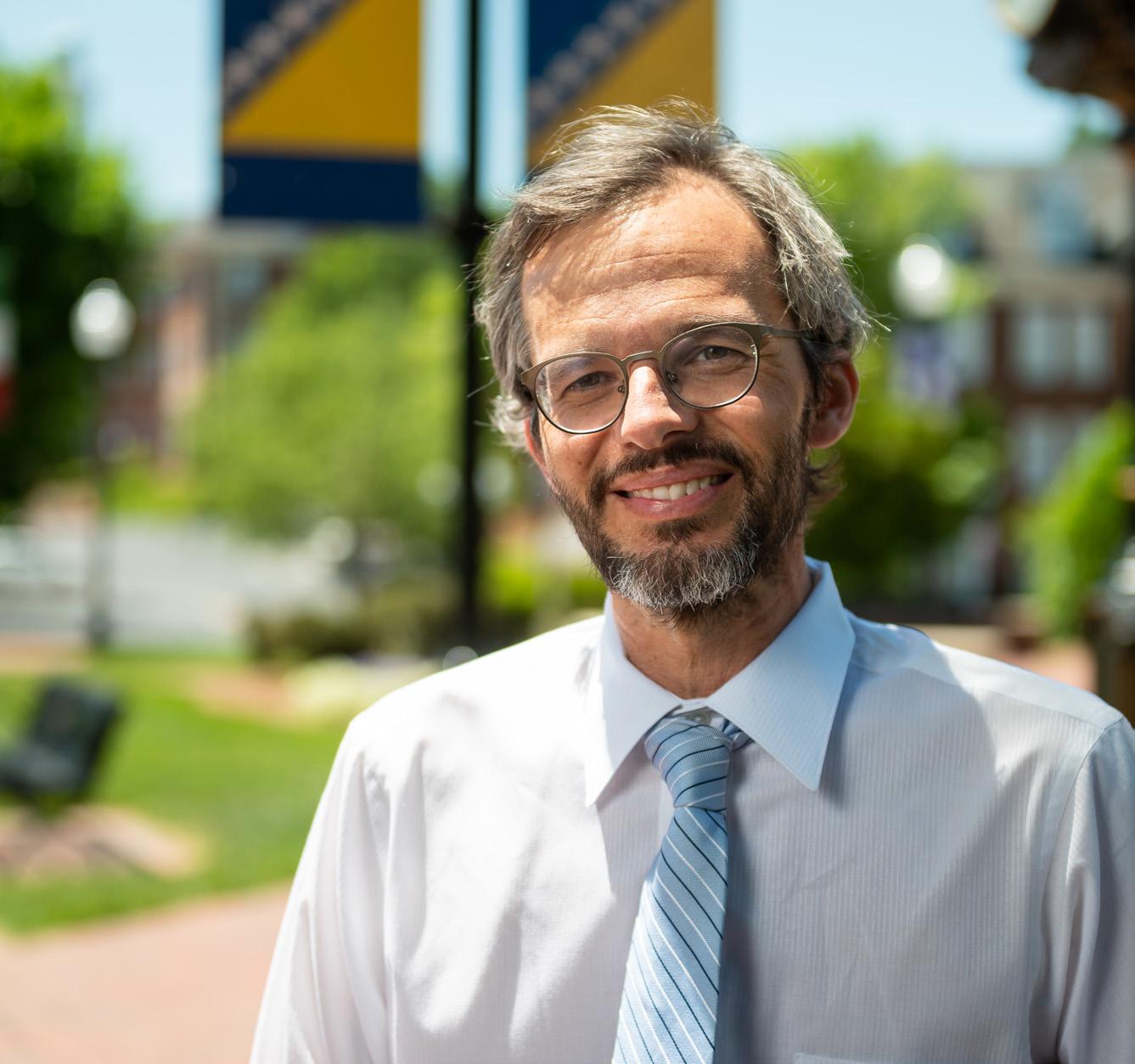
I am grateful to High Point University for being honored with the 2022 Ruth Ridenhour Scholarly and Professional Achievement Award. I first came to High Point in 2012. Since then, HPU has experienced tremendous growth as an institution, navigating challenges not only in higher education but also across the past decade’s terrain of political and public health turmoil. I also experienced many trials, professional and personal, during this time, and I want to use this essay as an opportunity to convey to our HPU faculty and scholarly community how research can serve as a path not only for professional advancement but also for enriching our lives as educators. I provide a brief narrative of my past and current research interests and conclude with some advice for others navigating early-career challenges of building sustainable research agendas.
My research uses experimental and survey methods to study conflict and find ways to overcome inter-group tensions in divided societies. Most of my research over the past decade has involved work related to Europe, Eurasia, and the Middle East, though I have devoted more attention to troubling political polarization in the United
States in recent years as well. I am especially interested in questions related to intergroup cooperation after conflict, long-term legacies of violence, and attitudinal and behavioral change over time. This research agenda has been an evolving process, and I highlight several key phases beginning with my dissertation, early career research, and forays into government service before ultimately finding my academic career path at HPU.
Building on the Dissertation
I completed my Ph.D. in political science at Vanderbilt University in 2005. Before beginning my dissertation, I spent two years as a Watson Fellow and then as a Fulbright Scholar conducting largely qualitative fieldwork in the Balkans and Eastern Europe on issues of ethnicity, religion, and nationalism and acquiring language skills. My first quantitative field research experience was as an assistant to a major National Science Foundation-funded survey and experimental project in Russia. I spent a semester in Russia as a high school exchange student in 1993, and another summer as an election monitor in 1996, and I was eager to go back and put my language skills and political science training to work in
14 The Lighted Lamp | 2023
the field. In 2002, I helped conduct a series of behavioral experiments with ethnic Russians and Tatars in Tatarstan and Yakuts in Siberia. Based on this experience, I decided to apply similar experimental and survey research methods to the study of ethnicity and conflict for my dissertation, focusing on the case of post-war Bosnia.
My interest in Bosnia was also motivated by my time in the former Yugoslavia as a Watson Fellow and Fulbrighter when I first traveled to Bosnia in the late 1990s. My dissertation, entitled “Beyond Keeping the Peace: Can Institutions Promote Trust and Cooperation after Violent Conflict?,” examined prospects for inter-ethnic cooperation in postwar Bosnia using behavioral experiments. My dissertation research was funded by a National Science Foundation doctoral dissertation grant and a Fulbright-Hays award, and I have published my dissertation research in the American Journal of Political Science, Journal of Conflict Resolution, Europe-Asia Studies, and Political Behavior 1 Topics included in these research papers addressed the impact of institutions, both domestic and international, on interethnic trust and cooperation as measured by behavioral experiments. I also replicated my original dissertation research to examine the evolution of social norms in Bosnia a decade later. This manuscript, published in the Journal of Peace Research, addressed how dynamics of cooperation and conflict often co-evolve over time.2 Looking back, my research has consistently grown and
developed along the path I set out on with my original dissertation.
Early Career: From Dissertation to Research Program
Since completing the dissertation, I applied my experimental field research methods to other conflict settings. For example, I had an ongoing interest in traveling and conducting research in former Soviet regions of Central Asia. In 2010, I examined the lasting effects of Tajikistan’s 1992-1997 civil war on foundations for civil society, democratization, and market development. I published an article from this research in the Journal of Economic Growth, which highlighted the detrimental effects of conflict on interpersonal trust and market development.3 After Tajikistan, I went back to more familiar territory in the former Yugoslavia to replicate my Bosnia research in neighboring Kosovo, a site of major ethnic and civil conflict in the late 1990s. I secured another Fulbright fellowship to Kosovo, where I conducted experimental research on relations between ethnic Albanians and Serbs. Many of the experiments I ran are adaptations and innovations from my earlier dissertation work in Bosnia. One article from this research in the Journal of Experimental Political Science examines “the contact hypothesis” for overcoming inter-group tensions in Kosovo.4 Another article in the Journal of Conflict Resolution explores whether international peacekeeping forces can promote “positive peace” among former rivals. I also published in the British Journal of Political Science on the long-term effects
1See respectively: Sam Whitt and Rick K. Wilson, “The Dictator Game, Fairness and Ethnicity in Postwar Bosnia,” American Journal of Political Science 5, no. 3 (2007): 659-668; Sam Whitt, “Social Norms in the Aftermath of Ethnic Violence: Ethnicity and Fairness in Non-Costly Decision Making,” The Journal of Conflict Resolution 58, no. 1 (2014): 93-119; Sam Whitt, “Institutions and Ethnic Trust: Evidence from Bosnia,” Europe-Asia Studies 62, no. 2 (2010): 271-292. Douglas Page and Sam Whitt, “Beyond Keeping the Peace: Can Peacekeepers Reduce Ethnic Divisions After Violence?,” Political Behavior 42, no. 1 (2020): 213-238.
2See Vera Mironova and Sam Whitt,“The Evolution of Prosociality and Parochialism after Violence,” Journal of Peace Research 53, no. 5 (2016): 648-664.
3See Alessandra Cassar, Pauline Grosjean, and Sam Whitt, “Legacies of Violence: Trust and Market Development,” Journal of Economic Growth 18, no. 3 (2013): 285-318.
4 See Vera Mironova and Sam Whitt, “Ethnicity and Altruism After Violence: The Contact Hypothesis in Kosovo,” Journal of Experimental Political Science 1, no. 2 (2014): 170-180.
15 www.highpoint.edu
of victimization by violence on social norms in Kosovo and in the Journal of Peace Research on how minority status can inhibit cooperation with ethnic majorities on mutually beneficial public goods.5 The Tajikistan and Kosovo projects were important to building a sustainable research agenda based on the foundations of my dissertation. It was also during this time that my first child, Henry, was born. A second child, Andrew, arrived a few years later, and so while my freewheeling days of travel were ending, my exploration of research topics around the world was evolving in new and innovative directions.
Time in Government
Following the completion of my Fulbright fellowship in Kosovo in 2011, I spent a remarkable year in the Bureau of Intelligence and Research at the State Department designing survey research projects in Europe and Eurasia, analyzing data, traveling, and consulting policymakers on changes in public opinion. The State Department gave me extensive time and resources to explore topics and methods

that I would never have been able to do (or afford) on my own. It was an exciting, eye-opening experience working within the government and the various research, policy, and intelligence communities. I often relate my government experience to students in my teaching and help them understand linkages between academic work and the policy community. I also tell them that working for the government is demanding, and, as a new parent, I was looking for more independence and flexibility that one can only find in an academic career. High Point University provided that opportunity.
A Career in Research at HPU
In 2012, I was offered a position as an assistant professor at High Point University with an emphasis on international relations and comparative politics. I embarked on new research projects using start-up research funding generously provided by HPU. My first major project involved the Syrian civil war. Like many scholars, I was first encouraged by the potential opening of the Middle East to democracy through the Arab
16 The Lighted Lamp | 2023
5 See respectively Vera Mironova and Sam Whitt, “Social Norms, Conflict Exposure and Victimization by Violence: Experimental Evidence from Kosovo,” British Journal of Political Science 48, no. 3 (2018): 749-765; Sam Whitt, “Ethnic Trust, Minority Status, and Public Goods in Ethnically Divided Societies,” Journal of Peace Research 58, no. 6 (2021): 1239-1255.
Spring movements but then horrified by the violence of the escalating Syrian civil war. Few scholars at the time were actively engaging in research during real-time conflict, and an opportunity presented itself to try something new. With the help of a brave journalist inside Syria and a remarkably resourceful and innovative graduate student, we completed an ambitious experimental and survey research project inside rebel-controlled territory of Syria with Free Syrian Army fighters, Islamist groups, civilians, and refugees to better understand motivations for civil war participation, mobilization for violence and refugee flight. My research on rebel group mobilization in Syria was published in the Journal of Peace Research, Journal of Conflict Resolution, and International Studies Quarterly 6
Building on the success of the Syria project, I relied on a similar field research method, working with local journalists to conduct field studies of military mobilization in Eastern Ukraine in 2014. I had traveled to Ukraine as a teenage exchange student in Russia in the early 1990s, and I was well aware of tensions and disputes between Russia and Ukraine in the aftermath of the Soviet collapse, which escalated as Ukraine moved increasingly away from Moscow’s influence and orbit, culminating now in Russia’s brutal invasion of Ukraine. My studies on risk-taking, military mobilization, and Ukrainian-Russian interethnic tensions, have been published respectively at the
Journal of Peace Research and the Journal
of Economic Psychology. 7 Both the Syria and Ukraine projects mirror my dissertation research in that I am using experimental and survey methods to study how conflict affects in-group/out-group cooperation. The major change is that I am now looking at how social norms are transformed in real time as conflict is ongoing. At present, I have just completed data collection from new surveys in Ukraine, which focuses on the effects of Russia’s 2022 invasion on Ukrainian and Russian identity and inter-group cooperation as the conflict is ongoing.
A spring 2018 sabbatical also provided me with time and funding to explore new topics and revisit others. During that sabbatical time, I returned my focus to Bosnia, developing new research projects on wartime sexual violence, an understudied topic in Bosnia’s civil war. One manuscript on public support for survivors of wartime sexual violence in Bosnia was published in the Journal of Conflict Resolution, highlighting the particular challenges of male survivors of sexual violence to achieve public recognition and support due to social stigma.8 I also explored new postwar topics in Bosnia regarding LGBT+ tolerance, developing a panel study around Bosnia’s first LGBT+ Pride march in Sarajevo in September 2019. A manuscript from this study was published in the American Political Science Review, the flagship journal of our discipline, which showed that the Sarajevo Pride had a positive impact on
6 See respectively Vera Mironova, Loubna Mrie, and Sam Whitt, “Risk Tolerance during Conflict: Evidence from Aleppo, Syria,” Journal of Peace Research 56, no. 6 (2019): 767-782; Vera Mironova, Loubna Mrie, and Sam Whitt, “Commitment to Rebellion: Evidence from Syria,” Journal of Conflict Resolution 64, no. 4 (2020): 614-639; Vera Mironova, Karam Alhamad, and Sam Whitt, “Rebel Group Attrition and Reversion to Violence: Micro-Level Evidence from Syria,” International Studies Quarterly 64, no. 2 (2020): 285-294.
7 See respectively Vera Mironova and Sam Whitt, “Mobilizing Civilians into High-Risk Forms of Violent Collective Action,” Journal of Peace Research 57, no. 3 (2020): 391-405; Vera Mironova and Sam Whitt (forthcoming) “Conflict Encourages Parochialism: Evidence from Ukraine,” Journal of Economic Psychology
8 See Douglas Page and Sam Whitt, “Confronting Wartime Sexual Violence: Public Support for Survivors in Bosnia,” Journal of Conflict Resolution 64, no. 4 (2020): 674-702.
17 www.highpoint.edu
improving recognition and support for LGBT+ rights in Bosnia.9 I continue to conduct field research on both sexual violence and LGBT+-related topics in other locations beyond Bosnia.
My sabbatical also took me back to research in the Middle East with a focus on Iraq and the Islamic State or ISIS, which arose out of the chaos of the Syrian civil war and grew into a menacing threat to the entire region, especially in the Iraq city of Mosul where it ruled for nearly three years. The defeat of ISIS in Mosul by the Iraqi military in 2017 offered unique opportunities to examine post-war recovery in its early stages. A co-author and I developed numerous field research projects in Mosul over the next three years, where we collected survey and experimental data on ordinary Mosul civilians and ISIS affiliates in refugee camps. Our research explores topics related to transitional justice (published in the Journal of Conflict Resolution), extrajudicial killing (published in International Studies Quarterly), social movements (published in Social Movement Studies), as well as questions regarding gender and accountability, children in conflict, and sectarian tensions over local and regionallevel power sharing.10 I anticipate multiple publications from these projects, none of which would have been possible without the time and generous sabbatical funding from HPU.
Collaborative Research With HPU Colleagues
I
supportive colleagues in HPU’s political science department. Over the past few years, we have engaged in collaborative research on issues of common concern in the United States. In 2019, we pooled our research funds to run a nationally representative survey of the U.S. population where I included several behavioral experiments from my early work in Bosnia, Kosovo, and Syria. A study from this project, published in the Journal of Experimental Political Science, illustrated how polarization intensified in the way ordinary Americas interact with one another across partisan lines during the Trump era.11 The success of this project underscores how collegiality and collaboration with other members of our department can serve to advance common research interests. We have completed additional collaborative survey research including a panel study around the 2020 election and a 2021 survey focusing on political tensions in the United States and ways of overcoming them. I look forward to publishing more work with my HPU colleagues in the future.
What’s Next for Me at HPU
My first decade at HPU has been extremely productive. Over the next decade, I intend on expanding my research in conflictaffected and post-conflict areas. I have good mentoring relationships with co-authors whom I can rely on for help in the field. I wish to develop more sophisticated experimental research designs to better understand causal relationships and causal mechanisms between violence and individual behavior. I will rely on my past
9 See Phillip Ayoub, Douglas Page, and Sam Whitt, “Pride amid Prejudice: The Influence of LGBT+ Rights Activism in a Socially Conservative Society,” American Political Science Review 115, no. 2 (2021): 467-485.
10 See respectively Vera Mironova and Sam Whitt, “Accountability and Due Process Under Transitional Justice: Evidence from Mosul, Iraq,” Journal of Conflict Resolution 66, no. 9 (2022):1650-1675; Vera Mironova and Sam Whitt, “Public Tolerance of Retributive Violence against Insurgencies,” International Studies Quarterly, 65, no. 2 (2021): 448-460; and Vera Mironova and Sam Whitt, (forthcoming), “Maintaining Non-Violent Self-Discipline in Hostile Protest Environments: Evidence from the 2019 Baghdad Protests,” Social Movement Studies
11 Sam Whitt et al. “Tribalism in America: Behavioral Experiments on Affective Polarization in the Trump Era,” Journal of Experimental Political Science 8, no. 3 (2021): 247-259.
18 The Lighted Lamp | 2023
am fortunate to have wonderfully
experiences in Bosnia, Kosovo, Tajikistan, Syria, Ukraine, and Iraq to guide my future research. Going forward, I am also especially interested in more collaborative research with colleagues both in and outside HPU, pursuing more opportunities for new directions in research, and hopefully inspiring more of my HPU students to pursue careers involving research into politics either at home or abroad.
Advice to Others
This essay would not be complete without some concluding reflections: How does one do research and why? The simple answer to the ‘why question’ for me is that research is purposeful and meaningful, and I enjoy it. It informs my teaching, connects me to what is going on in the world, and allows me to channel creativity into something hopefully productive and useful to society. I like the way my mind feels when I’m writing or thinking about how to get around a particularly challenging theoretical question or analytical puzzle. I think every scholar should have a good answer to the ‘why question’ for doing research. I believe the answer to that question has to be more than simply instrumental to getting tenure and promotion but rather a passion to sustain lifelong learning.
Perhaps the more challenging question is not why but how? How does one find time to publish when there are so many demands
on our time as faculty? Here are some concluding words of advice which I hope will be beneficial to junior faculty, especially to those on the tenure track.
First, do not be afraid to ask for help. I think a major mistake on my part early on was to think I had to do everything on my own, reinventing the wheel on matters of teaching, service, and research. Thankfully, I’ve had great colleagues at HPU who have supported me in all matters through the years, and I owe them my gratitude for that and for nominating me for the Ridenhour award. Many people attribute their success to hard work and self-reliance, but ultimately we stand on the shoulders of our mentors and peers. To that end, talk to other people outside of your department. I’ll be the first to admit that I can be shy about approaching others, but I’ve never regretted taking the time to get to know more people across our campus community. I’ve found incredible value in reaching out beyond the singular confines of a given discipline or field of study to appreciate the broader interconnections among varying paths of scholarly inquiry that come from liberal arts education.
Second, be willing to reach out to university leaders for support and assistance. The answer may not always be “Yes! Here is everything you want!” but rarely is the answer an absolute hard “No! Never in a

19 www.highpoint.edu
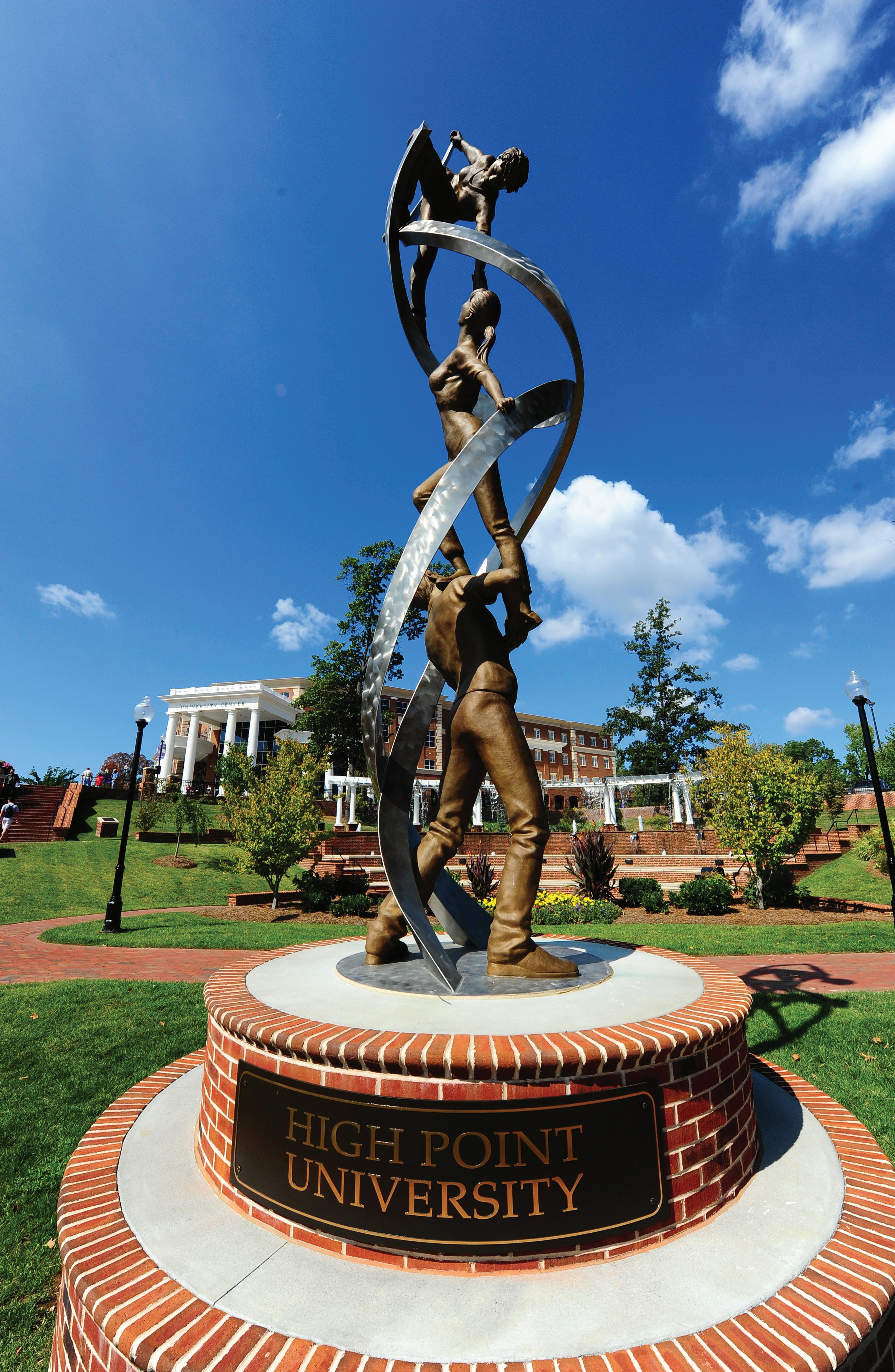
20 The Lighted Lamp | 2023
million years!” either. I think it is important to pick the right time to ask for the resources you need, and use them wisely, which provides evidence that your research productivity is something that the university should invest in.
Third, be willing to help others in turn. Collaborate on research with junior colleagues and work with students if possible. Inspire others by showing passion and dedication to your research.
Fourth, you will be rejected from journals, you will be denied grants, and you will get tired as the semester moves on and grading piles up, but do not give up on your work. Research is a big part of what academics do. It’s what most of us signed up for when we enrolled in graduate school and set off on an academic career. It’s important not to lose sight of those goals.
Fifth, research makes us better teachers. Research gives us confidence and credibility in the classroom. Students come alive when I discuss ongoing research projects about class topics. It helps them understand the puzzles and problems of investigation on compelling issues.
Sixth, our research enhances the academic reputation of the university. I am often told by visitors to High Point that our campus is beautiful and that our growth is impressive. Our willingness to support faculty research sends signals to the broader academic community of our commitment and credibility as an institution of higher learning and furthers our ability to attract top students from around the country.
Seventh, each day, no matter what you are doing, take time to read (or do) something that has absolutely nothing to do with what is on your agenda or checklist. Nothing beats a great book for me at the end of the day. The books that I’ve read over the years have always given me the inspiration to get
up the next day and do whatever needs to be done on that checklist.
I most recently finished reading a classic, Virginia Woolf’s To the Lighthouse. I had read other work by her, but dinner with a passionate Woolf enthusiast inspired me to go check out a copy from the HPU library (my favorite place on campus, aside from the faculty lounge) this fall. I’m glad I did, for Woolf reminded me how life often does not work out according to our plans, and to make each moment count. Otherwise, we may never reach the goals that we seek.
For now, my ‘Lighthouse’ is my research, my teaching, and supporting my family. In terms of work, I’m doing a great deal of survey research in Ukraine, which I hope to speak about in an upcoming Ridenhour faculty lecture. I’m also writing papers related to ongoing projects in Iraq, involving people affected by years of brutal sectarian conflict. I’m working on research related to social movements, a topic I came to devote more time to during the pandemic and the political upheaval of the past few years, and I’m engaging in more collaborative research with my political science colleagues at HPU. But I’m also taking my kids to baseball and soccer games and spending time with family, whose patience and support have been vital to getting all these projects on my agenda accomplished.
And I’m also looking forward to reading the next great book that will inspire me in some fundamental way. I’m currently a third of the way through another classic, Steinbeck’s The Grapes of Wrath, and it has already motivated me to think more about the impact of climate change and economic disruption in a time of growing refugee crisis, anti-immigrant backlash, and widespread labor exploitation in America. I’d also like to think I might write on some of these themes in my future research, faculty’s ongoing commitment to research. ❚
www.highpoint.edu
21
KURINUKI AS CREATIVE MEDITATION
Mr. Mark E. Brown Associate Professor of Visual Art, Hayworth School of Arts & Design
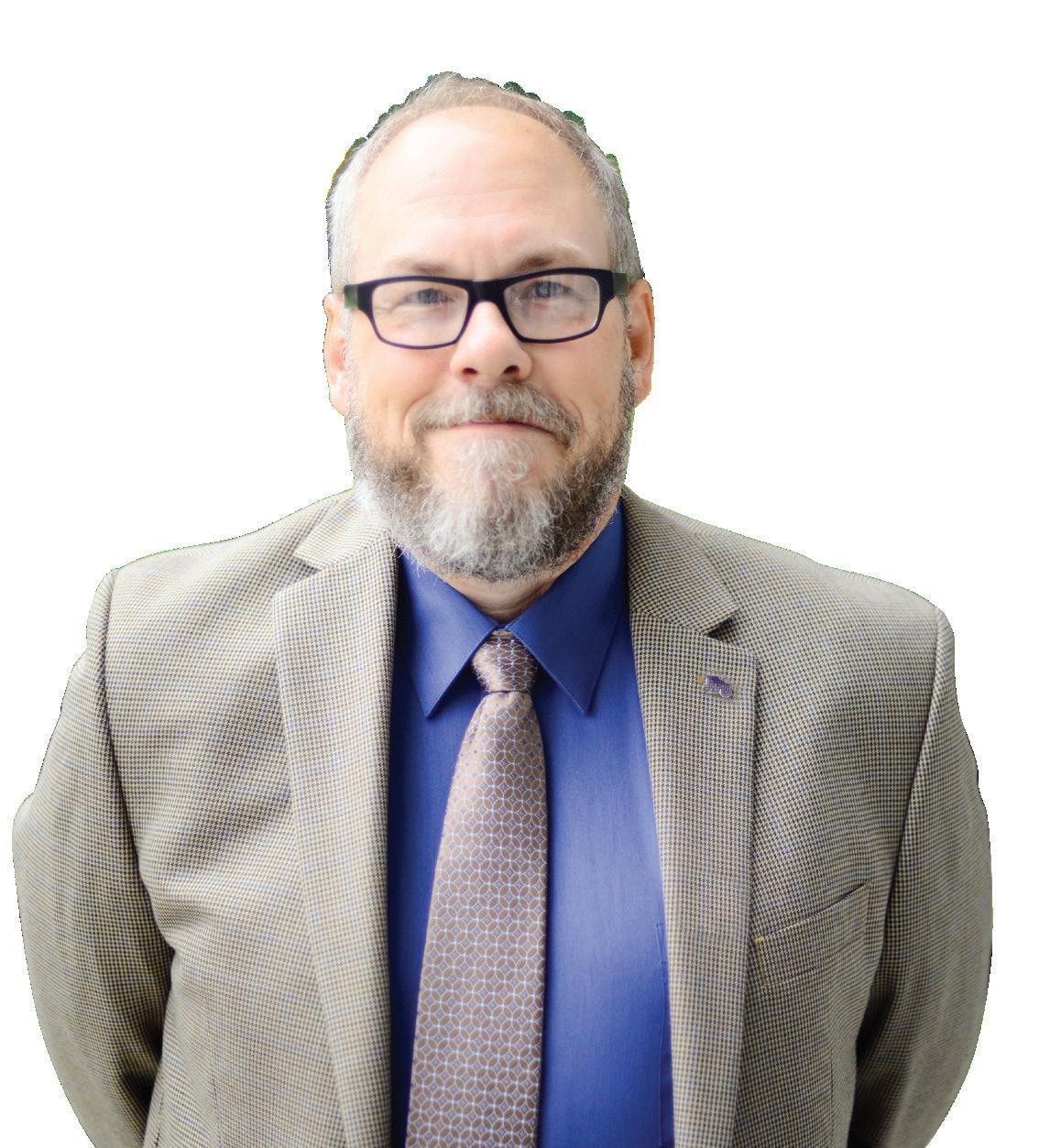
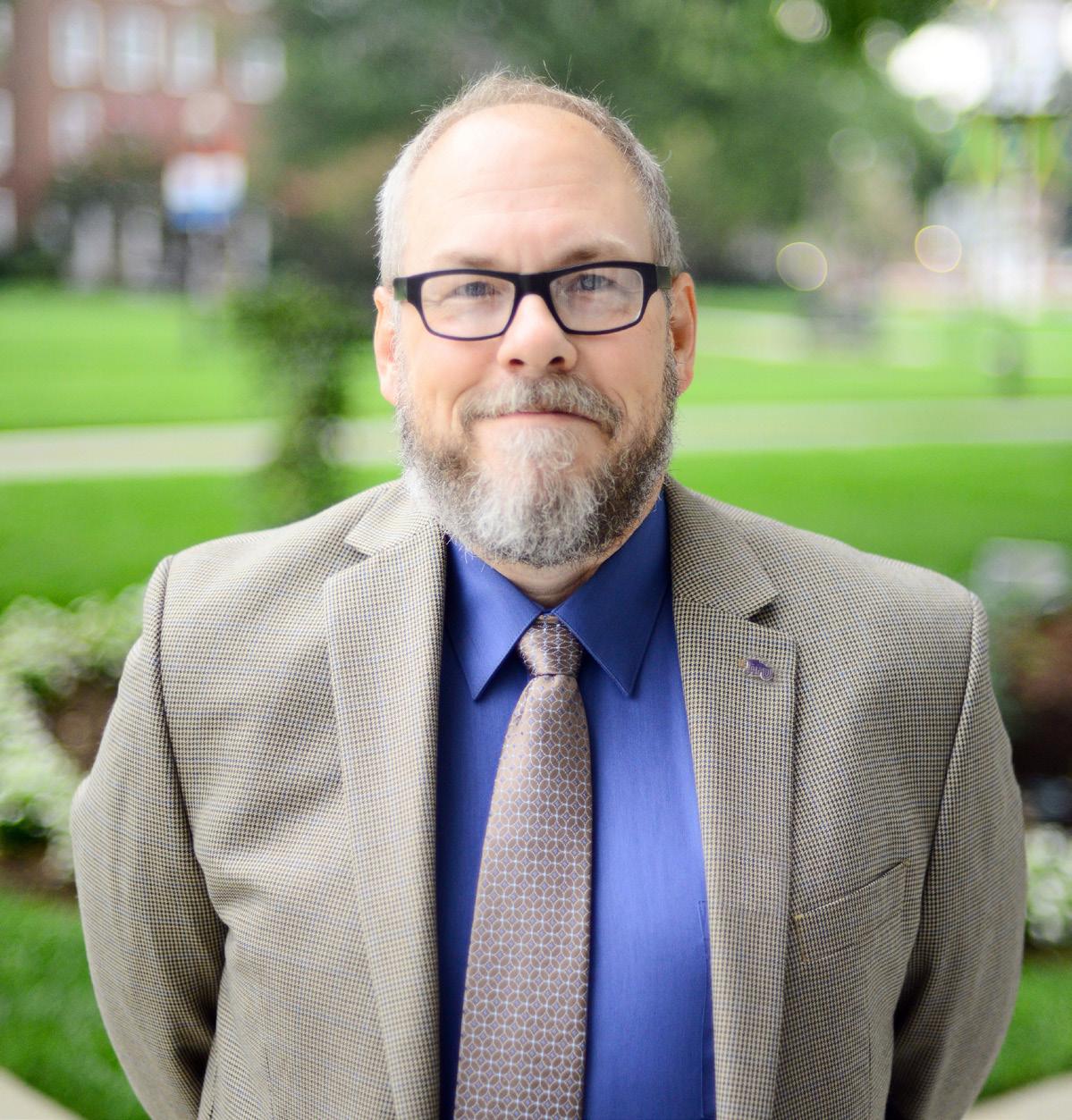
As teachers, we find ourselves confronted with the challenge of involving students in reflective thought at a time when the answer to anything can seemingly be found on the phones in their pockets. As an artist, I frequently find myself swept up into the same cycle of complex information versus easy introspection, versus the ease of being told what is or should be. I frequently engage the creative practice of kurinuki as a way of focusing my mind and engaging in the moment.
A Tradition of Carving
I come from a family of artisans, and childhood experiences have provided a backdrop and roadmap for me to traverse my creative journey. My grandfather was a significant influence on me, as was his father for him. From my earliest childhood memories, I can remember sitting outside my grandfather’s shop “working” alongside him. When I was very young, he would toss out wood scraps from the furniture he was creating, and I would play with them as blocks, building towers and fortresses from the random shapes being lobbed my way. When I was old enough to wield a hammer, I began fastening these blocks with nails … madly banging away until I hit a finger and needed a break. My first attempts at modeling
were with my grandfather using cement, as were my first attempts at casting using lead. Finally, when I was old enough to handle a knife, I carved my first objects.
I use the term “carve” here, but my grandfather called it “whittling.” The idea of whittling was central to his late afternoons and weekends. One of the proudest moments of my childhood was being invited to sit with my grandfather and uncles while they whittled — it was a rite of passage — albeit short-lived, because, as a child, I could not understand the need to sit still and not speak while whittling. Childhood exuberance aside, I had yet to reach a point where I could understand the benefits of looking inward, taking time to be with my thoughts, and addressing ideas and emotions while working with my hands. As an adult who now appreciates what was going on, I will always be thankful that I had the opportunity to experience those early mindful sessions with my grandfather. I keep the following quote, from a compendium in my grandfather’s library, on my studio wall as a reminder:
“I had occasion frequently to notice this philosophic repose of character, which I can only account for by ascribing it to that
22 The Lighted Lamp | 2023
universal practice of ‘whittling,’ which is so prevalent with the people of this Western World. If a man has only a knife and a stick, he bids defiance to time, and all the ordinary accidents of traveling. He sets himself down, and snips away till nothing is left; and then, after appearing uneasy about something or other, gets himself another stick, and commences again with renewed vivacity.” — Graham’s American Monthly Magazine. April 1843. Philadelphia.
Whittling, or carving, is a universal practice and is as old as recorded history. The act originated with a pragmatic purpose: creating objects needed for daily subsistence. Historically, carved materials include stone, bone, wood, metal, and other materials that are soft enough for humans to form with a tool. As a practice for mindfulness, carving is a bit more difficult to date; possibly the two evolved simultaneously. In the past few years, I have focused more of my ceramic practice on carving clay, harkening back to those whittling sessions as a child.
Kurinuki, Process, and Meditation
As a practicing meditator, I have often, over the years, utilized the process of kurinuki to focus my creative self and ideations. Kurinuki is a traditional Japanese method of hand-
making clay forms involving a meditative working process. The word kurinuki means “carving out” and comprises shaping a solid block of clay before carving out a vessel to create interior space. It is a more sculptural approach to vessel making, where the interior of the work is just as important as the exterior.
The idea behind kurinuki is that it should be spontaneous and alive, that the work should show the marks of the maker, and that these marks should be deliberate and are of value in their own right. This process also gives a voice to the clay. The finish is not intended to be refined and smooth; the rawer and more sculptural the object is, the better it demonstrates the process of making.
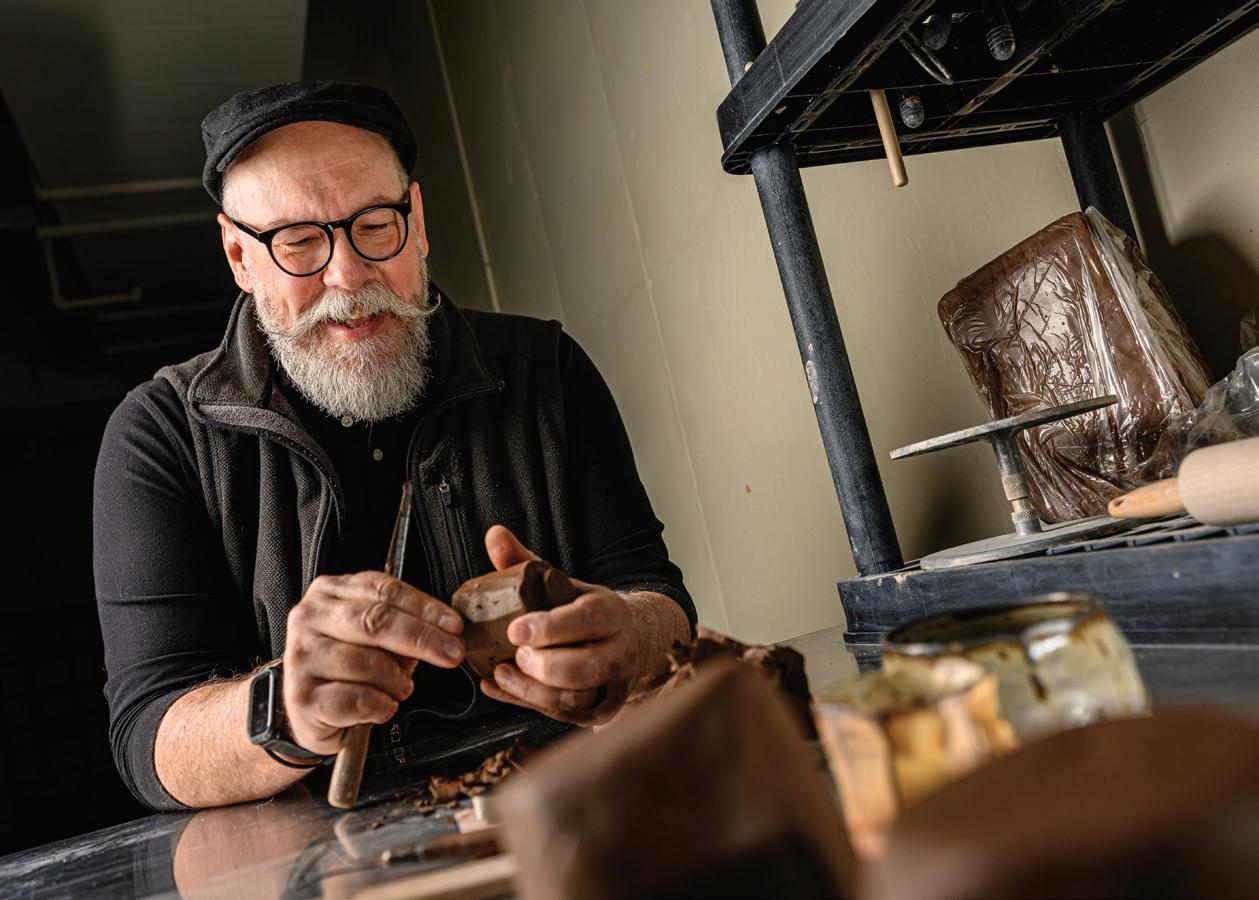
When I begin carving, I follow instinct, plunging a knife into the clay, letting go, not dwelling on the multitude of thoughts and emotions swirling in my brain; I enjoy the process and the moment. The blade slices, producing new forms from old, constantly refining, constantly becoming. Slowly the cup emerges from what began as a lump of clay. I focus on the surface of the clay, the heft of what was, gradually getting lighter as segments are removed; the dampness of the clay beginning to dry as new surfaces are exposed to the air. Something that before had a shape now suddenly has a different form … sometimes I am surprised by this, other times I’m barely aware as the clay continues to evolve in my hand. This is what it’s like to lose yourself in the process.
Each kurinuki cup I create is a meditation reflective of the mind-walk taken while creating it. Each kurinuki cup is as distinct as each singular meditation. The cups represent the outcome of a process where I can remove myself from the day-to-day system of “what happens to, around, and within us just happens” and attempt to find meaning in those events, interpreting them into a personal visual language. In that sense, these meditations provide a gateway for contemplation and ideation of other pursuits in my daily creative practice.
23 www.highpoint.edu
Teaching Wabi Sabi
Historically, the kurinuki process is grounded in the underlying traditions of Zen Buddhism and Shintoism, connecting mindfulness and contemplation with a deep respect for nature and its rhythms. Transience is central to these themes and is why kurinuki is often related to the aesthetic philosophy of Wabi Sabi, or beauty in imperfection. Objects in the process of decay or conception are considered more evocative than those that are refined or finished because it reinforces this sense of transience.
Taken individually, the words wabi and sabi are separate concepts. Wabi invites us to find significance in simplicity, considering objects for their intrinsic nature. Sabi is concerned with the ephemeral, the process and effects of time, from growth to decay, and its manifestation in objects.
As Beth Kempton wrote in her 2019 book, Wabi Sabi, a Japanese Wisdom for a Perfect Imperfect Life:
“Put simply, wabi sabi permits you to be yourself. It encourages you to do your best but not make yourself ill in pursuit of an unattainable goal of perfection. It gently motions you to relax, slow down and enjoy your life. And it shows you that beauty can be found in the most unlikely of places, making every day a doorway to delight.”
In my ceramic courses at High Point University, I attempt to demonstrate to my students that working with clay is a volatile, slow, and considered process. This is at odds with the pace of the culture that we live in. From the moment a ceramic work is conceptualized, any number of unfortunate possibilities present themselves. The process of creating is just the beginning. If the clay is not prepared correctly, it can lead to issues with the construction and design. And once the artist is successful in realizing their vision, that is when things can really go wrong. If the work dries too quickly or unevenly, it may crack; structural issues can occur if it dries too slowly. The slightest slip
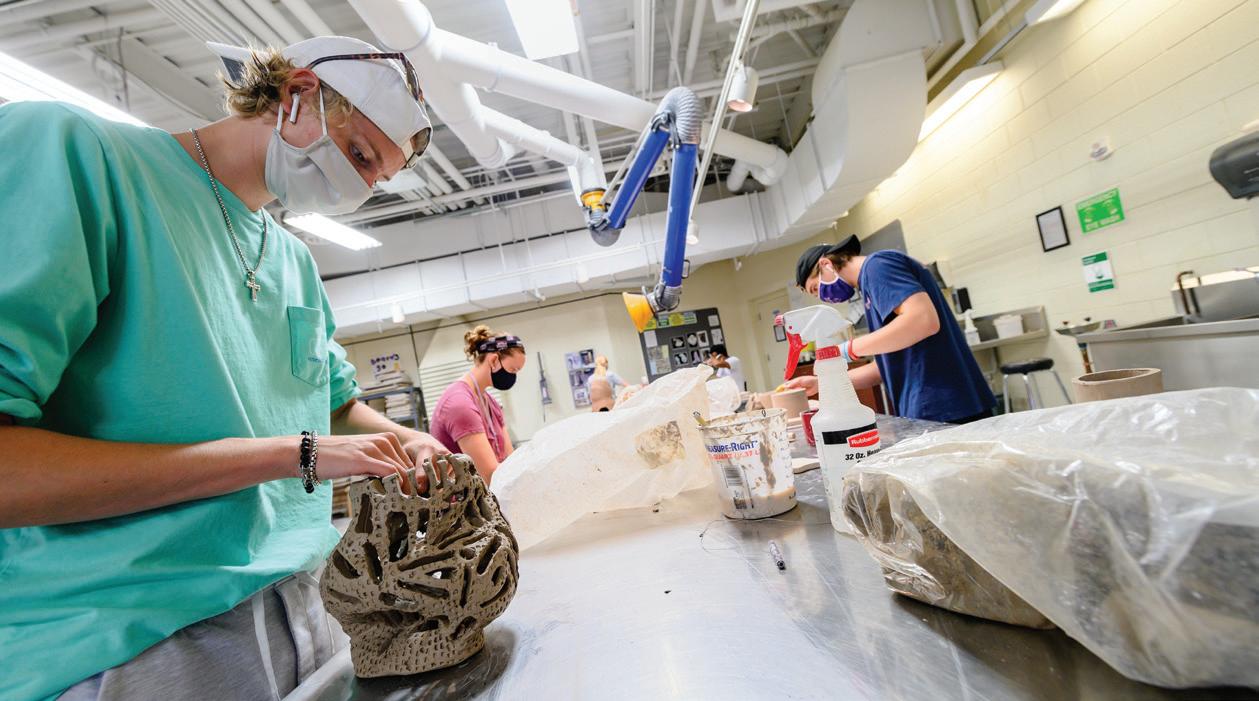
in handling works can cause breakage. Even once the works are successfully loaded for firing, problems can occur in the kiln; work loaded before receiving ample drying time may explode, and glazing mishaps are all too common. There is a saying that when the potter pulls a beautiful piece from the kiln, the potter bows to the kiln and says “thank you.”
All of this speaks to the deliberative nature of what it takes to make successful ceramic work. Working with clay requires knowledge of process, chemistry, and fundamental physics. What it requires most, however, is patience and the ability to cope with failure and learn from it, two things in short supply with many of today’s students. To that end, much of our studio time is dedicated to that very concept of patience, remaining calm, and respecting a material that will often feel like it has a mind of its own. While the student will constantly attempt to control and bend the clay’s will to theirs, they must acknowledge that other processes are taking place. They must learn to accept them and work with them. The control that they desire is elusive. Some minor or catastrophic failures in the ceramic process are inevitable. From every mistake comes a lesson. From every problem comes one, or infinite, solutions. This is the nature of Wabi Sabi. We would never have seen, understood, or experienced the problem if it had not happened and if we didn’t have the courage to acknowledge it. Apologizing about inadequacies or fretting over mistakes takes time away from our life and from the enjoyment that practice brings. When we remove fear from the equation, a mistake becomes the perfect learning moment.
Each year, I take students on a month-long
24 The Lighted Lamp | 2023
study abroad trip to Italy. On that trip, I point out drying cracks in the work “Madonna and Child Between Two Angels” by Luca della Robbia housed in the Bargello Museum in Florence. It is evident from the nature of these cracks that they were unintentional, a flaw if you will. Della Robbia, however, rather than dwelling on this unfortunate mishap, embraced the cracking as a spacing element in the large single center tile turning a single tile into five. By embracing the accident, it becomes intentional. This is an ideal example of the medium having a voice in its creation and demonstrates that even the most skilled among us are still capable of mistakes. By embracing and learning from these mistakes we build the confidence in ourselves that it takes to succeed.
Artists are storytellers and processing the world around us to tell that story can be an emotional and challenging process. When I begin work on a series of sculptures or drawings, I start with a firm conceptual idea, a touchpoint that I can return to as the narrative I want to tell comes to fruition. However, when creating, something as simple as a line or variation in texture can change the storyline’s direction. This is an idea that I attempt to communicate to students: that creation is often equal parts planning and happenstance but, if we are bold and trust in ourselves and our abilities, these setbacks can drive us to new discoveries and confidence.
Seeking Inspiration: Kurinuki
Before the pandemic became a reality, I was offered a solo exhibition. The exhibit was scheduled eighteen months out, so I was sure that a) I would have plenty of time to get the work together and b) the pandemic surely wouldn’t last eighteen months. With these thoughts in mind, I decided to create all new work for the exhibition, thirty works in total. As it was, only one of those sureties came true; I had plenty of time to create.
I began with a quote from an Arthur Conan Doyle short story, “The Man from Archangel,” which I had recently read and that gave me
pause: “By that time the sounds of the tempest had become a lullaby to me.” The resonance of this quote within our current socio-political environment seemed all too fitting. It was then that my exhibit “Lullaby” was born. Over the next year, I created those thirty works, at times driven like a madman and at times suffering the almost inevitable creative block.
By the time the exhibit was delivered and installed I was creatively spent. In this process, the telling of the story had become exhausting and taken its mental toll. I knew I would eventually begin creating new work again … but what? It was at this time that I reintroduced myself to an old friend, kurinuki. Since the “Lullaby” exhibition, I have created over one hundred kurinuki vessels, each allowing me to further focus my world and creative self. What does one do with that many vessels you might ask? Many found new homes, but the overwhelming majority have found a new home in my home.
I came across a juried exhibition last year titled the “Dirty South Cup Competition” in Alexandria, Louisiana, and, on a lark, I decided to enter a few of the kurinuki. Each of these is so personal that it was difficult to imagine that anyone save me would see value in them. That, however, did not turn out to be the case as the exhibition juror, ceramicist Rene LoPresti, included my work in the exhibition. This acceptance gave me the impetus I needed to begin exhibiting the cups and subsequently, my kurinuki were featured in the 2022 national Humble Cup exhibition.
Appropriately, a creative pursuit meant as an aid for inspiration now occupies its own mantle. When occupied in an activity that genuinely engages your mind and spirit, you gain focus, and with a bit of luck and practice, the detritus crowding your mind becomes less critical. In that moment, you let go and follow your instincts. Perfection can lie in imperfection. Handmade objects are beautiful because they are imperfect and, as such, unique, like those who create them. ❚
25 www.highpoint.edu
THIS RESEARCH IS BROUGHT TO YOU BY LETTERS: C, O, O, N, E, AND
Y: FOUR YEARS OF THE HPU COONEY CENTER AT
SESAME RESEARCH SCHOLARS PROGRAM
Dr. Sarah Vaala Associate Professor of Strategic Communication, Nido R. Qubein School of Communication

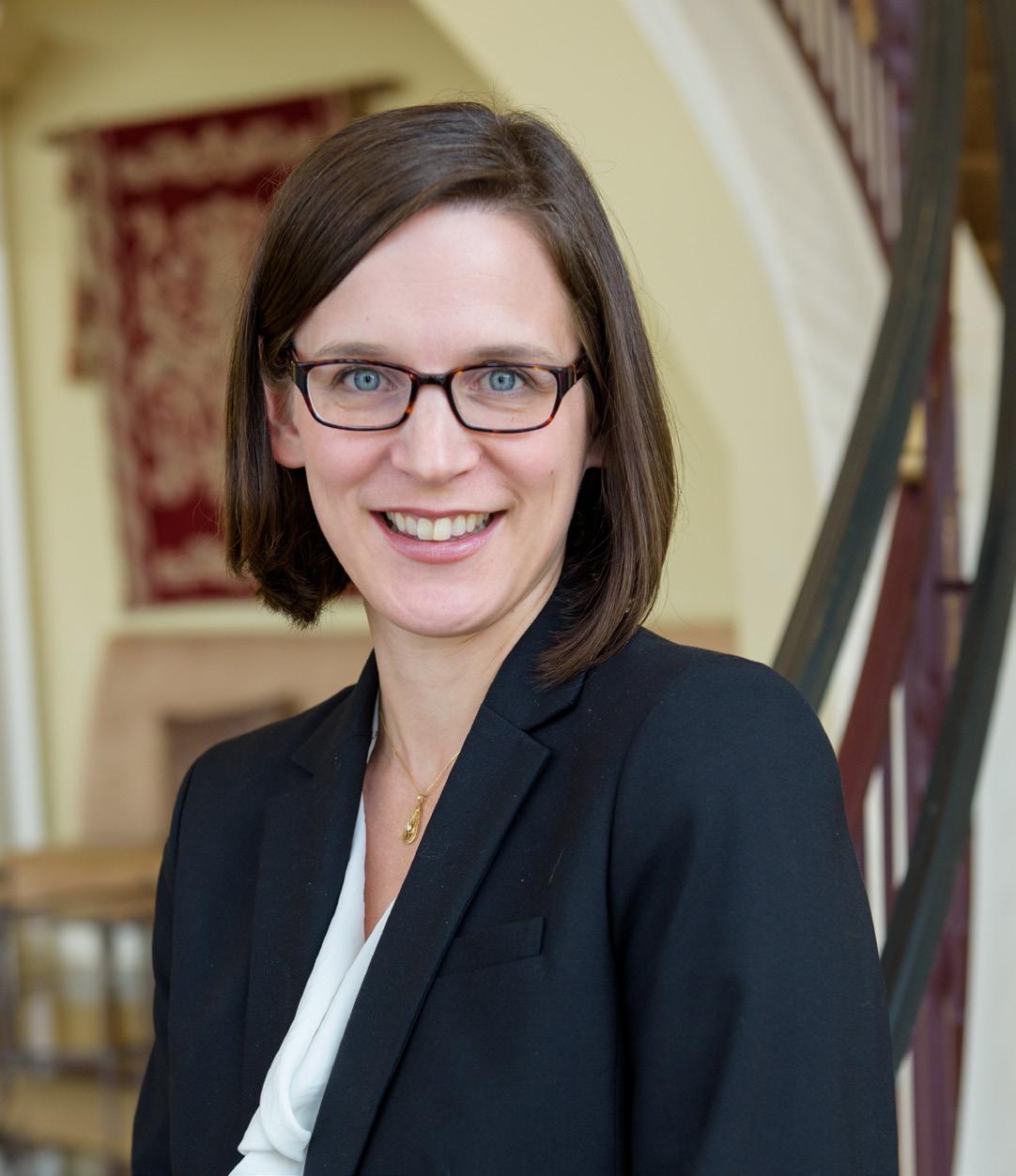
Joan Ganz Cooney is not a household name, although her legacy streams daily through homes across the United States and the world. In November 1969, Ms. Cooney, together with her business partner, Dr. Lloyd Morrisett, first launched Sesame Street on network television. Convinced that “it’s not whether children learn from television, it’s what children learn,” Ms. Cooney envisioned the program as a kind of freely available preschool; a resource available in the 97% of American homes with televisions that could help close the school-readiness gap among lower-income kindergarteners.
The Sesame Street program was groundbreaking in a number of ways. As executive director of its production company, Children’s Television Workshop, Ms. Cooney became one of the first female television executives in American history. Sesame Street won three Emmy awards in its first season, and it continues to hold the record for most daytime Emmys. Several years of research on how children learn from televi-
sion preceded the launch of the show,1 and to this day Sesame Street remains the gold standard for research-driven educational media production for children. This last point is part of what drew me, wide-eyed and idealistic, to the field of children’s media research as an undergraduate student nearly 20 years ago.
While completing my Ph.D. in communication studies in 2010, I pursued an industry post-doctoral position at the recently created Joan Ganz Cooney Center at Sesame Workshop. Launched in 2007, the Cooney Center expands Ms. Cooney’s initial vision for television to explore and catalyze the ways newer digital media can contribute to children’s learning and development. The Cooney Center conducts and disseminates research on the use and impact of new media, such as apps, ebooks, video games, and AI, among children and families. With a diverse audience for their work, including parents, policymakers, and media producers, the Cooney Center is able to do
26 The Lighted Lamp | 2023
1 In fact, Sesame Workshop (formerly Children’s Television Workshop) is an independent media and education nonprofit organization.
what many of us in academia often cannot — translate and communicate research insights to various stakeholders who are poised to actually apply them. The staff of the Joan Ganz Cooney Center consists of a small but mighty team housed at Sesame Workshop, and they depend on close outside research partners to realize the center’s mission. And that’s where High Point University comes in … .
Cooney Center at Sesame Research Scholars
I joined High Point University in fall 2018 as an assistant professor of strategic communication, maintaining my affiliation as a senior fellow with the Cooney Center. Eager to find a way to weave my applied research program with the Cooney Center in with my teaching and scholarship at the Nido R. Qubein School of Communication (NQSC), I developed the HPU Cooney Center at Sesame Research Scholars program. Through this undergraduate research program, which launched in fall 2019, five to six undergraduate students are selected each year through an application and interview process. The selected students participate in a research project with me on behalf of the Cooney Center for one academic year. Our partners there give us a research topic based on their current institutional priorities, which we finetune into more specific hypotheses and research questions. Working as a mentored research team, the students conceptualize and design an appropriate research project to address those goals. We collect data with children and parents, analyze it, and compile a final presentation of findings to deliver to our Cooney Center partners.
To date, twenty-four HPU students have been involved in the HPU Cooney Center Research Scholars program. The program is open to all upperclassmen, regardless of major; in fact, eight different majors have been represented so far across the four cohorts. The multidisciplinary nature of each team has been an asset to the research, filling in gaps in my own skillset and knowledge base countless times. Selfishly, the student scholars’ diverse interests, experiences, and talents help push me out of my own
research ruts and are a rewarding impetus for my own continued learning. Truly, the students and I figure things out together. Hailee Haas, a current Cooney Center Scholar, reflected on the collaborative working meetings within our team, saying:
“I enjoy how judgement-free our meetings and brainstorm sessions are — there are no dumb ideas or questions, and we are free to throw out the most outlandish ideas with the expectation that we will work together to refine our ideas into achievable actions without a fear of judgement.”
Since fall 2019, the HPU Cooney Center Research Scholars have designed and conducted two novel research projects related to children and media, each described below.
YouTube “Unboxing” Study
When COVID-19 hit the United States and the world began shutting down, I was spending my free time in the High Point Walmart with my inaugural team of student scholars, collecting data with families for the first Cooney Center project. Although we had to suspend data collection, the first Cooney Center Research Scholar cohort had developed a timely and novel project. We had been given a broad charge: to investigate how tween-age children (eight to twelve years) navigate publicly available online media. The students and I found mutual fascination with children’s “unboxing” videos — videos common on YouTube in which child hosts open and demonstrate the qualities of a toy or other product. These videos are often sponsored, though sponsorship relationships are not always appropriately relayed to viewers. Unboxing videos are very popular with children and tweens, and some “kidfluencers” have risen to celebrity status through their video review channels. In fact, the top-paid YouTuber between 2018 and 2019 was an eight-year old boy, Ryan Kanji, who made millions of dollars from his toy review channel “Ryan’s World.” As of 2021, his channels (which included channels dubbed in Spanish and Japanese) had over thirty-one million
27 www.highpoint.edu
subscribers.2 A visit to your local Target will likely reveal a toy aisle dedicated to Ryan’s own licensed product line.
As we dug into the literature about online “stealth” marketing to kids and the rise of unboxing videos, my students and I wondered how young people make sense of this form of content. Do they recognize the commercial relationships between host and product manufacturer and approach unboxing videos with skepticism? Or do they consider hosts to be demonstrating toys and other products as a way to assist and inform other kids? Together, we designed a strong experimental study examining eight- to twelve-year-old children’s online information literacy skills and understanding of commercial bias cues in YouTube unboxing videos. With an impressive mix of skills and interests, including knowledge of child development and children’s learning, message design and evaluation, and media production, the first cohort of students took the lead on filming different versions of an unboxing video and creating an animated media literacy training video (with the help of some child actors who were children of HPU faculty).
These videos served as impressive experimental stimuli.
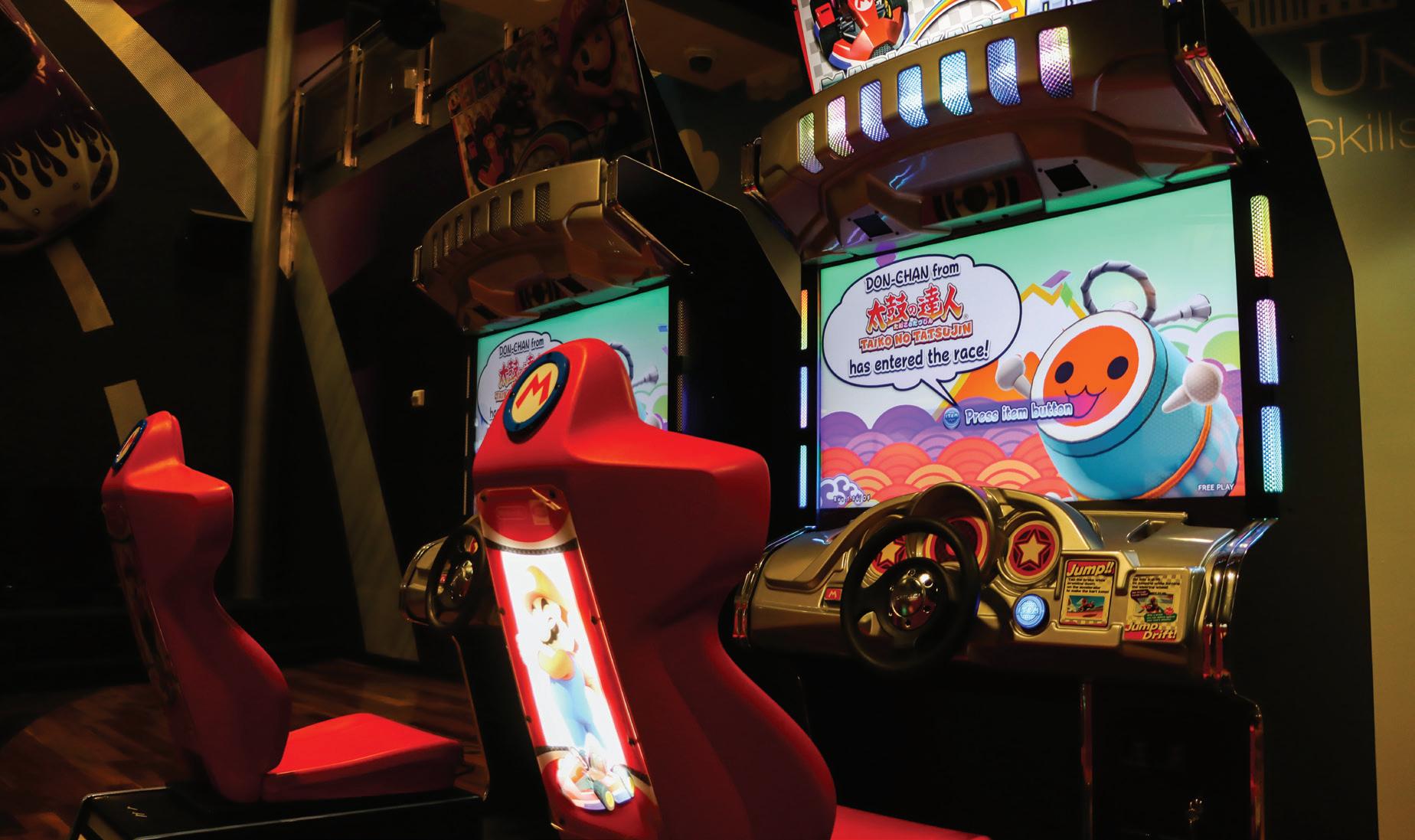
When the COVID-19 pandemic forced the Institutional Review Board to suspend all in-person research activities, my second student cohort converted our unboxing study to allow for fully remote recruitment and participation. The students found avenues for promoting the survey experiment to recruit families (e.g., parent websites and social media pages; pediatricians; schools). Later, I used professional development funds to collect another round of parent-child data through a polling company. In spring 2021, we analyzed the in-person and remote samples of data together. Each student developed and pursued several research questions and hypotheses, as I helped them navigate SPSS statistical software and learn appropriate quantitative and qualitative analyses.
Our results add to the timely conversation surrounding online “stealth” forms of advertising to children. We found that kids’ ability to detect selling intent of the unboxing video increases with age in the absence of a training
28 The Lighted Lamp | 2023
2Hunting, K. (2021). Unwrapping toy tv: Ryan’s World and the toy review genre’s impact on children’s culture. In R.C. Hains and N.A. Jennings (Eds.), The Marketing of Children’s Toys: Critical Perspectives on Children’s Consumer Culture, (pp. 105125). Palgrave Macmillan.
video, and that tweens are more able to detect a commercial bias when the video contains overt cues of sponsorship (compared to subtle hints). Our pre-roll media literacy training video improved tweens’ ability to detect selling intent in the unboxing video with overt sponsorship cues (but not when the sponsorship cues were subtle). Unexpectedly, the training video also caused kids to rely more on their judgment of the host’s informative intention — belief that they were sharing truly assistive information about the product to help others, while weakening the positive relationship between perceived “selling intent” and purchase intention.
In April 2021, the students presented our study and findings remotely to members of the Joan Ganz Cooney Center and Sesame Workshop and other figures in children’s media production, research, and policy. In addition, student scholar Allison Patrick published a blog post about the study on the Cooney Center website,3 while Francesca Mauceri presented findings at the International Organization of Social Science and Behavioral Research (IOSSBR) in March 2022. Fran, who went on to complete a master’s degree in HPU’s Communication and Business Leadership program, is currently working with me to publish findings from the study in an academic journal. Her continued engagement reflects the contribution of the research experience to the development of Fran’s career interests. In her words:
“Being a Cooney Center Research Scholar has inspired me to work in the field of children’s media. The research program has benefited me in so many ways, not only in teaching me about the field of children’s media but also giving me the skills of completing literature reviews, writing papers, presenting qualitative research, and working on in-person data collection with
local children. Being a Cooney Center Research Scholar truly shaped my experience at HPU, and I’m so grateful for the opportunities it has given me.”
STEM Museum Study
In fall 2021, the Cooney Center sent us a very different kids-and-media topic to tackle: integration of new digital technology with kids’ STEM learning in out-of-school settings. The third cohort of Cooney Center Scholars was the right team for the job! They brought an impressive range of majors, interests, and skillsets, which we leveraged in the design of the second Cooney Center project. Two of the students, Christy Hribar and Jordan Morrison, had prior internship experiences at museums (the Smithsonian and the Greensboro Science Center (GSC), respectively), making our choice of an out-of-school setting an easy one. Recently, Christy commented on the connection between her prior experience and interest in the Cooney Center research project:
“What drew me to apply for the Cooney Center at Sesame Research Scholars Program was the topic of researching children’s education in museum spaces. I also interned at the Smithsonian Institution’s Arts + Industries Building, where I learned firsthand about the museum sector and design process. So, when the opportunity to work with the Cooney Center came up, I wanted to dive deeper and research museums’ effectiveness in education.”
We designed an exciting quasi-experiment that examines nine- to twelve-year-olds’ learning and engagement with science exhibits in museums and the role of freely available public media for extending that learning and engagement. Through Jordan Morrison, we forged a partnership with the Greensboro Science Center, collecting data there during spring
3https://joanganzcooneycenter.org/2021/08/17/an-experiment-to-understand-childrens-digital-literacy-skills/
29 www.highpoint.edu
2022. Our study examines children’s engagement in several outdoor zoo exhibits at GSC which have a supplementary augmented reality app. Participating children used the AR app while viewing three animals in the zoo and watched an educational YouTube video about the animals either before or after using the app. Our measures capitalize on mixed methods, including parent and child surveys, child observation, and content analysis of “video postcards” made by participants about their exhibit experience. A primary goal is to determine how children’s experiences with museum exhibits could be extended at home through freely available media; and vice versa, how previous media exposure on science topics might boost their learning and engagement from science exhibits.
The current cohort of students is continuing this project and extending it to the “Mars Academy” Exhibit of the Nido and Mariana Qubein Children’s Museum in High Point, North Carolina. We are pairing the exhibit with an augmented reality app produced by the Smithsonian through which kids get to practice driving a Mars rover on iPads. Children use the AR app either before or after choosing an interactive activity within the Mars Academy exhibit (e.g., a coding game to direct a rover; planning a Mars settlement to support a certain number of astronauts). Data collection has
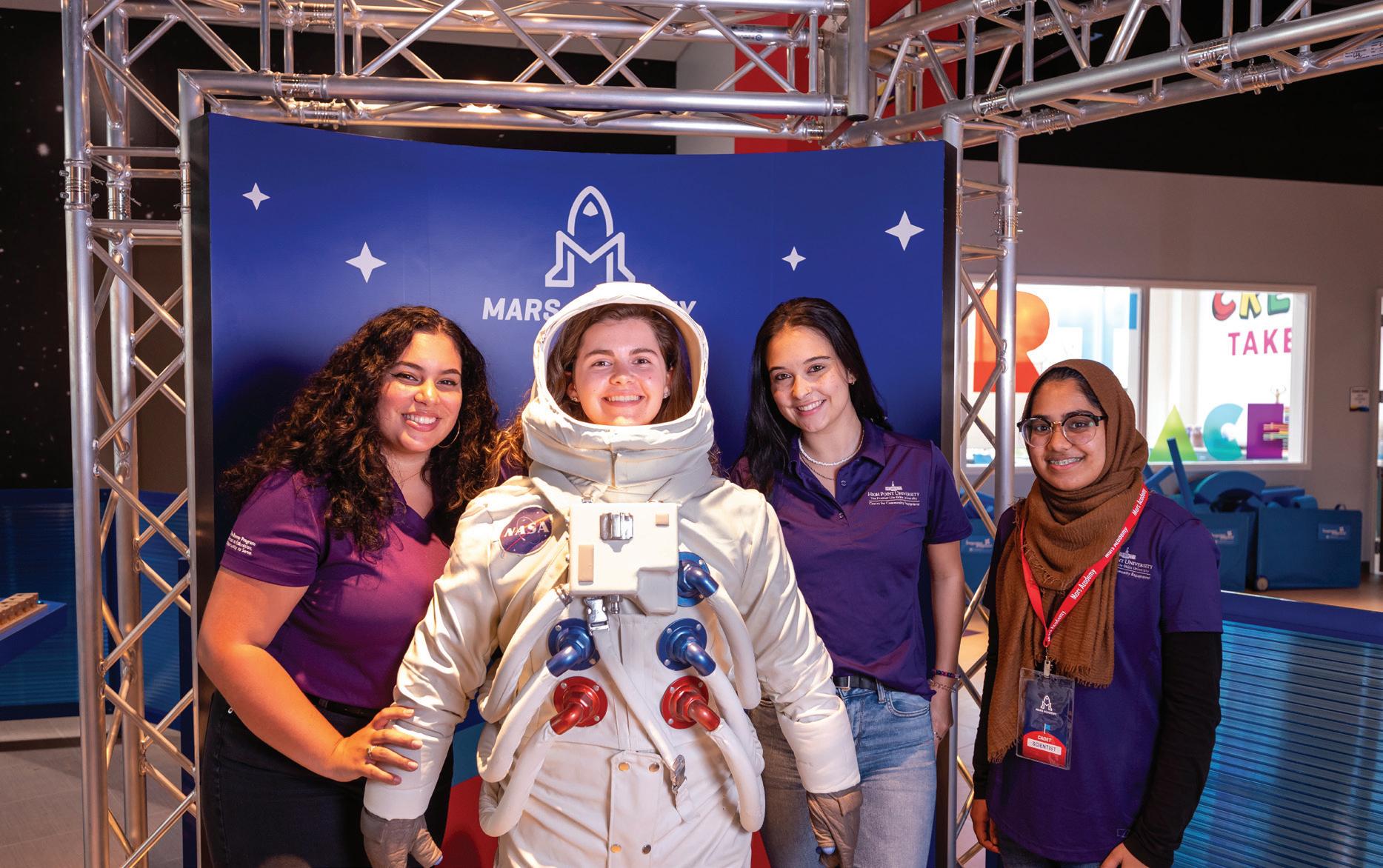
recently concluded, and analyses will incorporate both phases of data collection (Greensboro Science Center and Nido and Mariana Qubein Children’s Museum) to address larger questions of the impact of media tools on kids’ museum engagement.
In the meantime, Jordan Morrison presented essential findings from the Greensboro Science Center data at the National Conference on Undergraduate Research (NCUR) in Eau Claire, Wisconsin, in April 2023. Her analyses indicate trends for students to learn more from the media that they viewed first, and that they particularly retain animal facts from the YouTube video (compared to the augmented reality app). She reasons that kids may experience oversaturation from information when given too much media regarding one topic in a short amount of time. She found further that kids who view themselves as scientists are more likely to learn from new technology tools compared to their peers that do not perceive themselves as scientists. Moreover, kids whose parents indicated a strong value with STEM topics were more likely to see themselves as scientists.
Rewarding Mentorship and Exciting Partnerships
One benefit of the program’s design is the opportunity to work with students and get to
30 The Lighted Lamp | 2023
know them for an entire school year. I have found that committing to the project for an academic year heightens students’ dedication to the project and contributes to their sense of ownership over the design and the findings. I also get to know each student well and feel truly invested in their long-term goals and successes; plus, I can write them a killer recommendation letter! About the study timeframe, current scholar Alexa Schuette remarked:
“Spanning the course of a year rather than a semester, I will have a chance to do both the preparation and collection of research. Having an experience where I have to dedicate a lot of time to one project will likely be well-received by the graduate schools I plan to apply to.”
The HPU Cooney Center Research Scholars Program has also given me numerous opportunities to get to know and collaborate with HPU colleagues outside of communication. When COVID wreaked havoc on in-person data collection for the YouTube unboxing study, Dr. Martin Kifer (political science) and Mr. Brian MacDonald (HPU Survey Research Center) generously helped our remote data collection efforts through HPU’s Survey Research Center. While planning the STEM learning project, I
learned that Dr. Stacy Lipowski (psychology), Dr. Briana Fiser (physics) and Dr. Anne Leak (formerly in education) had intersecting interests. They contributed to the formation of the study, and we are conducting a complementary study with undergraduates which explores the development and repercussions of young people’s science identity (feelings of efficacy and internal connection to fields of science). My students’ abilities to collect data, analyze and report findings, and travel for conferences were also aided by mechanisms through the Office of Undergraduate Research and Creative Works, the Communication and Business Leadership Master’s program, and undergraduate independent study mechanisms. A career in research can be lonely but not so at High Point University. I am consistently grateful for the mentorship, partnership, and camaraderie I have found in my HPU colleagues in the course of this research program.
Supporting a Forward-Thinking Mission
Now in her nineties, Joan Ganz Cooney can no doubt appreciate that her mission and eponymous center are even more important in our current media landscape than ever before. While she couldn’t have foreseen ChatGPT, Wikipedia, or virtual reality headsets in 1969 (or even as recently as 2007), her vision of children’s draw to media technologies and inevitable propensity to learn from them (for better or worse) was ahead of her time. Ms. Cooney has created a legacy of anticipating, embracing, and harnessing change in order to serve the needs of children and families. In that spirit, part of the Cooney Center’s mission is to incubate and nurture future leaders in children’s media policy, production, and research. This means that the HPU Cooney Center Research Scholars are contributing twofold to the aims of the Joan Ganz Cooney Center, though they likely don’t realize it. While my students are pushed to consider and examine the world within and beyond the glow of their own media devices, I get to hold on to a bit of the idealism that drew me to this field in the first place. ❚
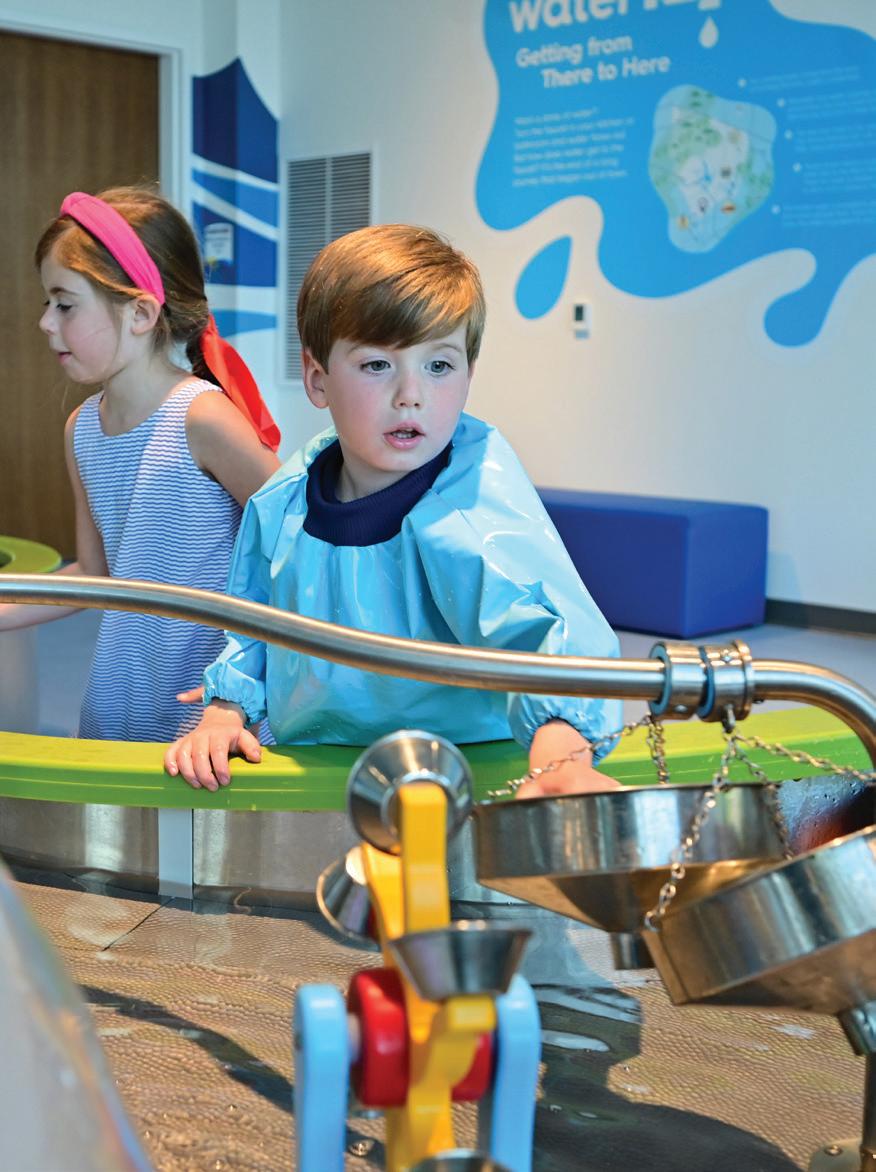
31 www.highpoint.edu
THE EYE LENS AS A MODEL OF PROTEIN AGING
Dr. Jeremy Whitson Assistant Professor of Biology, Wanek School of Natural Sciences
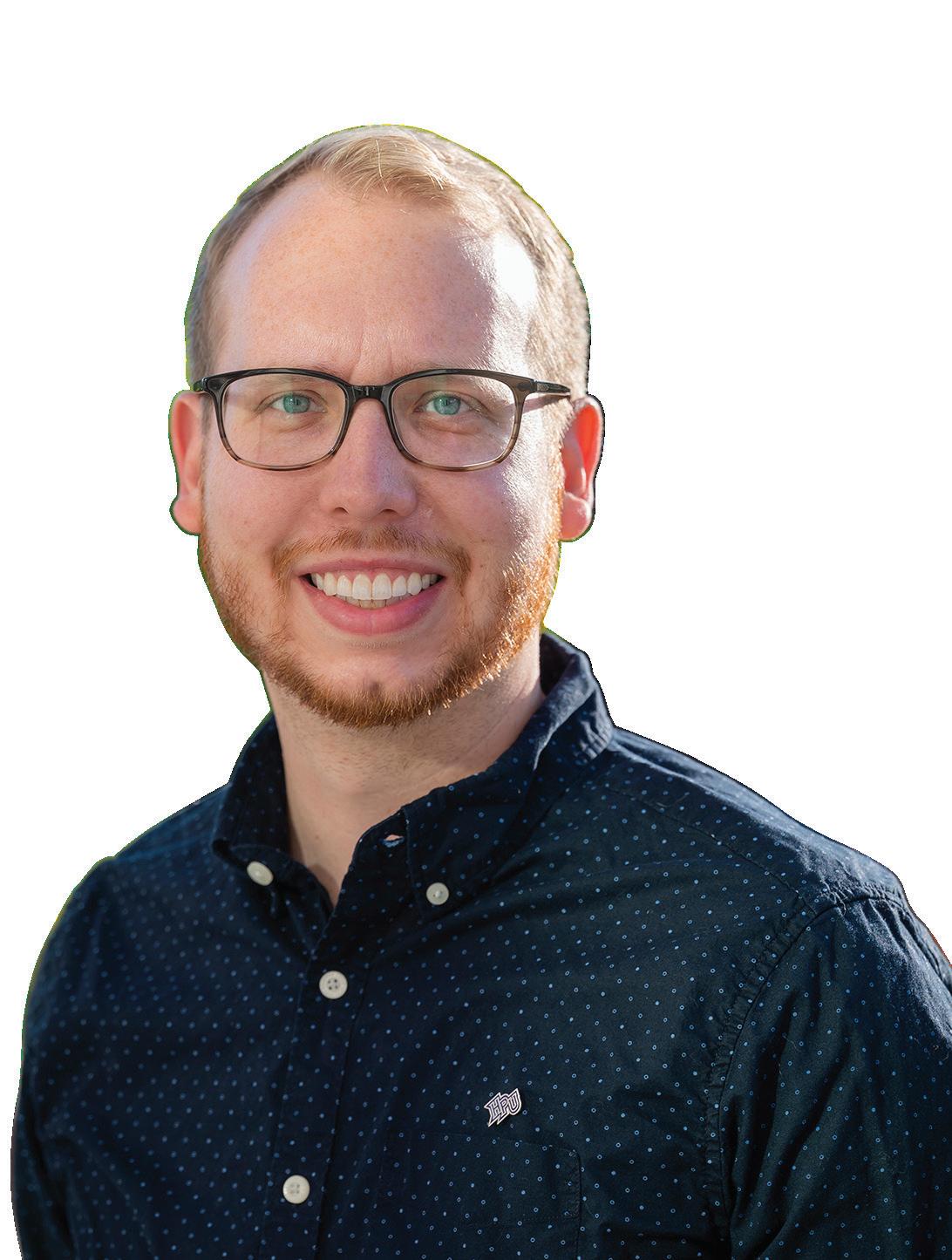
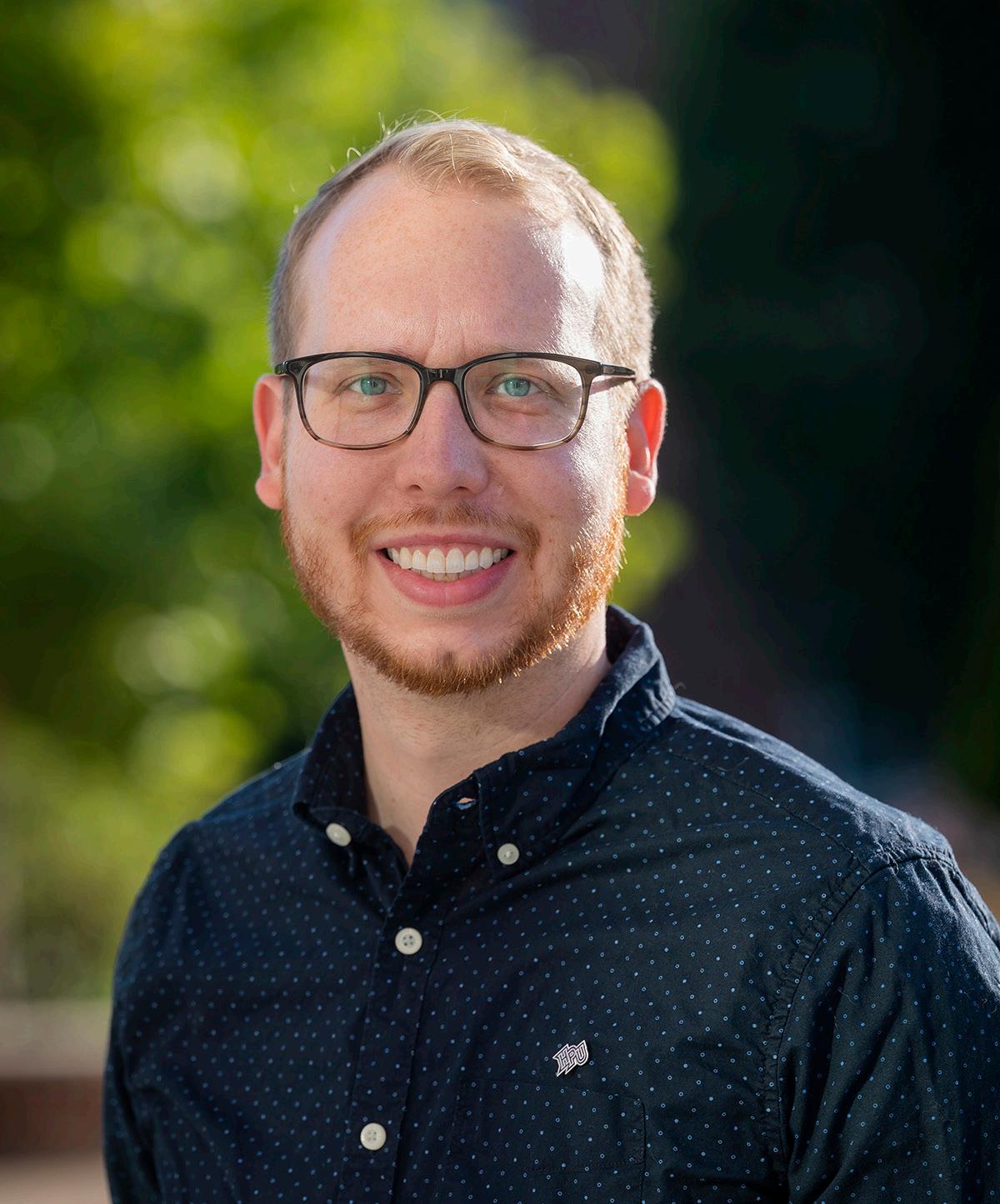
Have you ever wondered how we age? Of course, we all know the signs of aging: graying hair, wrinkled skin, increased disease risk, etc. But why do we all experience these things? What’s happening under the hood of our body’s cells that leads to these changes over time? And is there anything we can do about any of it?
It’s these questions that I and many others are trying to answer in the growing field of “geroscience,” the study of the biology of aging. In my own research, I focus on approaching aging from the molecular level and study how the proteins within our cells change with age, as well as how molecules we obtain from the food we eat may affect our health with age.
What Is Aging?
Before we dive into that, it may be helpful to examine what we actually mean when we say aging. Your “chronological age” is simply the amount of time that has passed from your birth until now. Chronological age moves at the same pace for everyone and everything on the planet, and there isn’t really anything we can do to affect that rate. One year from now, we
will all be one year older in terms of chronological age.
“Biological aging,” also called senescence, is a separate but related concept. It is loosely defined as the gradual breakdown of function in the body over time. While biological age increases with chronological age, it doesn’t have a fixed rate the way that chronological aging does. There are many factors that affect the rate of biological aging and you are probably aware of some of them already. Dietary choices, exercise, tobacco use, and many other lifestyle choices can speed up or slow down the deterioration of function in our bodies that accompanies increasing chronological age. Because of this, one year from now some of us will have increased more in biological age than others.
Why Do We Age?
Now that we’ve talked about what biological aging is, let’s take a look at why we age. After all, it seems strange, doesn’t it? Evolution through natural selection is supposed to result in biological changes that make us better adapted to our environment but biological aging, by its definition, clearly decreases our
32 The Lighted Lamp | 2023
fitness. So, shouldn’t evolution have more or less eliminated biological aging after so many millions of years? What makes aging so inevitable?
The first thing to recognize is that evolution doesn’t generate perfect species; it generates species that are “good enough” to reliably reproduce and thus propagate their genetic material. Accomplishing that requires various compromises due to limited availability of resources. Generally, the signs of aging and the decrease in fitness that accompanies them only become evident at some point after an organism has completed development and reached adulthood. The further an organism gets from the onset of reproductive maturity, the less natural selection pressure there is to make sure it is operating at peak fitness. Afterall, the odds that it has already passed on its DNA just go up the older the organism gets.
So, with natural selection in full force for the period of lifespan leading up to reproductive maturity and then waning after, we can see how biological aging emerges. Species that are likely to face heavy predation or other high risks of death through their early life invest heavily in rapid development to reproductive maturity as an evolutionary strategy and their bodies breakdown rapidly as a result. In contrast, species that are more protected from such external risks delay their reproduction and invest more of their resources in maintaining their bodily functions as part of their genetic programming.
A classic example of this can be seen in comparing mice to the naked mole rate. Both species are rodents and similar in many ways (about three inches long, live in social groups, avoid bright light, etc.) but while the mouse reaches reproductive maturity at just six weeks and has a maximum lifespan of around three
years, the naked mole rat reaches reproductive maturity at six months and can live for decades.1 What is the reason for these differences? Unlike mice that have a host of different predators, naked mole rats live in underground colonies where they are well protected. As a result, they didn’t evolve the rapid reproductive capabilities of mice but instead evolved mechanisms to keep their bodies functioning at a much later age. While biological aging is essentially a universal process, we can see that the rate of biological aging is very different for different species based on their evolutionary history.
Along these same lines, genes that provide traits which are advantageous early in life — ensuring that reproductive maturity is reached — but that cause problems later in life are a good evolutionary tradeoff to make. For example, various hormones and growth factors that are important during development contribute to the formation of cancer later in life.2
All of this illustrates the complexity of biological aging. It’s not controlled by a single gene or factor in the body but rather the interaction of many different gene products and environmental factors, all contributing to the gradual loss of function over time. For this reason, it’s unlikely that we’ll ever find a single “magic bullet” that can truly stop or reverse aging in humans. But on the flip side, it means that there are lots of things we can do to adjust our rate of biological aging and stay healthier for longer. The better we understand the mechanisms of aging, the more we can do to increase human lifespan and reduce the burden of disease. In the rest of this article, I’d like to tell you about some projects students in my lab are working on to help us learn more about the process of biological aging and staying healthier for longer.
doi:10.1016/J.GENDIS.2016.04.002
33 www.highpoint.edu
1J Graham Ruby, Megan Smith, and Rochelle Buffenstein. “Naked mole-rat mortality rates defy gompertzian laws by not increasing with age.” eLife 7 (2018). doi:10.7554/ELIFE.31157
2Sylvia Oghogho Iseghohi, and Kingsley Omage. “How ageing increases cancer susceptibility: A tale of two opposing yet synergistic views.” Genes and Diseases 3, no. 2 (2016): 105-109.
Can the Eye Lens Help Us Understand Aging?
The crystalline lens is the small, circular transparent tissue that exists just behind the iris in our eyes. Picture the kind of glass bead that you would fill a vase with and you have a pretty good idea of what the human lens looks like. However, that simple appearance hides a much more complicated structure and history within it.
Transparency of biological tissue is uncommon and requires very specialized adaptations. The cornea manages it by being extremely thin, but how does the lens — almost a centimeter in diameter in humans — achieve this? The trick is to get rid of all the things we normally expect to find in our cells. The cell nucleus containing our DNA, the mitochondria that provides energy for the cell, and all of the other typical cellular machinery get destroyed in the process of lens fiber cell differentiation. The resulting
mature lens fiber cells that make up most of the lens can’t do normal cell things like build new proteins or divide. Before they lose the ability to do so though, developing lens fiber cells create massive amounts of a group of proteins called crystallins, which help to refract light. The end result is a “biological glass” structure that is highly transparent and that bends incoming light to focus it on the retina so that we can see.
The lens fiber cells develop from a single layer of epithelial cells — a very typical cell type throughout the body — that line the outer surface of the lens on its outward-facing side. As time goes on, the epithelial cells continue to make new fiber cells, putting down new layers on top of the old ones. Because the mature lens fiber cells don’t divide or make new proteins, this process of creating concentric layers of fiber cells generates what we call a “spatiotemporal gradient” in the lens.3 In other
34 The Lighted Lamp | 2023
Oldest Cell/Protein Age Cell/Protein Age Youngest Youngest Suture Suture Lens Nucleus
Epithelia Capsule Anterior Posterior Equator Equator
Mature Fiber Cells
Differentiating Fiber Cells Differentiating Fiber Cells
3Steven Bassnett, Yanrong Shi, and Gijs F. J. M. Vrensen. “Biological glass: structural determinants of eye lens transparency.” Philosophical Transactions of the Royal Society B: Biological Sciences 366, no. 1568 (2011):1250-64. doi:10.1098/RSTB.2010.0302
words, we have brand new cells and proteins at the outer surface of the lens but the deeper you go into the lens, the older the cells and their associated proteins are. At the very center of the lens, we have the cells and their original proteins that were present in the embryo, still existing decades later.
These properties are what make the lens so interesting for studying biological aging. In this single piece of tissue we have cells of many different ages in an orderly arrangement. Just like how we can look at rings within a tree trunk to observe how it has aged, we can take apart the layers of the lens to quantify age-related changes in animals and even humans.
What changes in lens fiber cells as they age?
Well, because the cellular proteins remain throughout all of life, they accumulate certain post-translational modifications over time. Post-translation modifications, or PTMs, are simply changes to the chemical structure of a protein. A PTM you can see develop in real time is the formation of advanced glycation end products when cooking food under high heat. This causes sugar molecules in the food to bind to protein in the food, altering the chemical structure of the proteins and
producing the browning and caramelization of the food we associate with these cooking methods. The same process occurs in the lens and results in pigmentation over time, just at a much slower rate.4
The accumulation of certain PTMs on lens proteins is considered the primary cause of age-related cataract.5 The changes in the chemical structure of lens proteins from PTMs cause them to aggregate and these aggregates block and scatter light rather than focusing it on the retina. This is the cloudiness you see in the pupil of an eye with cataract. The accumulation of damaging PTMs on the proteins of other tissues in the body may also contribute to biological aging, so better understanding this process as it occurs in the lens could help our overall understanding of aging.
A major project in my lab at High Point University consists of analyzing these agerelated changes in PTMs across the different layers of the lens. To do so, we have developed a technique to separate the layers by letting the lens dissolve in a solution containing a small amount of detergent. By collecting this solution at different time points, we can access different layers of the lens, representing different ages of cells. We then analyze the abundance of different PTMs in these samples to determine which PTMs are present, how much each PTM accumulates with age, and on what proteins we see these PTMs.
Initial work using pig lenses has been promising and has resulted in collaborations with researchers at Wake Forest University and the University of Washington who study aging in non-human primates and mice, respectively. By collecting eyes from these aged animals, my
PR070138HSI20070812_074422.PDF

35 www.highpoint.edu
4Xingjun Fan and Vincent M. Monnier. “Protein posttranslational modification (PTM) by glycation: Role in lens aging and agerelated cataractogenesis.” Experimental Eye Research 210 (2021): 108705. doi:10.1016/J.EXER.2021.108705
5Peter G. Hains and Roger J. W. Truscott. “Post-translational modifications in the nuclear region of young, aged, and cataract human lenses.” Journal of Proteome Research 6, no. 10 (2007):3935-3943. doi:10.1021/PR070138H/SUPPL_FILE/
students are able to use the lenses to unveil molecular mechanisms of biological aging in models that are highly relevant to human health.
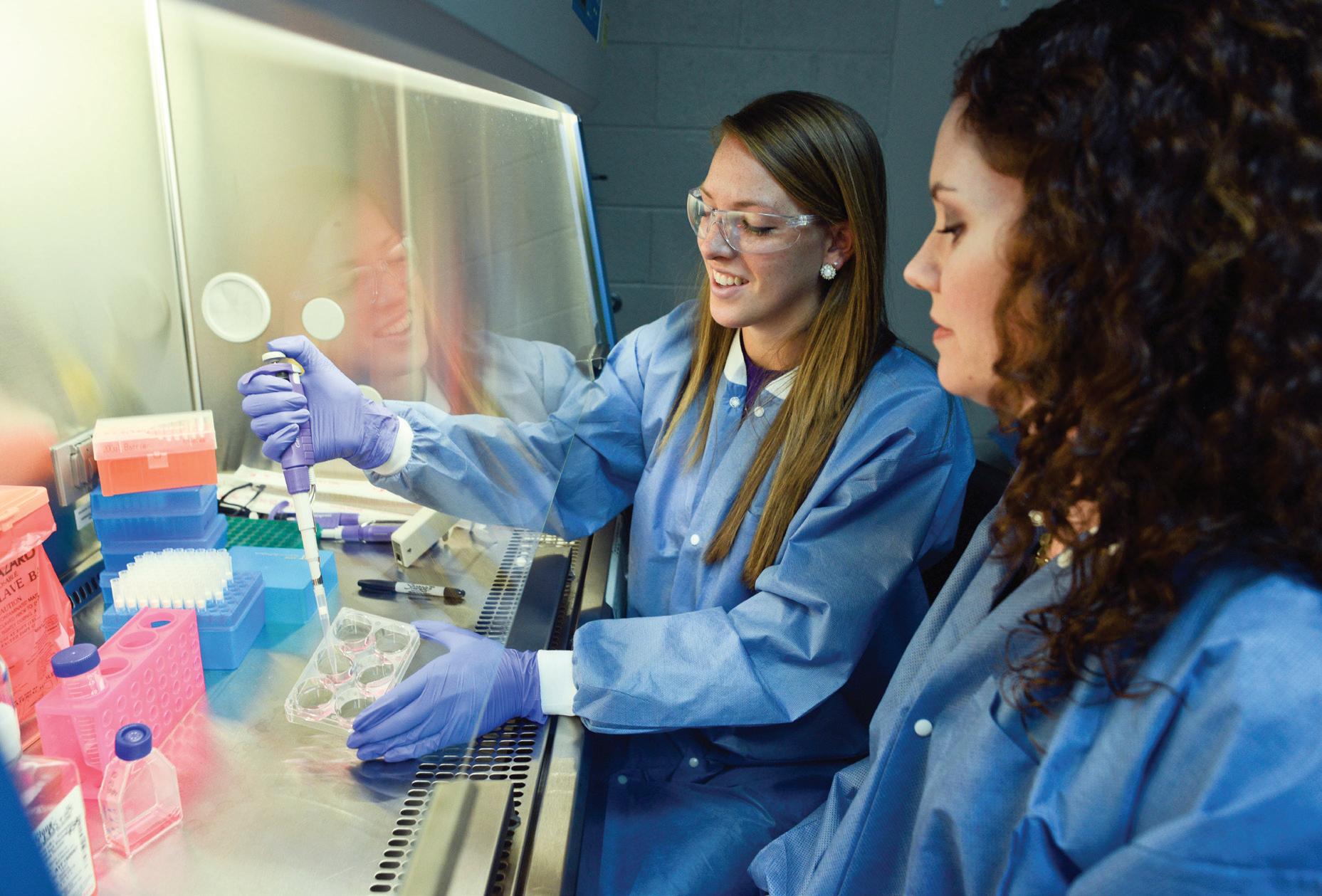
Can Small Molecules in Our Food Aid Healthy Aging?
Nicotinamide adenine dinucleotide (NAD+) is a central molecule in our metabolism. It collects the energy from the nutrients our cells break down by being converted to NADH (oxidized NAD+). NADH then carries this energy to the mitochondria where it can be used to make ATP, the major energy currency of the cell. Additionally, NAD+ and its derivatives are used for many other cellular functions, including antioxidant defense and DNA repair.
What does this have to do with aging? Well, unfortunately, NAD+ levels decline with age and this decline contributes to the loss of
function we see with aging.6 If NAD+ levels could be increased closer to young levels, it could potentially restore function and dampen the effects of biological aging. This can be achieved by providing NAD+ precursors to the body which can then be used to synthesize more NAD+. These precursors include nicotinamide and nicotinic acid, which together are what we call vitamin B3 complex.
More direct precursors of NAD+ are nicotinamide mononucleotide (NMN) and nicotinamide riboside (NR), the latter of which was discovered less than twenty years ago.7 These more direct precursors are effective at raising NAD+ levels and restoring function across a host of different tissues and organs and even extending lifespan in aged model organisms.8 In my own work, I demonstrated that just ten days of NMN supplementation was able to restore high workload systolic heart
6Michael B. Schultz and David A. Sinclair. “Why NAD+ Declines during Aging: It’s Destroyed.” Cell Metabolism 23, no. 6 (2016):965-966. doi:10.1016/J.CMET.2016.05.022
7Pawel Bieganowski and Charles Brenner. “Discoveries of nicotinamide riboside as a nutrient and conserved NRK genes establish a preiss-handler independent route to NAD+ in fungi and humans.” Cell 117, no. 4 (2004):495-502. doi:10.1016/ S0092-8674(04)00416-7
8Kathryn F. Mills, Shohei Yoshida, and Liana R. Stein, et al. “Long-Term Administration of Nicotinamide Mononucleotide Mitigates Age-Associated Physiological Decline in Mice.” Cell Metabolism 24, no. 6 (2016):795-806. doi:10.1016/j. cmet.2016.09.013
36 The Lighted Lamp | 2023
function in two-year-old mice back to that of six-month-old mice9; equivalent to restoring the same heart function in a 70-year old human to that of a 30-year old. Clinical trials involving NR and NMN treatment in human patients are ongoing, with those that have already been completed showing some promising results.10,11
While this clinical research is exciting, it’s also possible to obtain these NAD+ precursors naturally without taking manufactured supplements. Just like the well-characterized forms of vitamin B3, NR and NMN exist in the foods we eat and are able to enter our bodies when we consume them. Unfortunately, very little information exists on how much of these compounds is present in different foods. It’s known that milk is rich in NR12 and that NMN is present to various degrees in a small sampling of foods tested,12 but a comprehensive analysis of these compounds across food groups has never been reported.
Students in my lab, co-mentored with Dr. Megan Rudock, are addressing this gap in the literature by extracting these NAD+ precursors
from food and analyzing their levels. By determining how much NR and NMN exist in different raw ingredients, and then examining how these levels are affected by different cooking and preservation methods, we hope to be able to outline the properties of an “NAD+promoting diet” that can naturally boost NAD+ and promote health later in life.
The Future of Aging Is Bright
These projects are just a few of many in the increasingly vibrant world of geroscience. As I write this, I am preparing to head to the Keystone Symposium on the Molecular Basis of Healthy Aging, where I will hear the latest research updates from renowned scientists and newcomers to the field on topics that range from suspended animation to biological aging clocks to stem cell-based regenerative medicine. I am incredibly grateful that I get to be part of such a dynamic and fascinating field of science, and that I get the opportunity to bring geroscience to High Point University’s students. ❚
9Jeremy A. Whitson, Alessandro Bitto, and Huiliang Zhang, et al. “SS-31 and NMN: Two paths to improve metabolism and function in aged hearts.” Aging Cell 19, no. 10 (2020): e13213. doi:10.1111/acel.1321
10Mario Mehmel, Nina Jovanović, and Urs Spitz. “Nicotinamide Riboside—The Current State of Research and Therapeutic Uses.” Nutrients 12, no. 6 (2020): 1616. doi:10.3390/NU12061616
11Hao Huang. “A Multicentre, Randomised, Double Blind, Parallel Design, Placebo Controlled Study to Evaluate the Efficacy and Safety of Uthever (NMN Supplement), an Orally Administered Supplementation in Middle Aged and Older Adults.” Frontiers in Aging 3 (2022): 851698. doi:10.3389/FRAGI.2022.851698
12Simone Ummarino, Massimo Mozzon, and Federica Zamporlini, et al. “Simultaneous quantitation of nicotinamide riboside, nicotinamide mononucleotide and nicotinamide adenine dinucleotide in milk by a novel enzyme-coupled assay.” Food Chemistry 221 (2017):161-168. doi:10.1016/J.FOODCHEM.2016.10.032
37 www.highpoint.edu
A SELECTION OF FACULTY Scholarly and 2022 - 2023 Creative Works

38 The Lighted Lamp | 2023
BOOKS
Hairston, Kimetta and Tawannah Allen. The Ivory Tower: Perspectives of Women of Color in Higher Education. Lanham, MD: Roman & Littlefield, 2022.
ARTICLES
Adeosun, Samuel O. “Stigma by Association: To What Extent Is the Attitude toward Naloxone Affected by the Stigma of Opioid Use Disorder?” Journal of Pharmacy Practice (2022): 089719002210971-71.
Adeosun, Samuel Olusegun. “Differences in Multiple-Choice Questions of Opposite Stem Orientations Based on a Novel Item Quality Measure.” American Journal of Pharmaceutical Education 87, no. 2 (2023): ajpe8934-ajpe34.
Alcon, C. A., and S. Wang-Price. “Non-Invasive Brain Stimulation and Pain Neuroscience Education in the Cognitive-Affective Treatment of Chronic Low Back Pain: Evidence and Future Directions.” Frontiers in Pain Research 3 (2022): 959609. https://doi.org/10.3389/ fpain.2022.959609.
Alewine, Garrett, Jerrica Knight, Adithya Ghantae, Christina Mamrega, Bashnona Attiah, Robert A. Coover, and Cale D. Fahrenholtz. “Silver Nanoparticles Selectively Treat Neurofibromatosis Type 1-Associated Malignant Peripheral Nerve Sheath Tumors in a Neurofibromin-Dependent Manner.” Journal of Personalized Medicine 12, no. 7 (2022): 108080.
Ballingrud, Gordon D. “The President and the Supreme Court: The Effect of the Prospect of Non-Implementation on Government Success in the Court.” Political Science Quarterly 137, no. 2 (2022): 357-379.
Bell, Ashley, Erin Salcido, Nicole Reichhart, and Joy Moverley. “Multi-Institutional Physician
Assistant Student Perception of Simulated Emergency Room Cases.” The Journal of Physician Assistant Education 33, no. 4 (2022): 291-95. https://doi.org/10.1097/ jpa.0000000000000464. https://journals.lww. com/jpae/Fulltext/2022/12000/Multi_ Institutional_Physician_Assistant_ Student.6.aspx.
Binney, Z., and J. M. Smoliga. “Bad Altitude: Categorizing Elevation Produces Spurious Association with Concussions in the National Football League (NFL).” Journal of Orthopaedic and Sports Physical Therapy 52, no. 10 (2022): 1-16. https://doi.org/10.2519/ jospt.2022.11220. https://www.ncbi.nlm.nih. gov/pubmed/35881704.
Bradley, Courtney L., Sara M. McMillin, Andrew Y. Hwang, and Christina H. Sherrill. “High-Dose Once-Weekly Semaglutide: A New Option for Obesity Management.” Annals of Pharmacotherapy 56, no. 8 (2022): 941-50.
Bradley, Courtney L., Karlie Wieder, and Shaina E. Schwartz. “Shifting from Soap Notes to Consult Notes for Clinical Documentation by Pharmacy Students.” American Journal of Pharmaceutical Education 86, no. 7 (2022): 8781-81.
Brož, M., P. Harmanec, P. Zasche, R. CatalanHurtado, B. N. Barlow, W. Frondorf, M. Wolf, et al. “Towards a Consistent Model of the Hot Quadruple System HD 93206 = QZ Carinæ - II. N-Body Model.” Astronomy & Astrophysics 666 (October 2022): A24. https://doi. org/10.1051/0004-6361/202243596.
39 www.highpoint.edu
Butowicz, C. M., B. D. Hendershot, N. L. Watson, D. I. Brooks, D. L. Goss, R. A. Whitehurst, A. D. Harvey, et al. “Pre-Neuromusculoskeletal Injury Risk Factor Evaluation and PostNeuromusculoskeletal Injury Assessment for Return-to-Duty/Activity Enhancement (Prepare) in Military Service Members: A Prospective, Observational Study Protocol.” Journal of Translational Medicine 20, no. 1 (2023): 619.
Chamberlain, Adam, and Alixandra B. Yanus. “An ‘Urban Voluntary Association’ in the Rural South?: The Growth of the United Daughters of the Confederacy. 1910-1930.” Politics, Groups, and Identities 10, no. 5 (December 2022): 767-787. https://doi.org/10.1080/21565503.20 21.1906284.
Chamberlain, Adam, and Alixandra B. Yanus. “Density Dependence in Economic Sectors in the Progressive Era.” Interest Groups and Advocacy 11, no. 1 (March 2022): 1-25. https:// doi.org/10.1057/s41309-021-00128-x.
Chamberlain, Adam, and Alixandra B. Yanus. “Managing Membership: The Rise and Fall of Federated Voluntary Membership Associations.” Interest Groups and Advocacy 12, no. 1 (March 2023): 1-23. https://doi. org/10.1057/s41309-022-00170-3.
Chamberlain, Adam, and Alixandra B. Yanus. “‘Our One Great Hope’: The Growth of the Woman’s Relief Corps and the Decline of the Grand Army of the Republic.” Armed Forces & Society 43, no. 3 (July 2022): 679-700. https:// doi.org/10.1177/0095327X211001536.
Chamberlain, Adam, and Alixandra B. Yanus. “Shaping the Rise of Brotherhood: Social, Economic, and Political Contexts and the ‘Golden Age of Fraternalism.’” Social Science Quarterly 103, no. 7 (December 2022): 16731686. https://doi.org/10.1111/ssqu.13222.
Cunha, Alexandra L., Shaina E. Schwartz, and Julie B. Cooper. “Practical Approaches to Antipsychotic-Associated Corrected Qt Interval Prolongation in Patients with Serious Mental
Illness: A Review of Cases.” Journal of Pharmacy Practice (2022): 089719002210782-82.
Drake, Kathryn P., Edward J. Fuselier, and Grady B. Wright. “Implicit surface reconstruction with a curl-free radial basis function partition of unity method.” SIAM Journal of Scientific Computing 44, no. 5 (2022), A3018–A3040.
Ebied, Alex M., Jeremiah Jessee, and Shaina Schwartz. “Tricyclic Antidepressant Overdose Manikin Simulation in Student Pharmacists.” Journal of Pharmacy Technology 38, no. 6 (2022): 343-48.
Emerson, Alicia J., Carol A. Courtney, Cory Alcon, and Stephen M. Shaffer. “The Current State of Pain Curricula in Capte Accredited Doctor of Physical Therapy Programs: A 2021 Report.” Pain Medicine 24, no. 4 (2022): 461465. https://doi.org/10.1093/pm/pnac145.
Emerson, A. J., L. Einhorn, M. Groover, G. Naze, and G. D. Baxter. “Clinical Conversations in the Management of Chronic Musculoskeletal Pain in Vulnerable Patient Populations: A Meta-Ethnography.” Disability and Rehabilitation (Oct 7 2022): 1-26. https:// doi.org/10.1080/09638288.2022.2130447. https://www.ncbi.nlm.nih.gov/ pubmed/36205554.
Ferré, Sergi, Annabelle M. Belcher, Jordi Bonaventura, César Quiroz, Marta SánchezSoto, Verònica Casadó-Anguera, Ning-Sheng Cai Estefania Moreno, Comfort A. Boateng, Thomas M. Keck, et al. “Functional and Pharmacological Role of the Dopamine D4 Receptor and Its Polymorphic Variants.” Frontiers in Endocrinology 13 (2022).
Fink, Joey. “Southern Textile Worker Struggles in the Twentieth Century.” Oxford Research Encyclopedia of American History (August 15, 2022). https://doi.org/10.1093/ acrefore/9780199329175.013.861.
Flores-Flores, Oscar, Diego Otero-Oyague,
40 The Lighted Lamp | 2023
Lorena Rey, Alejandro Zevallos-Morales, Gabriela Ramos, Ivonne Carrión, Vanessa Patino, Suzanne L. Pollard, Jose F. Parodi, John R. Hurst, Joseph J. Gallo, Rodney Reynolds. “Agency and mental health among Peruvian older adults during the COVID-19 lockdown.” The Journals of Gerontology: Series B (2023): gbad040, https://doi.org/10.1093/ geronb/gbad040.
Fuselier, Jenny, Ling Long, Ravi Ramakrishna, Holly Swisher, and Fang-Ting Tu. “Hypergeometric Functions Over Finite Fields.” Memoirs of the American Mathematical Society, 280, no. 1382 (2022), https://doi.org/10.1090/ memo/1382.
Garcia, M. C., B. S. Pexa, K. R. Ford, M. J. Rauh, and D. M. Bazett-Jones. “Quantification Method and Training Load Changes in High School Cross-Country Runners across a Competitive Season.” [In eng]. Journal of Athletic Training 57, no. 7 (Jul 01 2022): 672-77. https://doi. org/10.4085/1062-6050-523-21. https://www. ncbi.nlm.nih.gov/pubmed/34902855.
Gosselin, D., and A. Collier. “Commentary on ‘Opportunities for Participation: A Mapping Review of Inclusive Physical Activity for Youth with Disabilities’.” Pediatric Physical Therapy 35, no. 1 (Jan 1 2023): 84. https://doi.org/10.1097/ PEP.0000000000000981. https://www.ncbi.nlm. nih.gov/pubmed/36638034.
Graeber, John, and Mark Setzler. “Gender, American Identity, and Sexism.” Political Science Quarterly 137, no. 4 (2022): 715-740. https://doi.org/10.1002/polq.13418.
Haggard, A. V., J. E. Tennant, F. D. Shaikh, R. Hamel, P. W. Kline, and L. A. Zukowski.
“Including Cognitive Assessments with Functional Testing Predicts Capabilities Relevant to Everyday Walking in Older Adults.” Gait Posture 100 (Feb 2023): 75-81.
https://doi.org/10.1016/j.gaitpost.2022.11.015. https://www.ncbi.nlm.nih.gov/ pubmed/36493686.
Harmanec, P., H. Božić, P. Koubský, S. Yang, D. Ruždjak, D. Sudar, M. Šlechta, M. Wolf, D. Korčákov, P. Zasche, A. Oplištilová, D. Vršnak, H. Ak, P. Eenens, H. Bakiş, V. Bakiş, S. Otero, R. Chini, T. Demsky, B. N. Barlow, et al.“V1294 Aql = HD 184279: A Bad Boy among Be Stars or an Important Clue to the Be Phenomenon?”
Astronomy & Astrophysics 666 (October 2022): A136. https://doi.org/10.1051/00046361/202244006.
Hemby, Scott E., and Scot McIntosh. “Chronic Haloperidol Administration Downregulates Select Bdnf Transcript and Protein Levels in the Dorsolateral Prefrontal Cortex of Rhesus Monkeys.” Frontiers in Psychiatry 14 (2023).
Henry, N. E., A. N. Weart, E. M. Miller, L. D. Feltner, and D. L. Goss. “Normative Data for the Neurocom Sensory Organization Test in United States Military Academy Boxers.” International Journal of Sports Physical Therapy 17, no. 3 (2022): 366-77. https://doi. org/10.26603/001c.32547. https://www.ncbi. nlm.nih.gov/pubmed/35391868.
Hinkle, Jason S., Caroline N. Rivera, and Roger A. Vaughan. “Branched-Chain Amino Acids and Mitochondrial Biogenesis: An Overview and Mechanistic Summary.”
Molecular Nutrition & Food Research 66, no. 20 (01 September 2022): 2200109. https://doi. org/https://doi.org/10.1002/mnfr.202200109. https://onlinelibrary.wiley.com/doi/ abs/10.1002/mnfr.202200109.
Hughes, Nicole M., Simcha Lev-Yadun. “Review: Why do some plants have leaves with red or purple undersides?” Environmental and Experimental Botany 205 (2023): 105126. https://doi.org/10.1016/j. envexpbot.2022.105126.
Hupfer, Elizabeth C. “Humanitarian Nations.” Journal of Global Ethics 18, no. 3 (2022): 312-329. https://doi.org/10.1080/1744 9626.2022.2110141.
41 www.highpoint.edu
Jones, M. A., T. S. George, G. S. Bullock, R. R. Sikora, B. D. Vesely, and D. R. Sinacore. “Biomarkers of Chronic Kidney Disease-Mineral Bone Disorder (Ckd-Mbd) in the Diabetic Foot: A Medical Record Review.” Diabetes Research and Clinical Practice 194 (Dec 2022): 110160. https://doi.org/10.1016/j.diabres.2022.110160. https://www.ncbi.nlm.nih.gov/ pubmed/36410557.
Kemerly, Tony. “Man, Interrupted: A Bodily Journey toward Maleness.” [In English]. Journal of Bodies, Sexualities, and Masculinities 3, no. 2 (01 Sep. 2022): 54-75. https://doi.org/10.3167/ jbsm.2022.030204. https://www. berghahnjournals.com/view/journals/jbsm/3/2/ jbsm030204.xml.
Kemerly, Tony. “Will the Odds Ever Be in Her Favor? Katniss Everdeen and the Female Athlete.” Dialogue: The Interdisciplinary Journal of Popular Culture and Pedagogy 9 9, no. 3 (2022): 16-26. http://journaldialogue.org/ issues/v9issue-3/will-the-odds-ever-be-in-herfavor-katniss-everdeen-and-the-femaleathlete/.
Kline, P. W., H. C. Davis-Wilson, N. F. So, T. T. Fields, and C. L. Christiansen. “Feasibility of Repeated Session Error-Augmentation Gait Training for People with Nontraumatic Transtibial Amputation.” Prosthetics and Orthotics International 46, no. 6 (Aug 25 2022): 553-59. https://doi.org/10.1097/ PXR.0000000000000181. https://www.ncbi. nlm.nih.gov/pubmed/36037273.
Koba, Timothy. “Making an exit: factors determining a successful private equity or venture capital exit in sport businesses.” Sports Innovation Journal 4, no. 1 (2023): 17-35.
Kunzmann, Egon, Kevin R. Ford, Dai Sugimoto, Arnold Baca, Mikulas Hank, David Bujnovsky, Lucia Mala, Frantisek Zahalka, and Tomas Maly. “Differences in External and Internal Load in Elite Youth Soccer Players within Different Match Timing Zones.” Applied Sciences 12, no. 14 (2022): 7230. https://doi.org/10.3390/
app12147230. https://mdpi-res.com/d_ attachment/applsci/applsci-12-07230/article_ deploy/applsci-12-07230.pdf?version= 1658147669.
Lambert, Claire, Joy Myers, Christy Howard, and Melissa Adams-Budde. “Small Moves: New Teachers’ Perceptions of Authoritative Discourse.” Journal of Literacy Research (2023). https://doi.org/10.1177/108629 6x231163122.
Laster, Barbara, Melinda Butler, Rachael Waller, Sheri Vasinda, Mary Hoch, Pelusa Orellana, Joan Rhodes, Teresa Deeney, Debbie Scott, Tiffany Gallagher, Leslie Cavendish et al. “Literacy Clinics During COVID-19: Voices that Envision the Future.” Literacy Research and Instruction (2022):1-25. DOI:10.1080/1938807 1.2022.2134064.
Leclercq, Virginia. “Reforming Pleasure: Working-Class Aesthetic Experience in Émile Zola’s L’Assommoir.” Nineteenth-Century Contexts 44, no. 2 (2022): 143-157. https://doi. org/10.1080/08905495.2022.2054610.
Lenze, E. J., M. Voegtle, J. P. Miller, B. M. Ances, D. A. Balota, D. Barch, C. A. Depp, et al (D. R. Sinacore). “Effects of Mindfulness Training and Exercise on Cognitive Function in Older Adults: A Randomized Clinical Trial.” JAMA 328, no. 22 (Dec 13 2022): 2218-29.
https://doi.org/10.1001/jama.2022.21680. https://www.ncbi.nlm.nih.gov/ pubmed/36511926
https://jamanetwork.com/journals/jama/ articlepdf/2799406/jama_lenze_2022_ oi_220128_1670262088.06091.pdf.
Lueders, Brianna, Bradley C. Kanney, Martina J. Krone, Nicholas P. Gannon, and Roger A. Vaughan. “Effect of Branched-Chain Amino Acids on Food Intake and Indicators of Hunger and Satiety — a Narrative Summary.” Human Nutrition & Metabolism 30 (2022/12/01/ 2022): 200168. https://doi.org/https://doi. org/10.1016/j.hnm.2022.200168. https://www. sciencedirect.com/science/article/pii/ S2666149722000317.
42 The Lighted Lamp | 2023
Lundin, Pamela M., Briana L. Fiser, Meghan S. Blackledge, Hannah L. Pickett, and Abigail L. Copeland. “Functionalized Self-Assembled Monolayers: Versatile Strategies to Combat Bacterial Biofilm Formation.” Pharmaceutics 14, no. 8 (2022): 1613. https://doi.org/10.3390/ pharmaceutics14081613.
Lynch, Shaun. “Using Evidence-Based Education to Guide Better Practice.” The Journal of Physician Assistant Education 33, no. 2 (2022): 139-41. https://doi.org/10.1097/ jpa.0000000000000433. https://journals.lww. com/jpae/Fulltext/2022/06000/Using_ Evidence_Based_Education_to_Guide_ Better.14.aspx.
Mabry, L. M., R. Severin, A. S. Gisselman, M. D. Ross, T. E. Davenport, B. A. Young, A. P. Keil, and D. L. Goss. “Physical Therapists Are Routinely Performing the Requisite Skills to Directly Refer for Musculoskeletal Imaging: An Observational Study.” Journal of Manual and Manipulative Therapy 30, no. 5 (Oct 2022): 261-72. https:// doi.org/10.1080/10669817.2022.2106729.
https://www.ncbi.nlm.nih.gov/ pubmed/35968741.
Mala, L., M. Hank, P. Stastny, F. Zahalka, K. R. Ford, P. Zmijewski, D. Bujnovsky, M. Petr, and T. Maly. “Elite Young Soccer Players Have Smaller Inter-Limb Asymmetry and Better Body Composition Than Non-Elite Players.” Biology of Sport 40, no. 1 (Jan 2023): 265-72. https://doi.org/10.5114/ biolsport.2023.114840.
https://www.ncbi.nlm.nih.gov/ pubmed/36636184
https://www.termedia.pl/Journal/-78/pdf 46705-10?filename=22_02405_Article.pdf.
Marrs, R. P., H. S. Covell, A. T. Peebles, K. R. Ford, J. M. Hart, and R. M. Queen. “Using Load Sensing Insoles to Identify Knee Kinetic Asymmetries During Landing in Patients with an Anterior Cruciate Ligament Reconstruction.”
Clinical Biomechanics 104 (Mar 15 2023): 105941. https://doi.org/10.1016/j. clinbiomech.2023.105941.
https://www.ncbi.nlm.nih.gov/ pubmed/36958202.
Mayer, P., P. Harmanec, P. Zasche, M. Brož, R. Catalan-Hurtado, B. N. Barlow, W. Frondorf, et al. “Towards a Consistent Model of the Hot Quadruple System HD 93206 = QZ Carinæ - I. Observations and Their Initial Analyses.” Astronomy & Astrophysics 666 (October 2022): A23. https://doi.org/10.1051/00046361/202142108.
Mayl, Jonathan J., Vaala, Sarah E., Patel, Paula V., Ritter, Matthew B., and Richardson, Karl M. “Media Multitasking in Medical Students: A Theory-Based Approach to Understanding this Behavior.” Teaching and Learning in Medicine (2022): 1-12.
Melendez, Diamond R., Courtney L. Bradley, Sun Lee, and Christina H. Sherrill. “Transition from in-Person to Telehealth Standardized Patient Encounters: A Retrospective Analysis of 18 Cases.” Currents in Pharmacy Teaching and Learning 14, no. 12 (2022): 1518-24.
Mironova, Vera, and Sam Whitt. “Due Process and Accountability Under Transitional Justice: Evidence from Mosul, Iraq.” Journal of Conflict Resolution 66, no. 9 (2022): 1650-1675.
Morelli, N., S. M. Parry, A. Steele, M. Lusby, A. A. Montgomery-Yates, P. E. Morris, and K. P. Mayer. “Patients Surviving Critical Covid-19 Have Impairments in Dual-Task Performance Related to Post-Intensive Care Syndrome.” [In eng]. Journal of Intensive Care Medicine 37, no. 7 (Jul 2022): 890-98. https://doi. org/10.1177/08850666221075568. https:// www.ncbi.nlm.nih.gov/pubmed/35072548.
Moses, Robert. “Aid Among Greco-Roman Associations and Christ Groups.”
In Associations, Deities, and Early Christianity, edited by Bruce Longenecker, 171-186. Waco, TX: Baylor University Press, 2022.
Myers, Joy, Claire Lambert, and Christy Howard. “Examining Novice Teachers’
43 www.highpoint.edu
Professional Identities: A Longitudinal Study.” Teacher Education Quarterly, 49, no. 3 (2022): 6-26.
Nagy, Laura M., Mackenzie L. Shanahan, and Sara P. Seaford. “Examining the relationship between rumination and non-suicidal selfinjury: A meta-analysis.” Journal of Clinical Psychology 79, no. 1 (March 2023): 7-27.
Pampush, J.D., P. E. Morse, E. J. Fuselier, M. M. Skinner, and R. F. Kay. “Sign-oriented Dirichlet Normal Energy: Aligning Dental Topography and Dental Function in the R-package molar.” Journal of Mammalian Evolution 29, no. 4 (2022): 713-732.
Peek, K., K. R. Ford, G. D. Myer, T. E. Hewett, and E. Pappas. “Effect of Sex and Maturation on Knee Extensor and Flexor Strength in Adolescent Athletes.” The American Journal of Sports Medicine 50, no. 12 (Oct 2022): 328085. https://doi.org/10.1177/0363546522
1118081. https://www.ncbi.nlm.nih.gov/ pubmed/35993482.
Renukuntla, Jwala, Samuel Peterson-Sockwell, Bradley A. Clark, Nipunika H. Godage, Emanuela Gionfriddo, Pradeep Kumar Bolla, and Sai HS Boddu. “Design and Preclinical Evaluation of Nicotine–Stearic Acid ConjugateLoaded Solid Lipid Nanoparticles for Transdermal Delivery: A Technical Note.” Pharmaceutics 15, no. 4 (2023): 1043.
Renukuntla, Jwala, Sushesh Srivatsa Palakurthi, Pradeep Kumar Bolla, Bradley A. Clark, Sai HS Boddu, Prashanth Manda, Samuel Sockwell, Nitin B. Charbe, and Srinath Palakurthi. “Advances in In-vitro bioequivalence testing methods for complex ophthalmic generic products.” International Journal of Pharmaceutics (2022): 122209.
Rivera, Caroline N., Madison M. Kamer, Madison E. Rivera, Rachel M. Watne, Trent C. Macgowan, Andrew J. Wommack, and Roger A. Vaughan. “Insulin Resistance Promotes Extracellular Bcaa Accumulation without
Altering Lat1 Content, Independent of Prior Bcaa Treatment in a Myotube Model of Skeletal Muscle.” Molecular and Cellular Endocrinology 559 (2023): 111800. https://doi.org/https://doi. org/10.1016/j.mce.2022.111800. https://www. sciencedirect.com/science/article/pii / S0303720722002489.
Rivera, Caroline N., Rachel M. Watne, Zoe A. Brown, Samantha A. Mitchell, Andrew J. Wommack, and Roger A. Vaughan. “Effect of Ampk Activation and Glucose Availability on Myotube Lat1 Expression and Bcaa Utilization.” Amino Acids 55, no. 2 (2023/02/01 2023): 275-86. https://doi.org/10.1007/s00726-02203224-7. https://doi.org/10.1007/s00726-02203224-7.
Rosenfeld, S. A. “Bone Craft Production at Chavin de Huantar, Peru.” Senri Ethnological Studies112 (2023): 89-106. http://doi. org/10.15021/00010046.
Rosenfeld, Silvana. “Of Guinea Pigs and Mines: Changing Access to Animal Consumption at Chavín de Huántar (Peru).” The Latin Americanist 67, no. 1 (2023): 62-77. https://muse.jhu.edu/article/886178.
Sayre, Matthew P. “Paleoethnobotanical Remains from Chavín de Huántar, Peru.” Senri Ethnological Studies 112 (2023): 107-125. http://doi.org/10.15021/00010047.
Schaffenroth, V., I. Pelisoli, B. N. Barlow, S. Geier, and T. Kupfer. “Hot Subdwarfs in Close Binaries Observed from Space - I. Orbital, Atmospheric, and Absolute Parameters, and the Nature of Their Companions.” Astronomy & Astrophysics 666 (October 2022): A182. https://doi.org/10.1051/00046361/202244214.
Schmitz, R. J., K. R. Ford, B. Pietrosimone, S. J. Shultz, and J. B. Taylor. “ACL Research Retreat Ix Summary Statement: The Pediatric Athlete, March 17-19, 2022; High Point, North Carolina.” Journal of Athletic Training 57, no. 9-10 (Sep 1 2022): 990-95. https://doi.org/10.4085/1062-
44 The Lighted Lamp | 2023
6050-0219.22. https://www.ncbi.nlm.nih.gov/ pubmed/36638340.
Schneid, Frederick C. “Master Narratives in Military History: Europe 1789 to 1900.” War & Society 42, no. 1 (February 2023): 44-51.
Schwartz, Shaina, Christina Carilli, Taimur Mian, Laura Ruekert, and Archana Kumar. “Attitudes and Perceptions About the Use of Long-Acting Injectable Antipsychotics among Behavioral Health Practitioners.” Mental Health Clinician 12, no. 4 (2022): 232-40.
Schwartz, Shaina, Sun Lee, Erin Baily Coble, Colton Troxler, Samantha Toscano, and Archana Kumar. “Time-to-Therapy Discontinuation in Patients Newly Diagnosed with Schizophrenia Initiated on Long-Acting Injectable Versus Oral Dopamine Receptor Blocking Agents.” Early Intervention in Psychiatry (2023).
Shaffer, S. M., and G. S. Naze. “Evaluation and Management of Temporomandibular Disorders. Part 1: An Orthopedic Physical Therapy Update on Examination and Clinical Reasoning.” Journal of Manual and Manipulative Therapy (Oct 17 2022): 1-10.
https://doi.org/10.1080/10669817.2022.21231
71. https://www.ncbi.nlm.nih.gov/ pubmed/36245265.
Shaffer, S. M., and G. S. Naze. “Evaluation and Management of Temporomandibular Disorders. Part 2: An Orthopaedic Physical Therapy Update on Examination and Clinical Reasoning.” Journal of Manual and Manipulative Therapy (Sep 28 2022): 1-10.
https://doi.org/10.1080/10669817.2022.21246
17. https://www.ncbi.nlm.nih.gov/ pubmed/36171740.
Shkliarov, Vitali, Vera Mironova, and Sam Whitt. “Legacies of Stalin or Putin? Public Opinion and Historical Memory in Ukraine.” Political Research Quarterly 75, no. 4 (2022): 966-981.
Shultz, S. J., M. R. Cruz, E. Casey, T. P. Dompier, K. R. Ford, B. Pietrosimone, R. J. Schmitz, and J.
B. Taylor. “Sex-Specific Changes in Physical Risk Factors for Anterior Cruciate Ligament Injury by Chronological Age and Stages of Growth and Maturation from 8 to 18 Years of Age.” Journal of Athletic Training 57, no. 9-10 (Sep 1 2022): 830-76. https://doi. org/10.4085/1062-6050-0038.22. https://www. ncbi.nlm.nih.gov/pubmed/36638346.
Sinacore, D. R. “Dem Bones, Dem Bones, Dem Foot Bones: Recognizing the Foot Bone-Kidney Connection.” Orthopedic Physical Therapy Practice 34, no. 3 (2022): 182-84.
Smith, Bryce A., Brad N. Barlow, Benjamin Rosenthal, J. J. Hermes, and Veronika Schaffenroth. “Pulse Timing Discovery of a Three-Day Companion to the Hot Subdwarf BPM 36430.” The Astrophysical Journal 939, no. 1 (2022): 57. https://doi.org/10.3847/15384357/ac9384.
Smoliga, J. M. “Monkeypox Virus Outbreak: Implications for the Physical Therapy and Rehabilitation Community.” Physical Therapy (Oct 27 2022). https://doi.org/10.1093/ptj/ pzac148. https://www.ncbi.nlm.nih.gov/ pubmed/36300288.
Smoliga, J. M. “Mpox and Monkeypox Virus: Special Considerations for Athletes in Contact Sports.” Sports Medicine (Feb 27 2023). https:// doi.org/10.1007/s40279-023-01812-5.
Smoliga, J. M., W. O. Roberts, and A. S. Tenforde. “Kids on the Run — Is Marathon Running Safe for Children?” JAMA Pediatrics (Oct 3 2022). https://doi.org/10.1001/ jamapediatrics.2022.3464.
Smoliga, James M., Z. Taggart Wilber, and Brooks Taylor Robinson. “Premature Death in Bodybuilders: What Do We Know?” Sports Medicine (January 2023). https://doi.org/10.1007/s40279-022-01801-0.
Stratton, Brandy-Fey C., Angelina J. Pierre, Elizabeth A. Riser, Nathan J. Grinalds, Charles
45 www.highpoint.edu
W. Edwards, Anna M. Wohlwend, Jacob S. Bauer, Rachel J. Spera, Lauren S. Pferdmenges, Kaitlyn M. Griffith, Brandon W. Hunter, Petia Bobadova-Parvanova, Cynthia S. Day, Pamela M. Lundin, and Keir H. Fogarty. “Synthesis and Optical Characterization of a Rhodamine B Spirolactam Dimer.” The Journal of Physical Chemistry A 126, no. 26 (2022): 4211–20. https://doi.org/10.1021/acs.jpca.2c02665.
Taylor, J. B., A. D. Nguyen, A. E. Westbrook, A. Trzeciak, and K. R. Ford. “Women’s College Volleyball Players Exhibit Asymmetries During Double-Leg Jump Landing Tasks.” Journal of Sport Rehabilitation (Aug 8 2022): 1-6. https:// doi.org/10.1123/jsr.2022-0026.
Taylor-Haas, Jeffery, Micah C. Garcia, Mitchell J. Rauh, Shelby Peel, Mark V. Paterno, David M. Bazett-Jones, Kevin R. Ford, and Jason T. Long. “Cadence in Youth Long-Distance Runners Is Predicted by Leg Length and Running Speed.” SSRN Electronic Journal (2022). https://doi. org/10.2139/ssrn.4125373.
Taylor-Haas, J. A., M. C. Garcia, M. J. Rauh, S. Peel, M. V. Paterno, D. M. Bazett-Jones, K. R. Ford, and J. T. Long. “Cadence in Youth LongDistance Runners Is Predicted by Leg Length and Running Speed.” Gait Posture 98 (Oct 2022): 266-70. https://doi.org/10.1016/j. gaitpost.2022.09.085.
Thomas, Payton M., Margaret A. Deming, and Aurijit Sarkar. “Β-Lactamase Suppression as a Strategy to Target Methicillin-Resistant Staphylococcus Aureus: Proof of Concept.” ACS Omega 7, no. 50 (2022): 46213-21.
Tzavaras, Andrew. “Two Perceptions of Süleyman’s ‘Magnificent’ Navy during the Later Italian Wars.” War & Society 42, no. 2 (May 2023): 123-139.
Vaala, Sarah E., Matthew B. Ritter, and Deepak Palakshappa. “Framing Effects on US Adults’ Reactions to COVID-19 Public Health Messages: Moderating Role of Source Trust.” American Behavioral Scientist (2022): 1-25.
Viering, Brianna, Taylor Cunningham, Ashley King, Meghan S. Blackledge, and Heather B. Miller. “Brominated Carbazole with Antibiotic Adjuvant Activity Displays Pleiotropic Effects in MRSA’s Transcriptome.” ACS Chemical Biology 17, no. 5 (2022): 1239–48. https://doi. org/10.1021/acschembio.2c00168.
Walker, Allison. “Signs: Snapshots from Our Pandemic Years.” Journal of Multimodal Rhetorics: Carework and Writing 6, no. 2 (2022). http://journalofmultimodalrhetorics. com/6-2-issue-intro.
Wendland, D. M., P. W. Kline, K. L. Bohnert, T. M. Biven, and D. R. Sinacore. “Offloading of Diabetic Neuropathic Plantar Ulcers: Secondary Analysis of Step Activity and Ulcer Healing.” Advances in Skin and Wound Care 36, no. 4 (Apr 1 2023): 194-200. https://doi. org/10.1097/01.ASW.0000919476.24220.cc.
Wendland, D. M., P. W. Kline, L. Simmons, and D. R. Sinacore. “The Effect of Exercise, Physical Activity, Stepping Characteristics, and Loading on Diabetic Foot Ulcer Healing: A Systematic Review.” Wounds 35, no. 1 (Jan 2023): 9-17. https://doi.org/10.25270/wnds/22007.
Winkel, Adam L. “‘A good goal can’t be told’: Narration and memory in the soccer stories of Pablo Santiago Chiquero.” TEXT 26, no. 67 (2022): 1-13. https://doi.org/10.52086/ 001c.37819.
Winkel, Adam L. “No Limits: The Control of Urban Space in Surcos/Furrows (Nieves Conde, 1951) and Los golfos/The Delinquents (Saura, 1959).” Studies in Spanish & Latin American Cinemas 19, no. 2 (June 2022): 227-41. https:// doi.org/10.1386/slac_00084_1.
Yoshino, Mihoko, Jun Yoshino, Gordon I. Smith, Richard I. Stein, Adam J. Bittel, Daniel C. Bittel, Dominic N. Reeds, et. al. (D.R. Sinacore).
“Worksite-Based Intensive Lifestyle Therapy Has Profound Cardiometabolic Benefits in People with Obesity and Type 2 Diabetes.” Cell Metabolism 34, no. 10 (2022/10/04/ 2022):
46 The Lighted Lamp | 2023
1431-41.e5. https://doi.org/https://doi. org/10.1016/j.cmet.2022.08.012.
Zasche, Petr, David Vokrouhlický, Brad N. Barlow, and Martin Mašek. 2023. “V907 Sco Switched to the Eclipsing Mode Again.” The Astronomical Journal 165, no. 3 (2023): 81. https://doi.org/10.3847/1538-3881/acae95.
Zhou, Jenny, Christina H. Sherrill, Andrew Y. Hwang, and Sun Lee. “Association between Mental Health and Self-Care Behavior among Older Adults with Diabetes According to Behavioral Risk Factor Surveillance System 2019.” Primary Care Diabetes (2023).
Zukowski, L. A., S. A. Brinkerhoff, G. Iyigun, J. A. Roper, C. A. Giuliani, and P. Plummer. “Fall History in Older Adults Impacts Acceleration Profiles after a near Collision with a Moving Pedestrian Hazard.” Aging Clinical and Experimental Research 35, no. 3 (Mar 2023): 621-31. https://doi.org/10.1007/s40520-02302345-7.
Zukowski, L. A., F. D. Shaikh, A. V. Haggard, and R. N. Hamel. “Acute Effects of Virtual Reality Treadmill Training on Gait and Cognition in Older Adults: A Randomized Controlled Trial.” PLoS One 17, no. 11 (2022): e0276989. https:// doi.org/10.1371/journal.pone.0276989.
47 www.highpoint.edu
BOOK CHAPTERS
Allen, Tawannah. “Moving Toward an Equitable Approach to STEM Education for Minority Males.” In Young, Gifted and Missing, edited by Anthony Robins, Locksley Knibbs, Ted Ingram, Michael Weaver, and Adriel Hilton, 163-181. Bingley: Emerald Publishing Limited, 2022. https://doi.org/10.1108/S1479364420220000025012.
Black, Jeremy, Frederick C. Schneid, Alexander Mikaberidze, and John H. Gill, “Logistics in the Napoleonic Wars.” In The Cambridge History of the Napoleonic Wars, edited by Bruno Colson and Alexander Mikaberidze, 231-254. Cambridge University Press, 2023.
Donaldson, M. B., and A. J. Emerson. “Clinical History in Patients with Lower Quadrant Pain.” In Hip and Knee Pain Disorders, edited by M. Benoy, C. A. Courtney and C. Fernandez-de-lasPenas, Edinburgh, Handspring, 2022.
Hall, Stefan. “Acceptable Tactical Losses: Board Games and Video Games.” In The Routledge Handbook of Star Trek, edited by Leimar GarciaSiino, Sabrina Mittermeier, and Stefan Rabitsch, 198-203. Oxfordshire, England: Routledge, 2022.
Koba, Timothy. “Sport Economics and Finance.” In El Libro de la Gerencia Deportiva, edited by Lopez de D’Amico, Editorial Kinesis, 2022.
Lewis, Dandrielle. “Triple Threat: Thriving as a Black Woman Mathematician.” In The Ivory Tower: Perspectives of Women of Color in Higher Education, edited by Kimetta R. Hairston and Tawannah G. Allen, 171-184. Lanham, MD: Rowman & Littlefield Publishers, 2022.
Martin, Hannah I., Vidushi Agnihotri, Ragothaman M. Yennamalli, and Aurijit Sarkar. “A Beginner’s Guide to Measuring Binding Affinity During Biomolecular Interactions.”
In Basic Biotechniques for Bioprocess and Bioentrepreneurship, 259-70: Elsevier, 2023.
Nagy, Laura M., Kelly E. Polk, Ethan Muckerheide. “Self-criticism in Anger, Aggression, and Violence.” In Anger, Aggression, and Violence: Causes, Pathology, and Treatments, edited by Colin Martin, Victor R. Preedy, and Vinood B. Patel, Springer, 2023.
Nixon Bianca, Diamond Melendez, and Comfort Boateng. “Resilience: A Prideful Term of Perseverance and Descriptor of Unspoken Challenges Endured” In The Ivory Tower — Perspective of Women of Color in Higher Education, edited by Kimetta R. Hairston and Tawannah G. Allen, 39-53. Lanham, MD: Rowman & Littlefield Publisher, 2022.
Ritter, Matthew and Sarah Vaala. “Advertising effects on behavior.” In Encyclopedia of Child and Adolescent Health, edited by Bonnie Halpern-Fisher, 314-324. Elsevier, 2023.
Sayre, M. and S. Rosenfeld. A River Runs through it: Ritual and Inequality in the La Banda Sector of Chavín de Huantar. In Reconsidering the Chavín Phenomenon in the Twenty-First Century, edited by Richard L. Burger and Jason Nesbitt. Dumbarton Oaks, Trustees for Harvard University, 2023.
Schneid, Frederick. “Campaigns in Italy, 17961797 and 1800.” In The Cambridge History of the Napoleonic Wars, edited by Bruno Colson and Alexander Mikaberidze, 327-354. Cambridge University Press, 2023.
Schneid, Frederick. “Campaigns in Prussia and Poland, 1806-1807.” In The Cambridge History of the Napoleonic Wars, edited by Bruno Colson and Alexander Mikaberidze, 381-408. Cambridge University Press, 2023.
Schneid, Frederick. “The French Cavalry at Austerlitz: Data and Narrative.” In The Changing Face of Old Regime Warfare, edited by Alex Burns, 121-139. Warwick, Helion & Co, 2022.
Vescio, Bryan. “Pragmatism and the Tragic Sense of Death.” In The Ethics of Richard Rorty: Moral Communities, Self-Transformation, and
48 The Lighted Lamp | 2023
Imagination, edited by Susan Dieleman, David E. McClean, and Paul Showler, 181-92. New York: Routledge, 2022.
Vescio, Bryan. “The Road to Okay: McCarthy’s Ironic Meliorism.” In Carrying the Fire: Cormac McCarthy’s The Road and the Apocalyptic Tradition, Volume 2: Genre and Intertextuality, edited by Rick Wallach and Scott Yarbrough, 104-16. Cormac McCarthy Society, 2022.
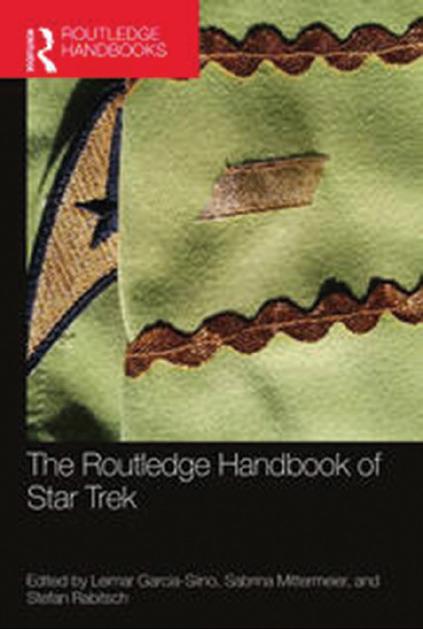
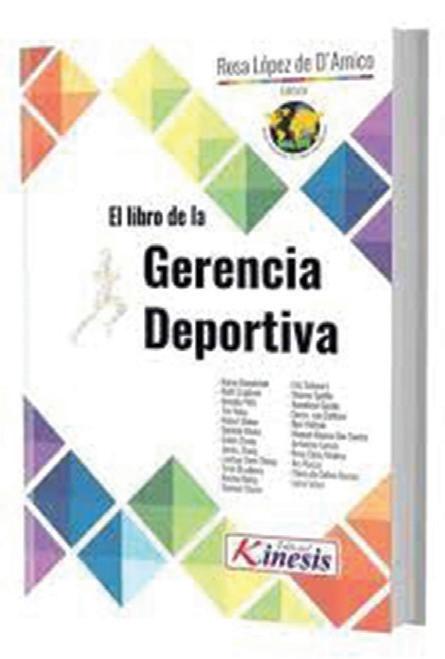
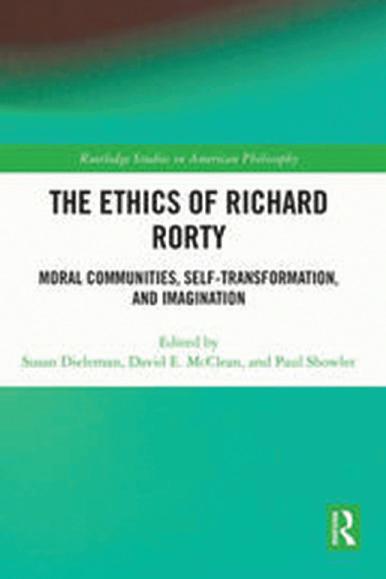
Walker, Allison. “Empathy.” Contributions of Civic and Community Engagement Series. North Carolina Campus Engagement. February 15, 2023.
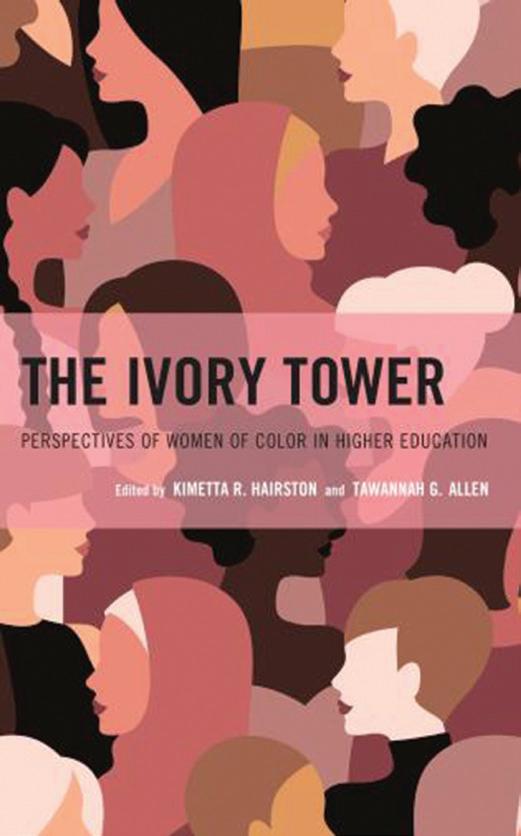
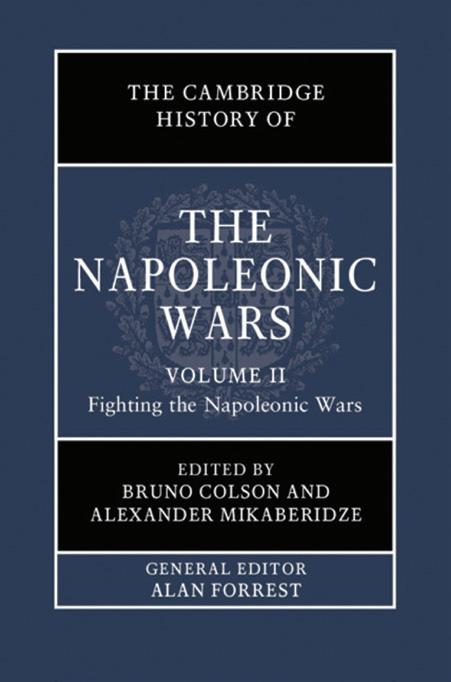
Walker, Allison. “First Do No Harm: Experiential Empathy Adventures in the Writing Classroom and Beyond.” In Teaching Writing in the Health Professions: Perspectives, Problems, and Practices, edited by Michael Madson. Routledge, 2023.
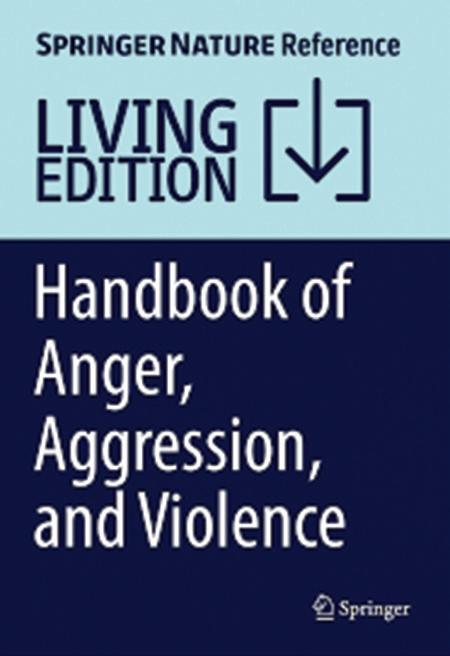


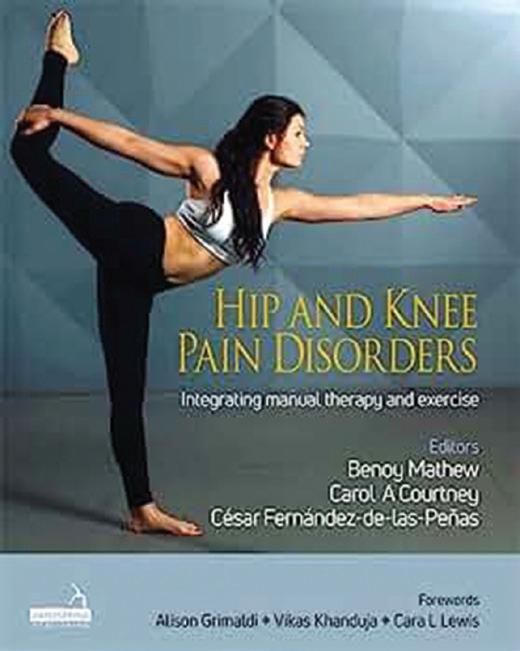
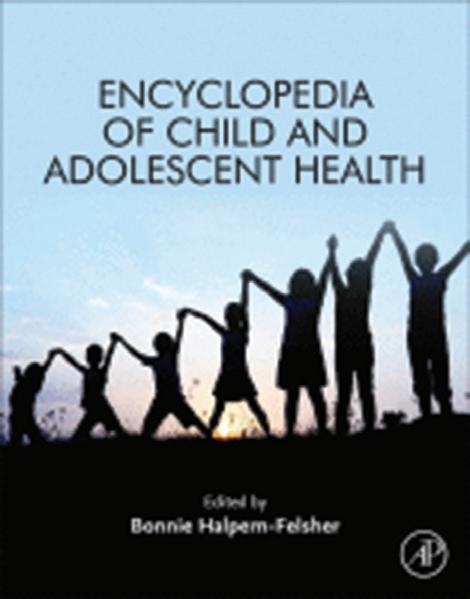
49 www.highpoint.edu
CREATIVE WORKS
Visual
Brown, Mark E. babel. Things Unseen. Gainesville Fine Arts Association, Gainesville, FL. Jurors: Dina Sherman, Artist and Jesus Fuenmayor, Curator, University Gallery, University of Florida. 2022.
Brown, Mark E. kurinuki guinomi. The Humble Cup. Louise Hopkins Underwood Center for the Arts, Lubbock, TX. Juror: Dexter Woods, Ceramic Artist. 2022.
Brown, Mark E. kurinuki guinomi. 8th Annual Dirty South Cup Exhibition. River Oaks Square Art Center, Alexandria, LA. Juror: Renee LoPresti, Ceramic Artist. 2022.
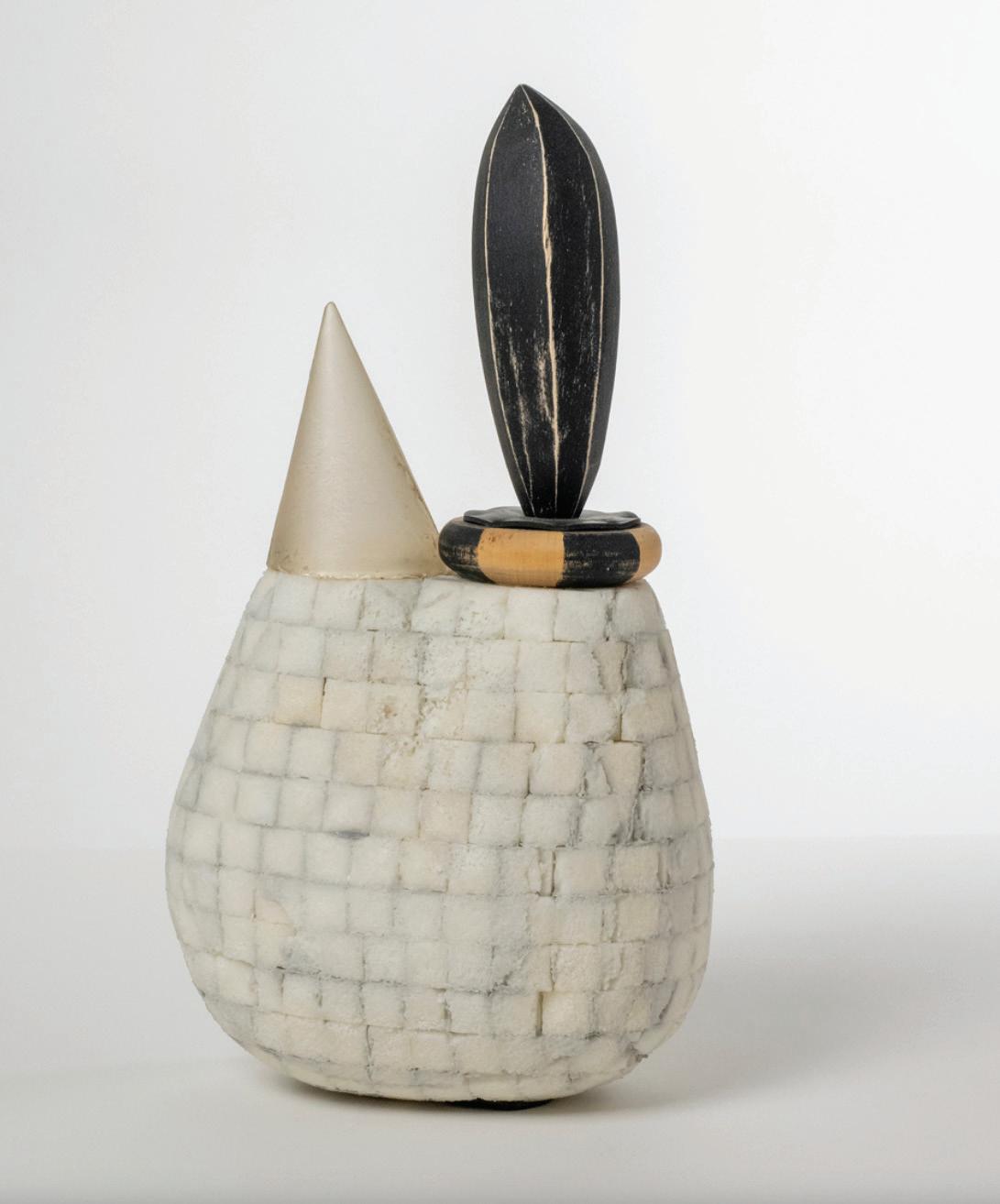
Dyer, Carrie A. The FL3TCH3R Exhibit Poster 2021. International Publication, Creative Quarterly No: 68, Winner, work, International Peer-reviewed Art & Design Publication, located in Brooklyn, NY, 2022.
Dyer, Carrie A. Artifact [Bold] Poster 2022. International Publication, Creative Quarterly No: 68, Runner-up, work,
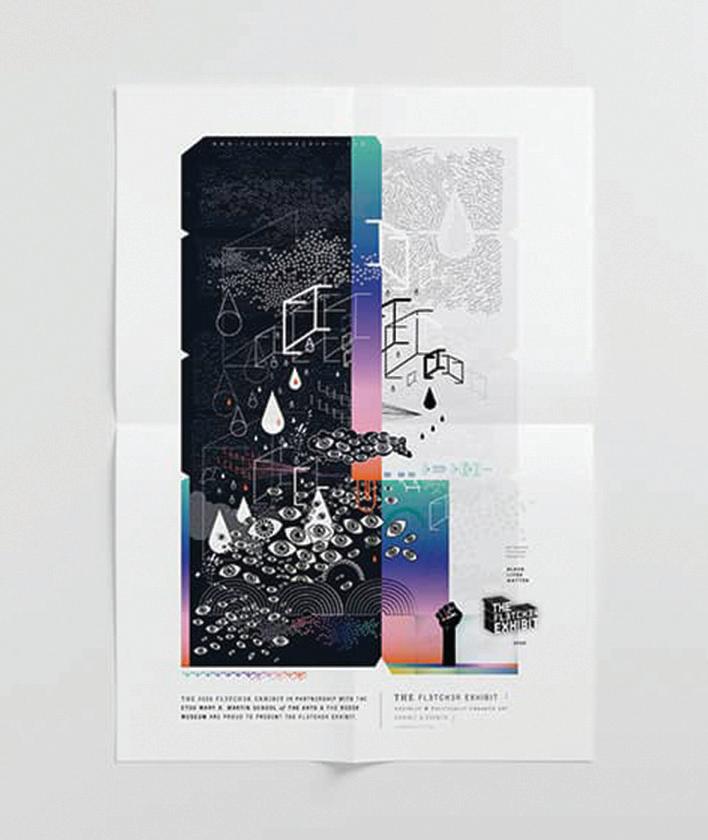
International Peer-reviewed Art & Design Publication, located in Brooklyn, NY, 2022.
Dyer, Carrie A. Systems. International Traveling group exhibition; 42nd Mini Print International of CADAQUES 2022; International Peerreviewed Traveling Exhibition to four locations: Cadaques, Spain; Wingfield, UK; Pineda De Mar, Spain; Bages, France; Juror/Committee: Peili Huang (Taiwan), Mariela Canchari (France), Marta Balada Monclús (Spain), Toshiaki Shozu (Japan); 2022; (Catalog).
Raynor, Scott. Full Moon. Gouache on Paper. Small Works Show, Cultural Center of Cape Cod, Yarmouth, MA. Juror: Molly Demeulenaere. December-January 2022-2023.
Raynor, Scott. Red Studio with Teapot. Ink on Paper. Seeing Red, A National Online Juried Competition, Art Fluent-Wanderlust. Juror: Amy Matteson Neill. June-September 2022.
50 The Lighted Lamp | 2023
Mark Brown, sugar, ash, resin, 10” X 7” X 5”
Carrie Dyer, “The FL3TCH3R EXHIBIT” poster, 2020
Raynor, Scott. Stocks. Acrylic Paint and Ink on Paper. A Tribute to Small Works, MVA Gallery, Modern Visual Arts. Juror: John D. Spiak. July, 2022.
Raynor, Scott. Tick. Ink on Paper. Multifarious, A Juried National Exhibition of Abstract Artworks. D’Art Center, Norfolk, VA. Juror: Rick Nickel. November 2022.
Shores, Bruce. “Presence: NC Figurative Artists,” (6 pieces exhibited). GreenHill Center for NC Art, Greensboro, NC. Curated by Edie Carpenter, Director, Artistic and Curatorial Programs. 2022.
PERFORMING
MacLeod, Scott R. “Because the Oceans” (recital). Foundation Prince Albert II de Monaco. Invited. 2022.
MacLeod, Scott R. “Because the Oceans” (recital). Washington National Gallery of Art. Invited. 2023.
MacLeod, Scott R. “Stars & Stripes” (featured soloist, various). North Carolina Symphony. 2022.
MacLeod, Scott R. Barone Douphol in “La Traviata,” by Giuseppe Verdi. Piedmont Opera. 2022.
MacLeod, Scott R. “The Polar Express” by Rob Kapilow. North Carolina Symphony. 2022.
MacLeod, Scott R., Chorus Master. “Manon Lescaut” by Giacomo Puccini, “Don Giovanni” by W. A. Mozart, and “Porgy and Bess” by George Gershwin. North Carolina Opera. 2022/2023.
VanWinkle, Benita. America. (20 pieces exhibited) Social Documentary Network, https://socialdocumentary.net/exhibit/Benita_ VanWinkle/6124 Juror: Glen Ruga, Executive Editor, ZEKE Magazine. November 2022.
VanWinkle, Benita. Feels Like Life Now. University of North Dakota, Grand Fork, ND. Juror: Cindy Steiler, Multidisciplinary artist and alternative process photographer, author, visiting artist at UND. October 2022.
VanWinkle, Benita. Indigo and Gold. Intersect Arts Gallery, St. Louis, MO. Juror: Sarah Bernhardt, artist, educator (U of Missouri), and administrator. January 2023.
Meixner, Brian. Conductor and Music Director, North Carolina Brass Band, “Signature Performance,” Eastern Music Festival, 2022.
Raymond-Kolker, Louis. “New Music for Steel Pan” (solo recital, world premiere of “TALOS” by Coral Douglas). Cornell University. Ithaca, NY. Invited. 2023.
Raymond-Kolker, Louis. “Summer Springs” (concertino for steelpan and orchestra). Soloist and composer. Appalachian State University. Boone, NC. Invited. 2023.
Raymond-Kolker, Louis. “A World of Our Creation” (metallic percussion septet). Performed by Jacksonville State University Percussion Ensemble. Percussive Arts Society International Convention. Indianapolis, IN. Invited. 2022.
51 www.highpoint.edu
GRANTS
Alcon, C., S. Wang-Price, and P. Laurienti. The Effect of Combining Pain Neuroscience Education and Transcranial Direct Current Stimulation on Pain Catastrophizing, Kinesiophobia, and Pain in Patients with Chronic Low Back Pain. Woodcock Institute for the Advancement of Neurocognitive Research and Applied Practice. Amount awarded: $15,000.
Bradley, Courtney L., Sun Lee, and Hannah Cozart. Communication in Employee Management: Assessment Rubric Development and Validation. American Association of Colleges of Pharmacy Scholarship of Teaching and Learning Grant. Amount awarded: $4,000.
Coover, Robert and Jwala Renukuntala. Targeting the RAC1 Pathway in Malignant Peripheral Nerve Sheath Tumors. North Carolina Biotechnology Center Flash Grant. Amount awarded: $21,000.
Fahrenholtz, Cale. Development of silverbased medicine for malignant peripheral nerve sheath tumors. North Carolina Biotechnology Center Flash Grant. Amount awarded: $27,500.

Ford, K. R., J. B. Taylor, B. Pexa. Dynamic Assessment of Women’s Soccer. adidas International, 2022-2023. Amount awarded: $51,875.
Goss, Don, H. Haltiwanger, N. Reilly, and M. Gonnella. Evaluation of Walking Gait, Golf Swing Mechanics, and Knee Joint Health in Golfers with and without a History of Knee Surgery. Quebec Ministry of Economy and Innovation, 2023. Amount awarded: $350,000.
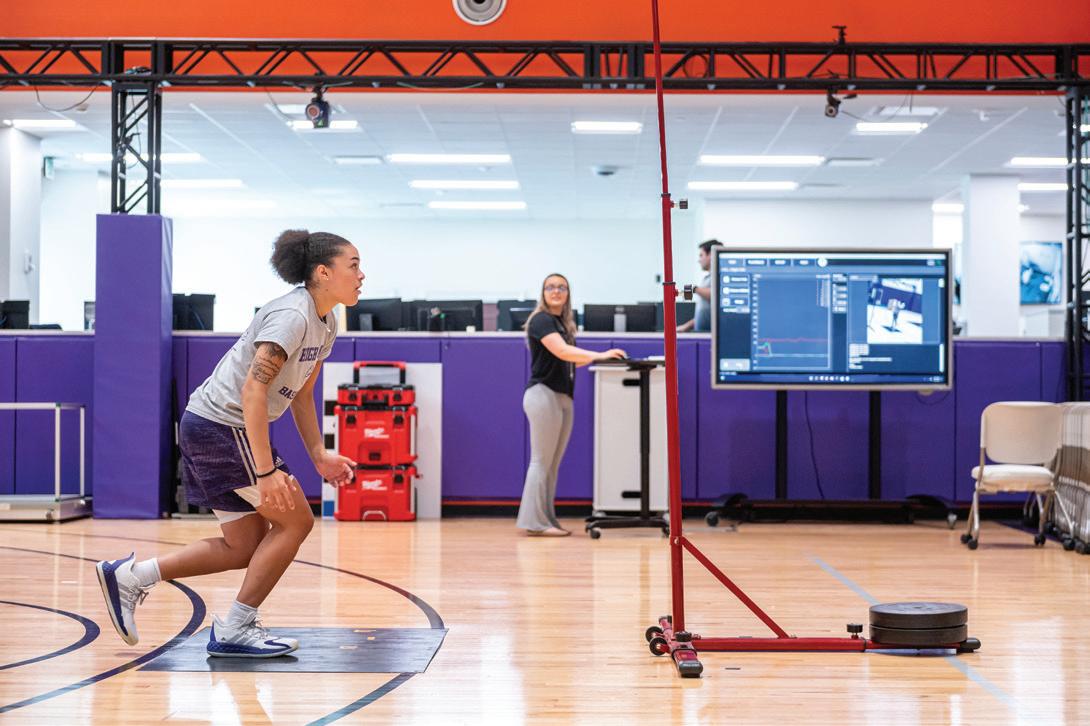
Hemby, Scott E. and Sames, Dalibor. Chemistry and Pharmacology of Iboga Alkaloids. National Institutes of Health grant no. 5R01DA050613. Amount awarded: $201,268.
Holcombe, Amy and Rachel Kinney. 20222027. U.S. Department of Education Teacher
Quality Partnership Grant. PREPARE+. Amount awarded: $9,413,362.
Holcombe, Amy, and Rachel Kinney. 20222025. U.S. Department of Education. ASCEND. Supporting Effective Educator Development Grant. Amount awarded: $10,390,282.
Holcombe, Amy. 2022-2023. North Carolina Department of Public Instruction. Special Education Teacher Support. Amount awarded: $100,000.
Holcombe, Amy. 2022-2024. University of North Carolina System. High Point University Leadership Academy. Amount awarded: $1,000,000.
Johnston, C., K. R. Ford, B. Pexa, K. Hierholzer, P. W. Kline. 2022. Strength and Compositional Changes Following a 4-Week Lower Extremity Protocol Utilizing Tonal’s Smart Flex Mode. Tonal Strength Institute, 2022. Amount awarded: $32,357.
52 The Lighted Lamp | 2023
Lundin, Pamela M., Briana L. Fiser, Meghan S. Blackledge, Synergistic Combination of Chemical Surface Treatments and Physical Patterning to Prevent Staphylococci Biofilm Formation on Silicone Catheters. North Carolina Biotechnology Center Flash Grant. Amount awarded: $27,000.
Miller, Heather B., Meghan S. Blackledge, Use of a novel tricyclic Stk1 inhibitor to uncover molecular mechanism in clinically relevant strains of S. aureus. National Institutes of Health Academic Research Enhancement Award (R15). Amount awarded: $436,960.
Renukuntala, Jwala and Bradley Clark. Design and development of a sensitive topical vancomycin gel delivery system to treat diabetic
AWARDS AND HONORS
McCullough, Claire, 2022. “Addressing Diversity in a Problem Based Learning Team Assignment,” Presentation at the American Society for Engineering Education
Southeastern Section Conference, Charleston, SC, March 13-14, 2022. Selected by the Technical Program Committee as Best Conference Paper.
Smoliga, James, 2022. Guy G. Simoneau Excellence in Research Award, Journal of Orthopedic and Sports Physical Therapy. https://www.jospt.org/doi/full/10.2519/ jospt.2022.11220.
EDITORS
Blackledge, Meghan S., Editor, Chemical Biology and Drug Design.
Setzler, Mark. Assistant Editor, The Latin Americanist.
foot ulcers. North Carolina Biotechnology Center Flash Grant. Amount awarded: $27,500.
Sarkar, Aurijit and Meghan Blackledge. New tools to help cure infective endocarditis. American Heart Association Institutional Research Enhancement Award. (Year 1 of 2-year project). Amount awarded: $77,000.
Sarkar, Aurijit, Robert Coover, and Cale Fahrenholtz. Establishing the Translational Potential of Aminopyrimidines as Penicillin Enhancers Against MRSA. North Carolina Biotechnology Center Flash Grant. Amount awarded: $27,500.
REVIEW BOARDS
Boateng Comfort, A. Special Emphasis Panel; 2023/05 NIDA-K S, National Institutes of Health /National Institute on Drug Abuse.
Boateng Comfort, A. Special Emphasis Panel; 2022/10 ZDA1 SKM-D (01) S, National Institutes of Health/National Institute on Drug Abuse.
Ford, K. R. ACSM Foundation Grant Panel, American College of Sports Medicine (ACSM) Research Review Committee, 2023.
Kline, Paul W. Grant Review Board, Musculoskeletal Rehabilitation Sciences Study Section, NIH 2023.
53 www.highpoint.edu
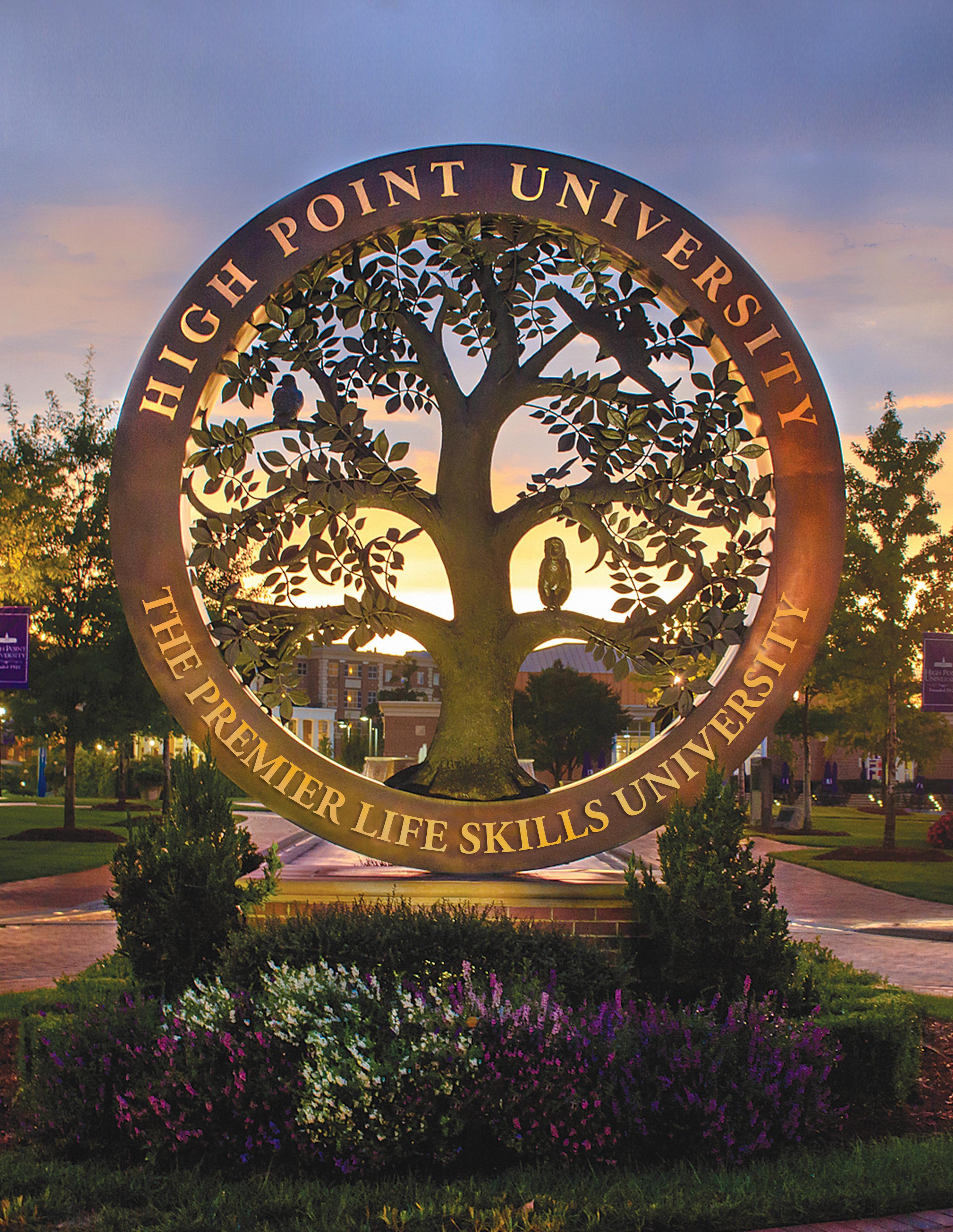


One University Parkway High Point, North Carolina 27268 www.highpoint.edu Nonprofit Org U.S. Postage PAID High Point, NC Permit #95











 Daniel Erb, PT, Ph.D. Provost
Daniel Erb, PT, Ph.D. Provost












































